Paul van Yperen's Blog, page 134
February 8, 2022
Yellow Submarine (1968)
Yellow Submarine (George Dunning, 1968) is an animated full-length film based on the music of The Beatles. It is also the title of the film's album of music, which is part of the Beatles' musical oeuvre. The film was directed by Canadian-born animation producer George Dunning, and produced by United Artists and King Features Syndicate. With over 200 employees, chief designer Heinz Edelmann and director Charles Dunning worked on the film for eleven months. The animators came from England, but also from the USA and other countries in Europe. The real Beatles themselves do not appear until the final scene of the film.

British postcard by London Postcard Company, no YS 5314 (Series 2 set of 9). Photo: Subafilms Ltd. Film image of The Yellow Submarine (George Dunning, 1968). Caption: Up on the hill.

British postcard by London Postcard Company, no YS 5314 (Series 2 set of 9). Photo: Subafilms Ltd. Film image of The Yellow Submarine (George Dunning, 1968). Caption: Up on the hill.

British postcard by London Postcard Company, no YS 5314 (Series 2 set of 9). Photo: Subafilms Ltd. Film image of The Yellow Submarine (George Dunning, 1968). Caption: Up on the hill.
A disappointing contract with United Artists
In 1963, the American film studio United Artists approached The Beatles ' manager Brian Epstein for a contract to make a number of films around the group. Epstein saw the deal as a good way to promote The Beatles and sell their music. United Artists was particularly interested in the money that would come in from selling the music albums. The Beatles were under contract to Capitol Records in the US, but that agreement excluded music albums. The studio knew that album sales would always make money even if the film flopped, so they saw the film deal as one in which they could not lose.
On the other hand, the deal United Artists made with Epstein was not very favourable to John Lennon, Paul McCartney, George Harrison, and Ringo Starr. Epstein was not a good negotiator and was an amateur in many financial matters. Admittedly, The Beatles were not at their peak of popularity at the time (certainly not in the US), but even in that context, it was a disappointing contract. He had no idea of the normal profit percentages that could be negotiated, so he proposed a 7.5 % share. The United Artists studio bosses couldn't believe their luck; they had been afraid of tough negotiations and perhaps a higher percentage than 25%, and now Epstein came up with the ludicrous 7.5%. They immediately made a deal for three films.
Not long after, the Beatles' popularity shot through the roof, also in the US, and Richard Lester made the first Beatles film A Hard Day's Night (Richard Lester, 1964) one of the most successful films of all time. This did not only deprive The Beatles of millions in earnings. They were also stuck with a financially disappointing film contract that would hang around their necks like a millstone.
The second film that The Beatles made for United Artists was Help (Richard Lester, 1965). Although the film was as successful as its predecessor, the Beatles were not very enthusiastic about the end result. They were afraid of getting stuck in the format of "the happy adventures of the Beatles". But Brian Epstein had signed a contract with United Artists in 1963, and the film production company demanded a third film.
All sorts of ideas were floated, such as a film adaptation of J.R.R. Tolkien's 'The Lord of the Rings' with Ringo as Frodo and John as Gandalf, but the third film did not materialise. In 1967, the four Beatles thought they could direct themselves and made the television production Magical Mystery Tour. The TV movie was broadcast by the BBC in black and white and was received by viewers and critics with dismay. After this, The Beatles' interest in films dropped to a low point.
Their manager Brian Epstein came up with the solution. He was approached by Al Brodax, the head of King Features Syndicate, with the idea of making a full-length animated film based on a number of Beatles songs. The idea was based on the animated series about The Beatles that had been broadcast since 1965. TVC produced this series, in which an animated adventure was always made around a Beatles song. The Beatles were excited because they did not have to contribute to the film. But for this very reason, United Artists rejected Yellow Submarine as the third film. It was only with the documentary Let it Be that the Beatles fulfilled their contractual obligations.
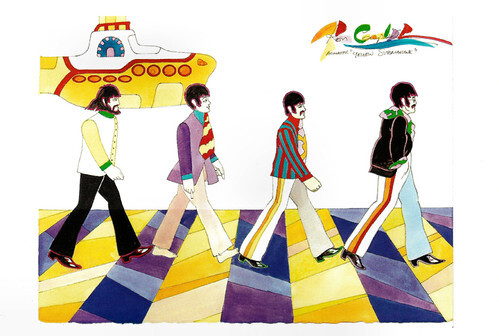
British postcard by London Postcard Company, no YS 5314 (Series 2 set of 9). Photo: Subafilms Ltd. Film image of The Yellow Submarine (George Dunning, 1968). Caption: Up on the hill.
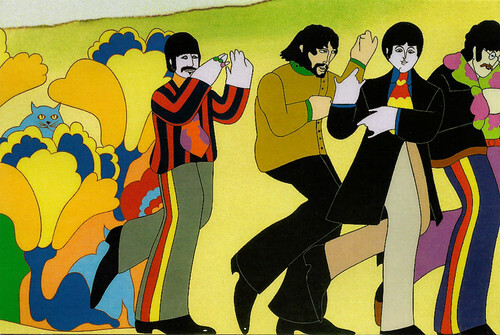
British postcard by London Postcard Company, no YS 5314 (Series 2 set of 9). Photo: Subafilms Ltd. Film image of The Yellow Submarine (George Dunning, 1968). Caption: Up on the hill.
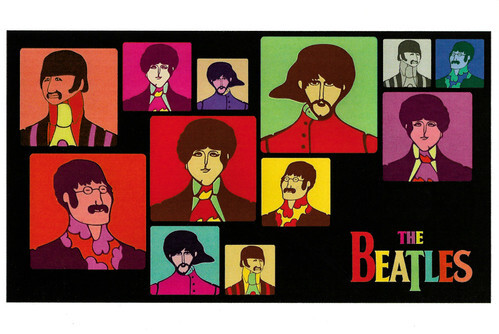
British postcard by London Postcard Company, no YS 5314 (Series 2 set of 9). Photo: Subafilms Ltd. Film image of The Yellow Submarine (George Dunning, 1968). Caption: Up on the hill.
A modern fairy tale about the 1967 hippy generation
Yellow Submarine (George Dunning, 1968) was a hit in cinemas and the critics were also enthusiastic. Roger Ebert: "This is a story that appeals even to young children, but it also has a knowing, funny style that adds an undertow of sophistication. The narration and dialogue are credited to four writers (including 'Love Story's Erich Segal), and yet the overall tone is the one struck by John Lennon in his books 'In His Own Write' and 'A Spaniard in the Works'. Puns, drolleries, whimsies, and asides meander through the sentences: "There's a cyclops! He's got two eyes. Must be a bicyclops. It's a whole bicloplopedia!" The animation isn't full motion and usually remains within one plane, but there's nothing stiff or limited about it; it has a freedom of color and invention that never tires, and it takes a delight in visual paradoxes."
The animation of Yellow Submarine was groundbreaking in 1967. Until then, animation had been fairly traditional and dominated by Disney Studios. In Yellow Submarine, we see a psychedelic style, full of colour and effects. The man responsible for this form of animation was the German designer Heinz Edelmann. Later, Peter Max would develop the psychedelic style Edelmann used for the film and become famous for it. For this reason, it is sometimes claimed that Max stood at the cradle of Yellow Submarine, but he had nothing to do with the film. Edelmann would also influence designer/director Terry Gilliam on his animations for the TV shows Do Not Adjust Your Set and Monty Python's Flying Circus.
With over 200 employees, chief designer Edelmann and director Charles Dunning worked on the film for eleven months. The animators came from England, but also from the USA and other countries in Europe. The drawn appearance of The Beatles was based on the appearance of the real Beatles at the time of the recording of the film that accompanied the single 'Strawberry Fields Forever'. Only, Paul McCartney's moustache had disappeared from his alter ego in the film. The Beatles themselves, who had expected some kind of Disney film, were pleasantly surprised by the result of Yellow Submarine and decided to appear in the final scene themselves.
The starting point for the film was the song 'Yellow Submarine'. Paul McCartney wrote it as one of the songs that drummer Ringo Starr could sing with his limited singing voice. It was intended as a children's song with simple lyrics and melody. Subsequent accusations that "yellow submarines" were a code name for yellow pills, namely Nembutol capsules, so-called "downers" (hence "submarine": submarine) were dismissed by McCartney.
Producer Lee Minoff based himself on the idea of a children's song and wrote the first draft of the story. Soon, several scriptwriters were working on the scenario. It was decided to include a number of recent Beatles songs alongside 'Yellow Submarine'. Some of these songs were taken from the album 'Sgt. Pepper's Lonely Hearts Club Band'. This Beatles album, released in 1967, caused a sensation in the music world. The idea behind the album was that The Beatles were transformed into the fictional pop group Sgt. Pepper's Lonely Heart Club Band. On the cover, they can be seen in satin military uniforms in bright colours.
This was the impetus for the idea of including in the film a Sgt. Pepper who lives in Pepperland with his band. At one point, there were about twenty versions of the screenplay circulating. One of the writers was Roger McCough, a poet from Liverpool, who contributed much to the dialogues with their typical ambiguities, expressions from Liverpool, and private jokes from The Beatles . McCough received 500 pounds for his contribution, but no mention in the credits.
Mention was made of Jack Mendelsohn and Erich Segal. Mendelsohn had worked on the Beatles' animated series, but Segal was unfamiliar with the film business in 1967. He was working at Yale as an assistant to the professor of Classics. He was brought to London by Brodax to put together a coherent script from the large amount of material, some of which consisted only of fragments. Segal worked on the script continuously for several weeks under the threat of a deadline. He was barely allowed to leave his hotel room to jog. However, Segal was able to take advantage of a brilliant suggestion by Heinz Edelmann.
During a production meeting, the collaborators came to a disturbing conclusion: the screenplay lacked an enemy. Pepperland was a paradise without a snake. Edelmann came up with the concept of the Blue Meanies and their attack on everything that smelt of music. Incidentally, the meanies were originally red, entirely in keeping with the Cold War. An error by Edelmann's assistant caused the colours to be switched and the meanies became blue. Despite all the creative contributions, Yellow Submarine's screenplay also suffered from the fact that the music overshadowed the story and the story was adapted to the songs. It did result in a modern fairy tale about the 1967 hippy generation.
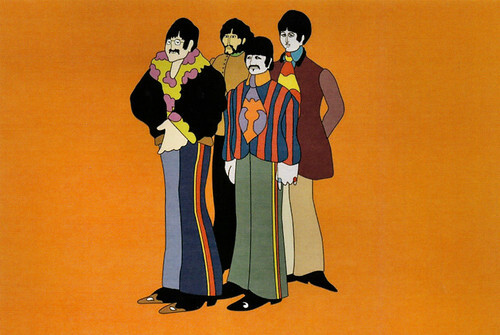
British postcard by London Postcard Company, no YS 5314 (Series 2 set of 9). Photo: Subafilms Ltd. Film image of The Yellow Submarine (George Dunning, 1968). Caption: Up on the hill.
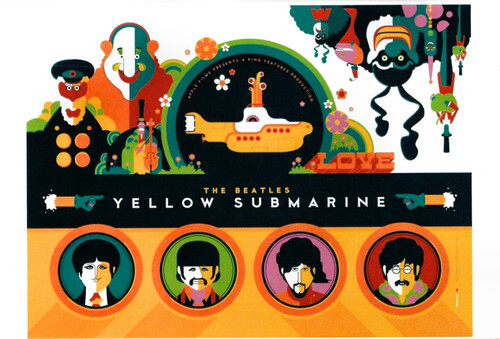
British postcard by London Postcard Company, no YS 5314 (Series 2 set of 9). Photo: Subafilms Ltd. Film image of The Yellow Submarine (George Dunning, 1968). Caption: Up on the hill.
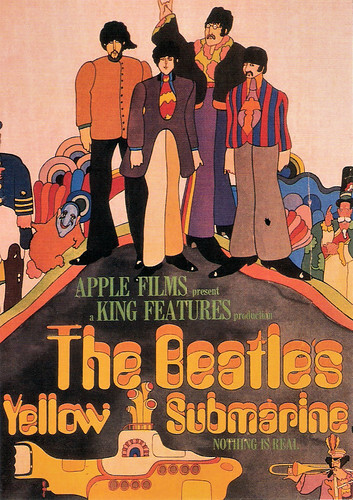
Italian postcard by Gruppo Editoriale Lo Vecchio, Genova. Picture: poster for The Yellow Submarine (George Dunning, 1968).
Source: Roger Ebert, Wikipedia (Dutch), and IMDb.

British postcard by London Postcard Company, no YS 5314 (Series 2 set of 9). Photo: Subafilms Ltd. Film image of The Yellow Submarine (George Dunning, 1968). Caption: Up on the hill.

British postcard by London Postcard Company, no YS 5314 (Series 2 set of 9). Photo: Subafilms Ltd. Film image of The Yellow Submarine (George Dunning, 1968). Caption: Up on the hill.

British postcard by London Postcard Company, no YS 5314 (Series 2 set of 9). Photo: Subafilms Ltd. Film image of The Yellow Submarine (George Dunning, 1968). Caption: Up on the hill.
A disappointing contract with United Artists
In 1963, the American film studio United Artists approached The Beatles ' manager Brian Epstein for a contract to make a number of films around the group. Epstein saw the deal as a good way to promote The Beatles and sell their music. United Artists was particularly interested in the money that would come in from selling the music albums. The Beatles were under contract to Capitol Records in the US, but that agreement excluded music albums. The studio knew that album sales would always make money even if the film flopped, so they saw the film deal as one in which they could not lose.
On the other hand, the deal United Artists made with Epstein was not very favourable to John Lennon, Paul McCartney, George Harrison, and Ringo Starr. Epstein was not a good negotiator and was an amateur in many financial matters. Admittedly, The Beatles were not at their peak of popularity at the time (certainly not in the US), but even in that context, it was a disappointing contract. He had no idea of the normal profit percentages that could be negotiated, so he proposed a 7.5 % share. The United Artists studio bosses couldn't believe their luck; they had been afraid of tough negotiations and perhaps a higher percentage than 25%, and now Epstein came up with the ludicrous 7.5%. They immediately made a deal for three films.
Not long after, the Beatles' popularity shot through the roof, also in the US, and Richard Lester made the first Beatles film A Hard Day's Night (Richard Lester, 1964) one of the most successful films of all time. This did not only deprive The Beatles of millions in earnings. They were also stuck with a financially disappointing film contract that would hang around their necks like a millstone.
The second film that The Beatles made for United Artists was Help (Richard Lester, 1965). Although the film was as successful as its predecessor, the Beatles were not very enthusiastic about the end result. They were afraid of getting stuck in the format of "the happy adventures of the Beatles". But Brian Epstein had signed a contract with United Artists in 1963, and the film production company demanded a third film.
All sorts of ideas were floated, such as a film adaptation of J.R.R. Tolkien's 'The Lord of the Rings' with Ringo as Frodo and John as Gandalf, but the third film did not materialise. In 1967, the four Beatles thought they could direct themselves and made the television production Magical Mystery Tour. The TV movie was broadcast by the BBC in black and white and was received by viewers and critics with dismay. After this, The Beatles' interest in films dropped to a low point.
Their manager Brian Epstein came up with the solution. He was approached by Al Brodax, the head of King Features Syndicate, with the idea of making a full-length animated film based on a number of Beatles songs. The idea was based on the animated series about The Beatles that had been broadcast since 1965. TVC produced this series, in which an animated adventure was always made around a Beatles song. The Beatles were excited because they did not have to contribute to the film. But for this very reason, United Artists rejected Yellow Submarine as the third film. It was only with the documentary Let it Be that the Beatles fulfilled their contractual obligations.

British postcard by London Postcard Company, no YS 5314 (Series 2 set of 9). Photo: Subafilms Ltd. Film image of The Yellow Submarine (George Dunning, 1968). Caption: Up on the hill.

British postcard by London Postcard Company, no YS 5314 (Series 2 set of 9). Photo: Subafilms Ltd. Film image of The Yellow Submarine (George Dunning, 1968). Caption: Up on the hill.

British postcard by London Postcard Company, no YS 5314 (Series 2 set of 9). Photo: Subafilms Ltd. Film image of The Yellow Submarine (George Dunning, 1968). Caption: Up on the hill.
A modern fairy tale about the 1967 hippy generation
Yellow Submarine (George Dunning, 1968) was a hit in cinemas and the critics were also enthusiastic. Roger Ebert: "This is a story that appeals even to young children, but it also has a knowing, funny style that adds an undertow of sophistication. The narration and dialogue are credited to four writers (including 'Love Story's Erich Segal), and yet the overall tone is the one struck by John Lennon in his books 'In His Own Write' and 'A Spaniard in the Works'. Puns, drolleries, whimsies, and asides meander through the sentences: "There's a cyclops! He's got two eyes. Must be a bicyclops. It's a whole bicloplopedia!" The animation isn't full motion and usually remains within one plane, but there's nothing stiff or limited about it; it has a freedom of color and invention that never tires, and it takes a delight in visual paradoxes."
The animation of Yellow Submarine was groundbreaking in 1967. Until then, animation had been fairly traditional and dominated by Disney Studios. In Yellow Submarine, we see a psychedelic style, full of colour and effects. The man responsible for this form of animation was the German designer Heinz Edelmann. Later, Peter Max would develop the psychedelic style Edelmann used for the film and become famous for it. For this reason, it is sometimes claimed that Max stood at the cradle of Yellow Submarine, but he had nothing to do with the film. Edelmann would also influence designer/director Terry Gilliam on his animations for the TV shows Do Not Adjust Your Set and Monty Python's Flying Circus.
With over 200 employees, chief designer Edelmann and director Charles Dunning worked on the film for eleven months. The animators came from England, but also from the USA and other countries in Europe. The drawn appearance of The Beatles was based on the appearance of the real Beatles at the time of the recording of the film that accompanied the single 'Strawberry Fields Forever'. Only, Paul McCartney's moustache had disappeared from his alter ego in the film. The Beatles themselves, who had expected some kind of Disney film, were pleasantly surprised by the result of Yellow Submarine and decided to appear in the final scene themselves.
The starting point for the film was the song 'Yellow Submarine'. Paul McCartney wrote it as one of the songs that drummer Ringo Starr could sing with his limited singing voice. It was intended as a children's song with simple lyrics and melody. Subsequent accusations that "yellow submarines" were a code name for yellow pills, namely Nembutol capsules, so-called "downers" (hence "submarine": submarine) were dismissed by McCartney.
Producer Lee Minoff based himself on the idea of a children's song and wrote the first draft of the story. Soon, several scriptwriters were working on the scenario. It was decided to include a number of recent Beatles songs alongside 'Yellow Submarine'. Some of these songs were taken from the album 'Sgt. Pepper's Lonely Hearts Club Band'. This Beatles album, released in 1967, caused a sensation in the music world. The idea behind the album was that The Beatles were transformed into the fictional pop group Sgt. Pepper's Lonely Heart Club Band. On the cover, they can be seen in satin military uniforms in bright colours.
This was the impetus for the idea of including in the film a Sgt. Pepper who lives in Pepperland with his band. At one point, there were about twenty versions of the screenplay circulating. One of the writers was Roger McCough, a poet from Liverpool, who contributed much to the dialogues with their typical ambiguities, expressions from Liverpool, and private jokes from The Beatles . McCough received 500 pounds for his contribution, but no mention in the credits.
Mention was made of Jack Mendelsohn and Erich Segal. Mendelsohn had worked on the Beatles' animated series, but Segal was unfamiliar with the film business in 1967. He was working at Yale as an assistant to the professor of Classics. He was brought to London by Brodax to put together a coherent script from the large amount of material, some of which consisted only of fragments. Segal worked on the script continuously for several weeks under the threat of a deadline. He was barely allowed to leave his hotel room to jog. However, Segal was able to take advantage of a brilliant suggestion by Heinz Edelmann.
During a production meeting, the collaborators came to a disturbing conclusion: the screenplay lacked an enemy. Pepperland was a paradise without a snake. Edelmann came up with the concept of the Blue Meanies and their attack on everything that smelt of music. Incidentally, the meanies were originally red, entirely in keeping with the Cold War. An error by Edelmann's assistant caused the colours to be switched and the meanies became blue. Despite all the creative contributions, Yellow Submarine's screenplay also suffered from the fact that the music overshadowed the story and the story was adapted to the songs. It did result in a modern fairy tale about the 1967 hippy generation.

British postcard by London Postcard Company, no YS 5314 (Series 2 set of 9). Photo: Subafilms Ltd. Film image of The Yellow Submarine (George Dunning, 1968). Caption: Up on the hill.

British postcard by London Postcard Company, no YS 5314 (Series 2 set of 9). Photo: Subafilms Ltd. Film image of The Yellow Submarine (George Dunning, 1968). Caption: Up on the hill.

Italian postcard by Gruppo Editoriale Lo Vecchio, Genova. Picture: poster for The Yellow Submarine (George Dunning, 1968).
Source: Roger Ebert, Wikipedia (Dutch), and IMDb.
Published on February 08, 2022 22:00
February 7, 2022
Tony Wright
British actor Tony Wright (1925-1986) was a popular leading man during the 1950s and nicknamed 'Britain's Mr. Beefcake'. He was a Rank Organisation contract player for some years and played the role of London-based private detective Slim Callaghan in four French films.
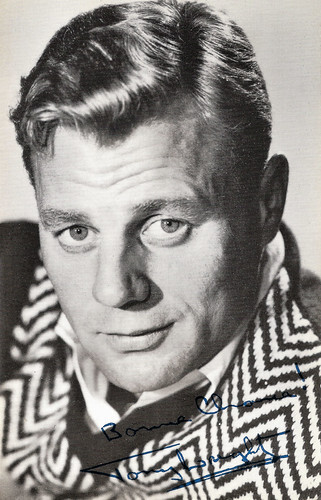
British postcard in the Celebrity Autograph Series, no. 268. Photo: J. Arthur Rank Film. Tony Wright in Tiger in the Smoke (Roy Ward Baker, 1956).
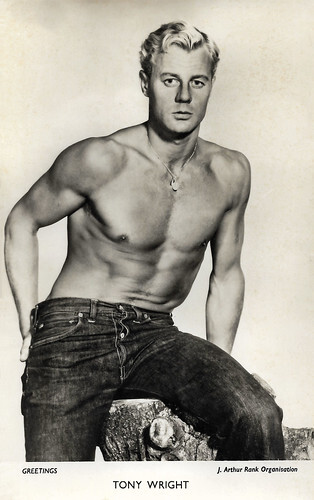
British postcard in the Greetings series. Photo: J. Arthur Rank Organisation.
A sexy, dangerous type
Paul Anthony 'Tony' Wright was born in London, in 1925. He was the son of French-born British actor and screenwriter Hugh E. Wright.
Tony worked as a whaler and then began his acting career in South African repertory theatre. In 1952, he made his screen debut in a BBC TV play, This Happy Breed (1952), based on a play by Noël Coward.
In the cinema, he played a sexy, dangerous type in The Flanagan Boy (Reginald Le Borg, 1953) lured by Hollywood 'Bad Blonde' Barbara Payton to do her dirty work. The film made the hunky blond actor a beefcake pin-up of the 1950s.
In France, he had success in the title role of the crime film À toi de jouer... Callaghan!!!/Amazing Mr. Callaghan (Willy Rozier, 1955), based on a novel by Peter Cheney.
It was soon followed by Plus de whisky pour Callaghan!/No more whisky for Callaghan! (Willy Rozier, 1955) with Magali Vendeuil. The fame of these films would inspire the now proverbial phrase: "Bien joué Callaghan !" (Well done Callaghan!).
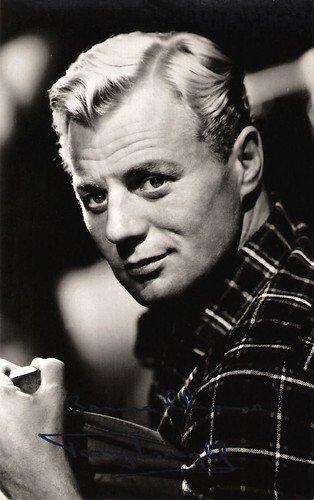
British autograph card by J. Arthur Rank Organisation.
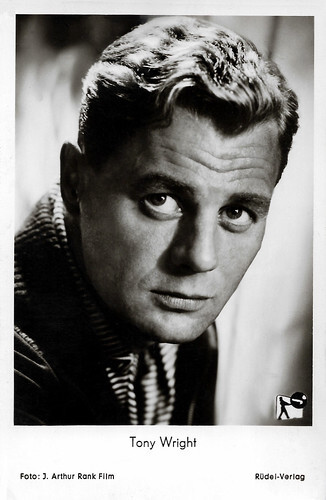
West-German postcard by Rüdel-Verlag, Hamburg-Bergedorf, no. 2095. Photo: J. Arthur Rank Organisation. Tony Wright in Tiger in the Smoke (Roy Ward Baker, 1956).
Callaghan does it again
Tony Wright was contracted by the Rank Organisation and appeared in the Frankie Howerd comedy Jumping for Joy (John Paddy Carstairs, 1956) and a series of mediocre crime films.
He returned as Callaghan in the French films Et par ici la sortie/And Through Here the Exit (Willy Rozier, 1957), with Dominique Wilms , and Callaghan remet ça/Callaghan does it again (Willy Rozier, 1961) opposite Geneviève Kervine .
Wright met actress Janet Munro in the Kismet Club. When they married in January 1957, they held a mock wedding for photographers only. They moved into a three-room flat in London's Shepherd's Bush and divorced two years later. In 1962, he married Shirley Clark, the daughter of writer Lesley Storm.
During the 1960s he worked mostly for television and guest-starred in such popular series as The Avengers (1968) and The Saint (1962-1968). Later he only played small roles in such B films as Clinic Exclusive (Don Chaffey, 1971) and The Creeping Flesh (Freddie Francis, 1973) starring Christopher Lee .
His final screen appearance was a bit role in the TV series Don't Wait Up (1983). Tony Wright passed away in 1986 in Wandsworth, London, in the aftermath of falling. He was 60. Wright was cremated at Putney Vale Crematorium.
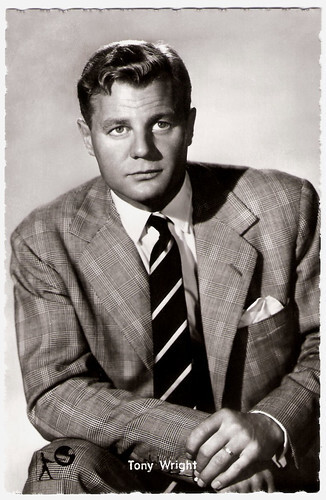
German postcard by Kolibri-Verlag G.m.b.H., Minden/Westf., no. 2820. Photo: J. Arthur Rank Film. Tony Wright in Tiger in the Smoke (Roy Ward Baker, 1956).
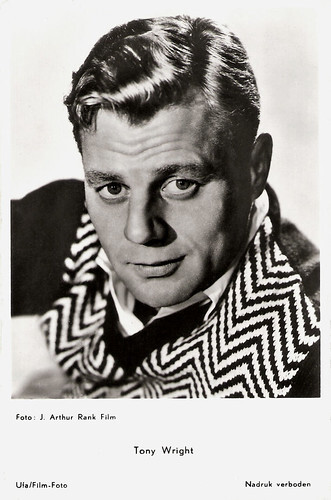
Dutch postcard. Photo: J. Arthur Rank Film / Ufa/Film-Foto.
Sources: Wikipedia (English and French), and .

British postcard in the Celebrity Autograph Series, no. 268. Photo: J. Arthur Rank Film. Tony Wright in Tiger in the Smoke (Roy Ward Baker, 1956).

British postcard in the Greetings series. Photo: J. Arthur Rank Organisation.
A sexy, dangerous type
Paul Anthony 'Tony' Wright was born in London, in 1925. He was the son of French-born British actor and screenwriter Hugh E. Wright.
Tony worked as a whaler and then began his acting career in South African repertory theatre. In 1952, he made his screen debut in a BBC TV play, This Happy Breed (1952), based on a play by Noël Coward.
In the cinema, he played a sexy, dangerous type in The Flanagan Boy (Reginald Le Borg, 1953) lured by Hollywood 'Bad Blonde' Barbara Payton to do her dirty work. The film made the hunky blond actor a beefcake pin-up of the 1950s.
In France, he had success in the title role of the crime film À toi de jouer... Callaghan!!!/Amazing Mr. Callaghan (Willy Rozier, 1955), based on a novel by Peter Cheney.
It was soon followed by Plus de whisky pour Callaghan!/No more whisky for Callaghan! (Willy Rozier, 1955) with Magali Vendeuil. The fame of these films would inspire the now proverbial phrase: "Bien joué Callaghan !" (Well done Callaghan!).

British autograph card by J. Arthur Rank Organisation.

West-German postcard by Rüdel-Verlag, Hamburg-Bergedorf, no. 2095. Photo: J. Arthur Rank Organisation. Tony Wright in Tiger in the Smoke (Roy Ward Baker, 1956).
Callaghan does it again
Tony Wright was contracted by the Rank Organisation and appeared in the Frankie Howerd comedy Jumping for Joy (John Paddy Carstairs, 1956) and a series of mediocre crime films.
He returned as Callaghan in the French films Et par ici la sortie/And Through Here the Exit (Willy Rozier, 1957), with Dominique Wilms , and Callaghan remet ça/Callaghan does it again (Willy Rozier, 1961) opposite Geneviève Kervine .
Wright met actress Janet Munro in the Kismet Club. When they married in January 1957, they held a mock wedding for photographers only. They moved into a three-room flat in London's Shepherd's Bush and divorced two years later. In 1962, he married Shirley Clark, the daughter of writer Lesley Storm.
During the 1960s he worked mostly for television and guest-starred in such popular series as The Avengers (1968) and The Saint (1962-1968). Later he only played small roles in such B films as Clinic Exclusive (Don Chaffey, 1971) and The Creeping Flesh (Freddie Francis, 1973) starring Christopher Lee .
His final screen appearance was a bit role in the TV series Don't Wait Up (1983). Tony Wright passed away in 1986 in Wandsworth, London, in the aftermath of falling. He was 60. Wright was cremated at Putney Vale Crematorium.

German postcard by Kolibri-Verlag G.m.b.H., Minden/Westf., no. 2820. Photo: J. Arthur Rank Film. Tony Wright in Tiger in the Smoke (Roy Ward Baker, 1956).

Dutch postcard. Photo: J. Arthur Rank Film / Ufa/Film-Foto.
Sources: Wikipedia (English and French), and .
Published on February 07, 2022 22:00
February 6, 2022
Stewart Granger
English actor Stewart Granger (1913–1993) made over 60 films but is mainly associated with heroic and romantic leading roles. Tall, handsome, and athletic, Granger became England's top box office star in the Gainsborough melodramas of the 1940s. This attracted Hollywood's attention.
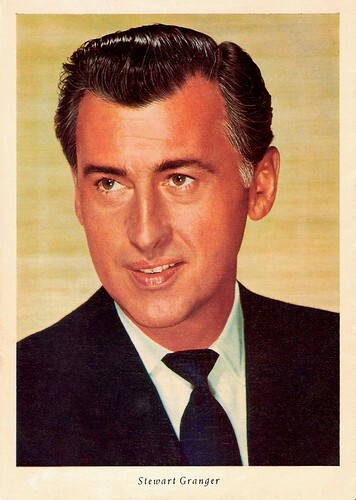
German postcard by Wilhelm Schulze-Witteborg, Wanne-Eickel. Photo: Metro Goldwyn Mayer.
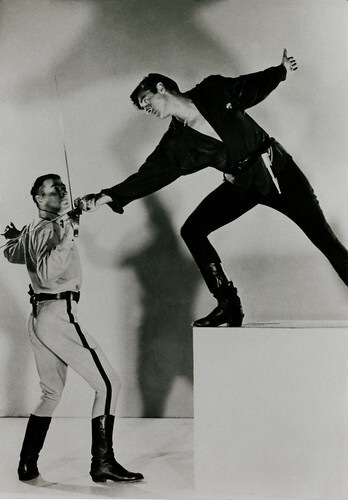
Vintage photo. Photo: Metro-Goldwyn-Mayer. Stewart Granger and James Mason (left) in The Prisoner of Zenda (Richard Thorpe, 1952).
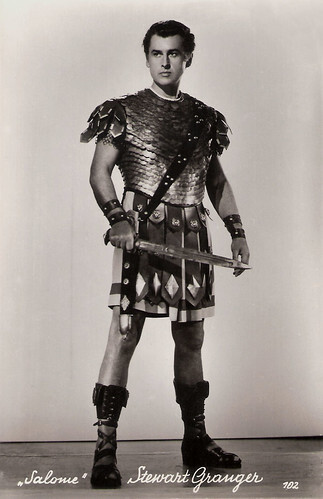
Austrian postcard by Verlag Hubmann (HDH), Wien, no. 102. Photo: Columbia. Stewart Granger in Salome (William Dieterle, 1953).
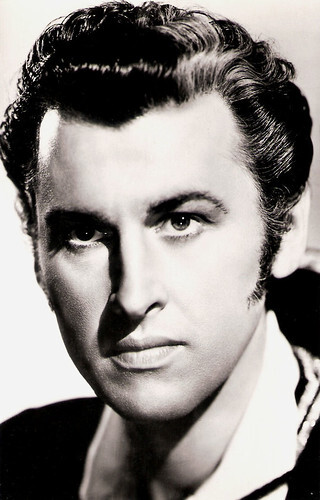
Vintage postcard.
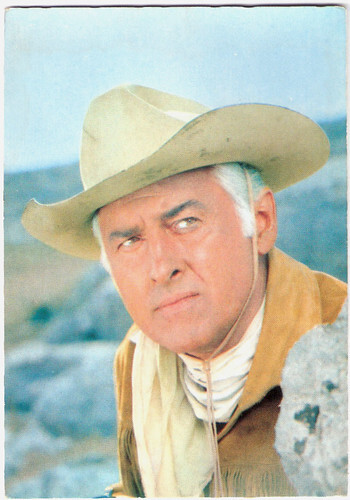
German postcard by ISV, no. C 3. Photo: Constantin. Stewart Granger as Old Surehand in Unter Geiern/Among Vultures (Alfred Vohrer, 1964).
Jimmy Stewart
Stewart Granger was born as James Lablache Stewart in London in 1913 He was the only son of Major James Stewart, OBE, and his wife Frederica Eliza née Lablache, and the grandson of the actor Luigi Lablache.
He was educated at Epsom College and the Webber Douglas Academy of Dramatic Art. He changed his name to avoid confusion with Hollywood star James Stewart . Granger was his Scottish grandmother's maiden name.
In 1933, he made his film debut as an extra in A Southern Maid (Harry Hughes, 1933) and by 1935 he made his stage debut in 'The Cardinal at Hull'. He was with the Birmingham Repertory Company between 1936 and 1937, and in 1938 he made his West End debut in 'The Sun Never Sets'.
He had been gradually rising through the ranks of better stage roles when WW II began, and he joined the British Army in 1940. However, he was eventually disabled in 1942, which brought his release from military service.
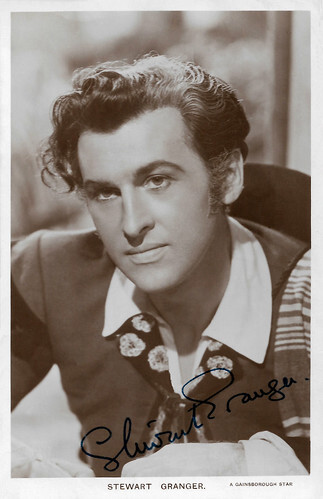
British postcard. Photo: Gainsborough. Stewart Granger in Caravan (Arthur Crabtree, 1946).
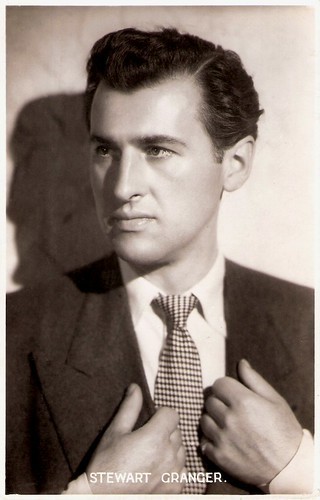
British Postcard, nr. F.S. 31. Publicity card for Saraband for Dead Lovers (Basil Dearden, 1948).
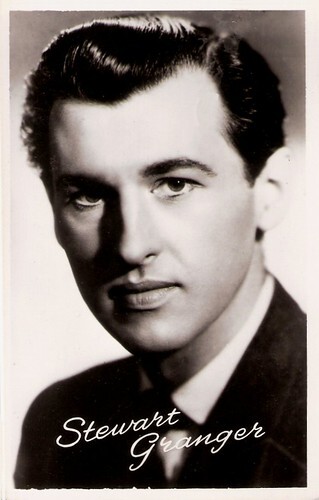
Dutch postcard by Takken, Utrecht, nr. 401.
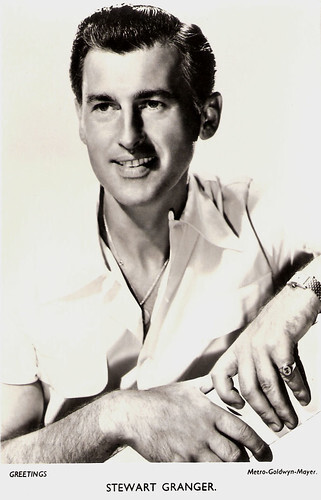
British postcard in the Greetings Series, Photo: MGM. (Metro-Goldwyn-Mayer).
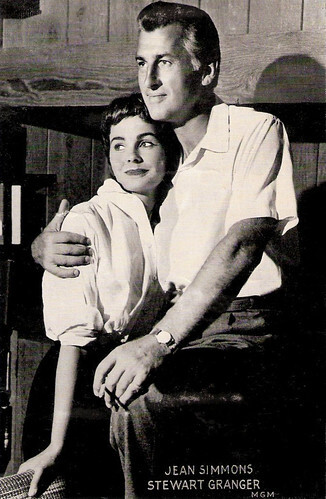
With Jean Simmons . Vintage postcard. Photo: MGM.
Dashing Hero Type
With a dearth of leading men for British films, Stewart Granger quickly landed The Man in Grey (Leslie Arliss, 1943). This was the first installment of Gainsborough’s successful series of costume melodramas.
His first starring role made him overnight a star in Britain. Next, he starred in films like Madonna of the Seven Moons (Arthur Crabtree, 1943) with Phyllis Calvert , but the film work was unsatisfying.
He was often cast as the dashing hero type, while fellow up-and-coming actor James Mason always garnered the more substantial Gainsborough part. When Mason left for Hollywood, Granger inherited better parts in films like Caesar and Cleopatra (Gabriel Pascal, 1945) and Saraband for Dead Lovers (Basil Dearden, 1948).
Granger first met the very young Jean Simmons when they both worked on Caesar and Cleopatra (1945). Three years on, Simmons had transformed from a promising newcomer into a star - and a very attractive woman.
They married in 1950 in a bizarre wedding ceremony organised by Howard Hughes - one of his private planes flew the couple to Tucson, Arizona, where they were married, mainly among strangers, with Michael Wilding as Granger's best man. Then, Granger and Simmons both moved to Hollywood.
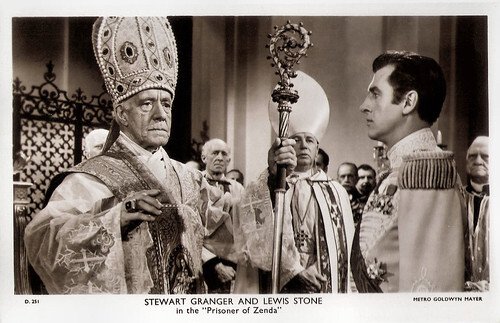
British postcard in the Picturegoer Series, London, no. D. 251. Photo: Metro-Goldwyn-Mayer. Stewart Granger and Lewis Stone (left) in The Prisoner of Zenda (Richard Thorpe, 1952).

British postcard on the Picturegoer Series, London, no. D 252. Photo: Metro-Goldwyn-Mayer. Stewart Granger and Deborah Kerr in The Prisoner of Zenda (Richard Thorpe, 1952).
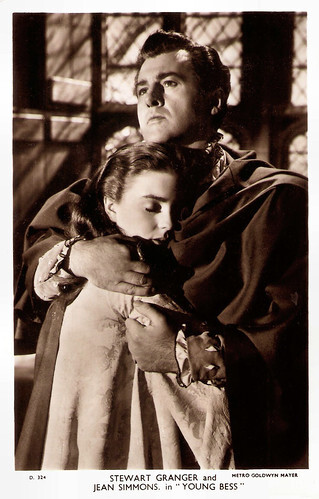
British postcard in the Picturegoer series, no. D. 324. Photo: Metro Goldwyn Mayer (MGM). Publicity still for Young Bess (George Sidney, 1953) with Jean Simmons .
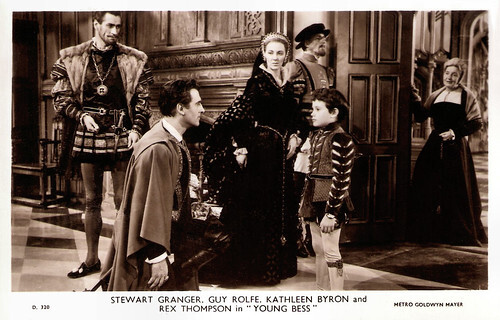
British postcard in the Picturegoer series, no. D. 320. Photo: Metro Goldwyn Mayer (MGM). Publicity still for Young Bess (George Sidney, 1953) with Guy Rolfe, Kathleen Byron, and Rex Thompson.
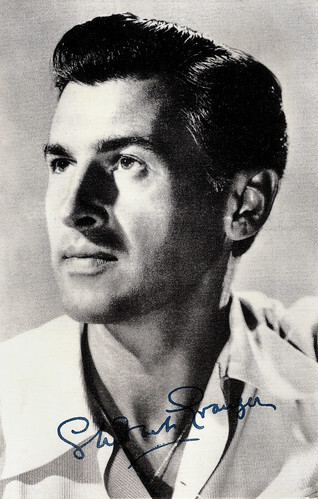
British postcard in the Film Star Autograph Portrait Series, by L.D. LTD., London, no. 122. Photo: M.G.M. Stewart Granger in Young Bess (George Sidney, 1953).
Swashbuckler
MGM had invited Stewart Granger to play Rider Haggard's hero Allan Quatermain in a film version of King Solomon's Mines (Compton Bennett, Andrew Morton, 1950) with Deborah Kerr . On the basis of the huge success of this film, he was offered a seven-year contract by MGM.
His theatrical voice, stature, and dignified profile made him a natural heir to Errol Flynn as a swashbuckler in the popular remakes of The Prisoner of Zenda (Richard Thorpe, 1952) and Scaramouche (George Sidney, 1952), and in Moonfleet (Fritz Lang, 1955).
The audience loved those romantic roles, but he found them still unsatisfying. He and Jean Simmons were paired in Young Bess (George Sidney, 1953), where Granger had the romantic lead, but Simmons was the focus of the film. That sort of undeclared competition was poison to their marriage.
They also co-starred in the underrated 'Victorian' thriller, Footsteps in the Fog (Arthur Lubin, 1955). In 1960 they divorced. That year Granger starred with John Wayne in the comic Western North to Alaska (Henry Hathaway, 1960). It would be the last Hollywood film he made.

Vintage postcard. Photo: Columbia. Charles Laughton , Rita Hayworth , and Stewart Granger in Salome (William Dieterle, 1953).

Spanish postcard. Photo: Columbia. Rita Hayworth , and Stewart Granger in Salome (William Dieterle, 1953).
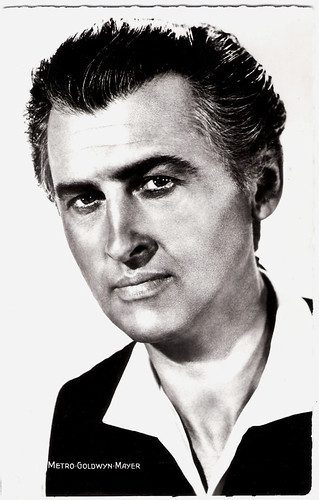
French postcard by Editions du Globe, no. 512. Photo: M.G.M. (Metro-Goldwyn-Mayer). Stewart Granger in Moonfleet (Fritz Lang, 1955).
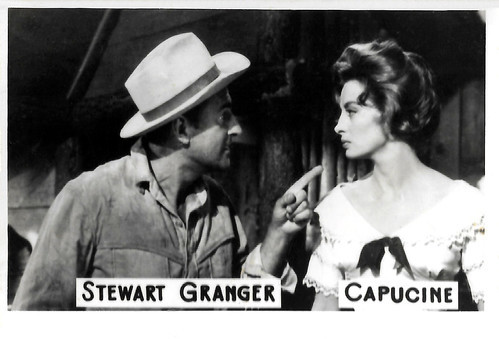
Small Romanian collectors card. Stewart Granger and Capucine in North to Alaska (Henry Hathaway, 1960).
Old Surehand
In Italy, Stewart Granger appeared in a comic pastiche on The Longest Day, Il giorno più corto/The Shortest Day (Sergio Corbucci, 1962), and in another good war film, Marcia o crepa/Commando (Frank Wisbar, 1962).
In Germany, he played Old Surehand next to Pierre Brice ’s Winnetou in three Karl May Westerns, Unter Geiern/Among Vultures (Alfred Vohrer, 1964), Der Ölprinz/Rampage at Apache Wells (Harald Philipp, 1965), and Old Surehand/Flaming Frontier (Alfred Vohrer, 1965).
In the Edgar Wallace film series of the 1960s, he was seen in The Trygon Factor (Cyril Frankel, 1966).
His film career declined in the 1970s, and he later worked mainly for American television. One of his last roles was as Prince Philip in the TV film The Royal Romance of Charles and Diana (Peter Levin, 1982). Towards the end of his career, Granger even starred in a German soap opera called Das Erbe der Guldenburgs/The Heritage of the Guldenburgs (Jürgen Goslar, 1987).
In 1956 Stewart Granger had become a naturalized citizen of the USA, and in 1993 he died in Santa Monica from prostate cancer at the age of 80. He was married three times: to Elspeth March (1938–1948), two children, Jamie and Lindsay; to Jean Simmons (1950–1960), one daughter, Tracy; and to Caroline LeCerf (1964–1969), one daughter, Samantha.
In his autobiography Sparks fly upward (1981) he revealed that Deborah Kerr had tried to seduce him in the back of a London cab in 1950. Although they were married to others, they went on to have an affair and remained lifelong friends.
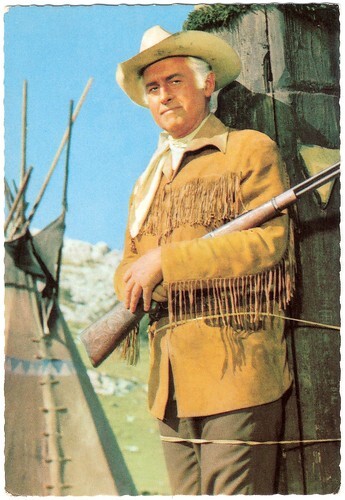
German postcard, no. 37. Photo: Constantin. Publicity still for Unter Geiern/Among Vultures (Alfred Vohrer, 1964).
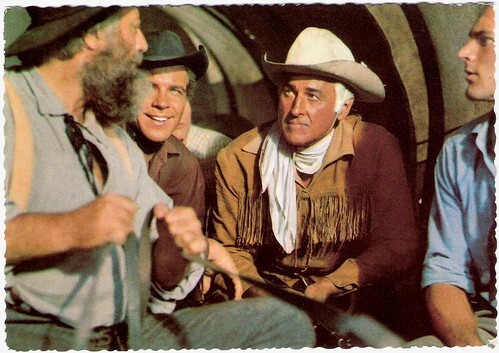
German postcard by ISV, no. C 11. Photo: Constantin. With Götz George and Mario Girotti a.o. in Unter Geiern/Among Vultures (Alfred Vohrer, 1964).
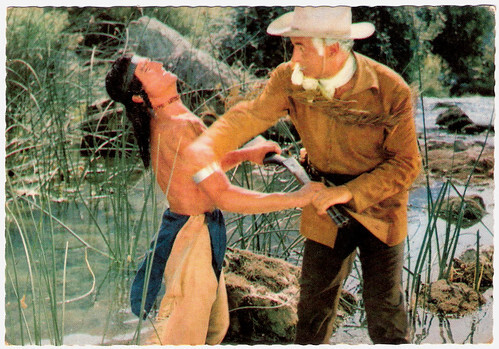
German postcard, no. 28. Photo: Constantin. Stewart Granger as Old Surehand in Unter Geiern/Among Vultures (Alfred Vohrer, 1964).
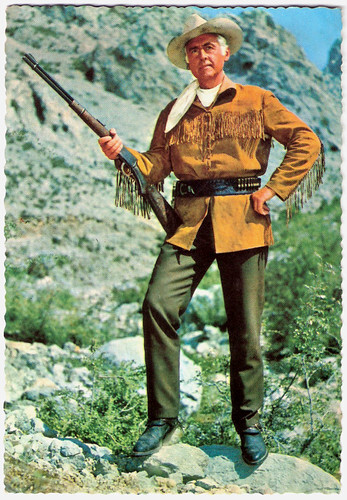
German postcard by ISV, no. C 4. Photo: Constantin. Stewart Granger as Old Surehand in Unter Geiern/Among Vultures (Alfred Vohrer, 1964).
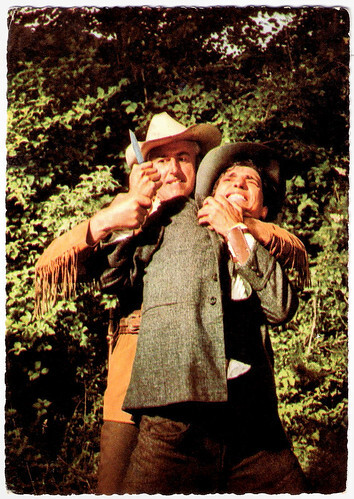
German postcard, no. 25. Photo: Rialto / Constantin. Stewart Granger as Old Surehand and Slobodan Dimitrijevic as Knife in Der Ölprinz/The Oil Prince (Harald Philipp, 1965). Caption: The battle swings back and forth. Then Old Surehand manages to wrest the knife from Knife and knocks him down with a punch. Now they have to get to the settlers' camp as quickly as possible in order to save them.
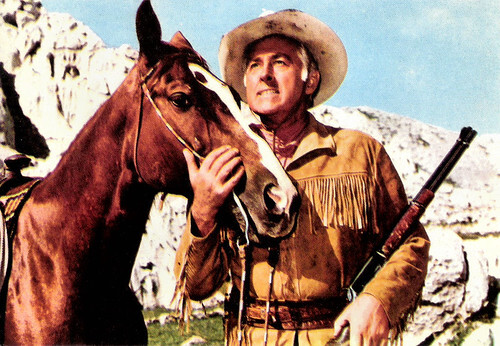
Italian postcard. Photo: Metro Goldwyn Mayer. Stewart Granger as Old Surehand in Old Surehand (Alfred Vohrer, 1965).
Sources: Tony Williams (Encyclopedia of British Cinema), and Wikipedia.

German postcard by Wilhelm Schulze-Witteborg, Wanne-Eickel. Photo: Metro Goldwyn Mayer.

Vintage photo. Photo: Metro-Goldwyn-Mayer. Stewart Granger and James Mason (left) in The Prisoner of Zenda (Richard Thorpe, 1952).

Austrian postcard by Verlag Hubmann (HDH), Wien, no. 102. Photo: Columbia. Stewart Granger in Salome (William Dieterle, 1953).

Vintage postcard.

German postcard by ISV, no. C 3. Photo: Constantin. Stewart Granger as Old Surehand in Unter Geiern/Among Vultures (Alfred Vohrer, 1964).
Jimmy Stewart
Stewart Granger was born as James Lablache Stewart in London in 1913 He was the only son of Major James Stewart, OBE, and his wife Frederica Eliza née Lablache, and the grandson of the actor Luigi Lablache.
He was educated at Epsom College and the Webber Douglas Academy of Dramatic Art. He changed his name to avoid confusion with Hollywood star James Stewart . Granger was his Scottish grandmother's maiden name.
In 1933, he made his film debut as an extra in A Southern Maid (Harry Hughes, 1933) and by 1935 he made his stage debut in 'The Cardinal at Hull'. He was with the Birmingham Repertory Company between 1936 and 1937, and in 1938 he made his West End debut in 'The Sun Never Sets'.
He had been gradually rising through the ranks of better stage roles when WW II began, and he joined the British Army in 1940. However, he was eventually disabled in 1942, which brought his release from military service.

British postcard. Photo: Gainsborough. Stewart Granger in Caravan (Arthur Crabtree, 1946).

British Postcard, nr. F.S. 31. Publicity card for Saraband for Dead Lovers (Basil Dearden, 1948).

Dutch postcard by Takken, Utrecht, nr. 401.

British postcard in the Greetings Series, Photo: MGM. (Metro-Goldwyn-Mayer).

With Jean Simmons . Vintage postcard. Photo: MGM.
Dashing Hero Type
With a dearth of leading men for British films, Stewart Granger quickly landed The Man in Grey (Leslie Arliss, 1943). This was the first installment of Gainsborough’s successful series of costume melodramas.
His first starring role made him overnight a star in Britain. Next, he starred in films like Madonna of the Seven Moons (Arthur Crabtree, 1943) with Phyllis Calvert , but the film work was unsatisfying.
He was often cast as the dashing hero type, while fellow up-and-coming actor James Mason always garnered the more substantial Gainsborough part. When Mason left for Hollywood, Granger inherited better parts in films like Caesar and Cleopatra (Gabriel Pascal, 1945) and Saraband for Dead Lovers (Basil Dearden, 1948).
Granger first met the very young Jean Simmons when they both worked on Caesar and Cleopatra (1945). Three years on, Simmons had transformed from a promising newcomer into a star - and a very attractive woman.
They married in 1950 in a bizarre wedding ceremony organised by Howard Hughes - one of his private planes flew the couple to Tucson, Arizona, where they were married, mainly among strangers, with Michael Wilding as Granger's best man. Then, Granger and Simmons both moved to Hollywood.

British postcard in the Picturegoer Series, London, no. D. 251. Photo: Metro-Goldwyn-Mayer. Stewart Granger and Lewis Stone (left) in The Prisoner of Zenda (Richard Thorpe, 1952).

British postcard on the Picturegoer Series, London, no. D 252. Photo: Metro-Goldwyn-Mayer. Stewart Granger and Deborah Kerr in The Prisoner of Zenda (Richard Thorpe, 1952).

British postcard in the Picturegoer series, no. D. 324. Photo: Metro Goldwyn Mayer (MGM). Publicity still for Young Bess (George Sidney, 1953) with Jean Simmons .

British postcard in the Picturegoer series, no. D. 320. Photo: Metro Goldwyn Mayer (MGM). Publicity still for Young Bess (George Sidney, 1953) with Guy Rolfe, Kathleen Byron, and Rex Thompson.

British postcard in the Film Star Autograph Portrait Series, by L.D. LTD., London, no. 122. Photo: M.G.M. Stewart Granger in Young Bess (George Sidney, 1953).
Swashbuckler
MGM had invited Stewart Granger to play Rider Haggard's hero Allan Quatermain in a film version of King Solomon's Mines (Compton Bennett, Andrew Morton, 1950) with Deborah Kerr . On the basis of the huge success of this film, he was offered a seven-year contract by MGM.
His theatrical voice, stature, and dignified profile made him a natural heir to Errol Flynn as a swashbuckler in the popular remakes of The Prisoner of Zenda (Richard Thorpe, 1952) and Scaramouche (George Sidney, 1952), and in Moonfleet (Fritz Lang, 1955).
The audience loved those romantic roles, but he found them still unsatisfying. He and Jean Simmons were paired in Young Bess (George Sidney, 1953), where Granger had the romantic lead, but Simmons was the focus of the film. That sort of undeclared competition was poison to their marriage.
They also co-starred in the underrated 'Victorian' thriller, Footsteps in the Fog (Arthur Lubin, 1955). In 1960 they divorced. That year Granger starred with John Wayne in the comic Western North to Alaska (Henry Hathaway, 1960). It would be the last Hollywood film he made.

Vintage postcard. Photo: Columbia. Charles Laughton , Rita Hayworth , and Stewart Granger in Salome (William Dieterle, 1953).

Spanish postcard. Photo: Columbia. Rita Hayworth , and Stewart Granger in Salome (William Dieterle, 1953).

French postcard by Editions du Globe, no. 512. Photo: M.G.M. (Metro-Goldwyn-Mayer). Stewart Granger in Moonfleet (Fritz Lang, 1955).

Small Romanian collectors card. Stewart Granger and Capucine in North to Alaska (Henry Hathaway, 1960).
Old Surehand
In Italy, Stewart Granger appeared in a comic pastiche on The Longest Day, Il giorno più corto/The Shortest Day (Sergio Corbucci, 1962), and in another good war film, Marcia o crepa/Commando (Frank Wisbar, 1962).
In Germany, he played Old Surehand next to Pierre Brice ’s Winnetou in three Karl May Westerns, Unter Geiern/Among Vultures (Alfred Vohrer, 1964), Der Ölprinz/Rampage at Apache Wells (Harald Philipp, 1965), and Old Surehand/Flaming Frontier (Alfred Vohrer, 1965).
In the Edgar Wallace film series of the 1960s, he was seen in The Trygon Factor (Cyril Frankel, 1966).
His film career declined in the 1970s, and he later worked mainly for American television. One of his last roles was as Prince Philip in the TV film The Royal Romance of Charles and Diana (Peter Levin, 1982). Towards the end of his career, Granger even starred in a German soap opera called Das Erbe der Guldenburgs/The Heritage of the Guldenburgs (Jürgen Goslar, 1987).
In 1956 Stewart Granger had become a naturalized citizen of the USA, and in 1993 he died in Santa Monica from prostate cancer at the age of 80. He was married three times: to Elspeth March (1938–1948), two children, Jamie and Lindsay; to Jean Simmons (1950–1960), one daughter, Tracy; and to Caroline LeCerf (1964–1969), one daughter, Samantha.
In his autobiography Sparks fly upward (1981) he revealed that Deborah Kerr had tried to seduce him in the back of a London cab in 1950. Although they were married to others, they went on to have an affair and remained lifelong friends.

German postcard, no. 37. Photo: Constantin. Publicity still for Unter Geiern/Among Vultures (Alfred Vohrer, 1964).

German postcard by ISV, no. C 11. Photo: Constantin. With Götz George and Mario Girotti a.o. in Unter Geiern/Among Vultures (Alfred Vohrer, 1964).

German postcard, no. 28. Photo: Constantin. Stewart Granger as Old Surehand in Unter Geiern/Among Vultures (Alfred Vohrer, 1964).

German postcard by ISV, no. C 4. Photo: Constantin. Stewart Granger as Old Surehand in Unter Geiern/Among Vultures (Alfred Vohrer, 1964).

German postcard, no. 25. Photo: Rialto / Constantin. Stewart Granger as Old Surehand and Slobodan Dimitrijevic as Knife in Der Ölprinz/The Oil Prince (Harald Philipp, 1965). Caption: The battle swings back and forth. Then Old Surehand manages to wrest the knife from Knife and knocks him down with a punch. Now they have to get to the settlers' camp as quickly as possible in order to save them.

Italian postcard. Photo: Metro Goldwyn Mayer. Stewart Granger as Old Surehand in Old Surehand (Alfred Vohrer, 1965).
Sources: Tony Williams (Encyclopedia of British Cinema), and Wikipedia.
Published on February 06, 2022 22:00
February 5, 2022
Editions Hazan
Editions Hazan in Paris remains one of the few publishing houses specialising in art books, with a production of quality content, as evidenced by several awards. In 1946, Fernand Hazan founded the publishing house, which is since 1992 part of the Hachette Group. Since 2017, it is a department of Hachette Livre. Apart from art books, Hazan also published several series of postcards through the years. The Collection Magie Noire is a series of postcards with black and white photos of great European film directors and scenes of film classics.
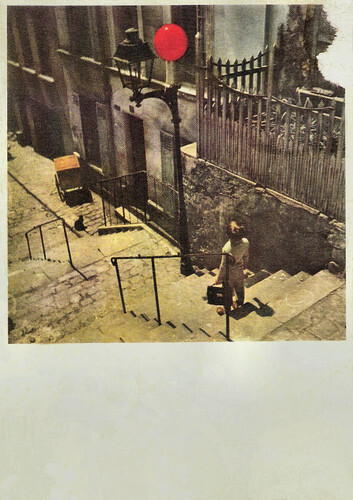
French postcard by F. Hazan Editeur, Paris, no. 1. Photo: Albert Lamorisse, 1956. Pascal Lamorisse in Le ballon rouge/The red balloon (Albert Lamorisse, 1956). Caption: "Decouverte de ballon". (Discovery of the balloon).
French child actor Pascal Lamorisse (1950) is known by film lovers all over the world because of his parts in the short films Crin blanc: Le cheval sauvage (1953) and Le ballon rouge (1956), both directed by his father, Albert Lamorisse.

French postcard by Fernand Hazan ed., Paris, no. 1605 C. French poster for the film Remorques (Jean Gremillon, 1941), starring Jean Gabin and Michèle Morgan . Design poster: Henry Monnier.

French postcard by Ed. Hazan, Paris. French poster for La bête humaine (Jean Renoir, 1938), starring Jean Gabin and Simone Simon .

French postcard by Éditions Hazan, Paris, 1996. Photo: Raymond Depardon / Magnum. Caption: Jean Seberg and Jean-Luc Godard after the shooting of À bout de souffle.
American actress Jean Seberg (1938-1979) became an icon of the Nouvelle Vague with her role in Godard’s A Bout de Souffle/Breathless (1960). She appeared in over 30 films in Hollywood and Europe.

French postcard by Éditions Hazan, Paris, no. 6007, 1988. Photo: Sam Levin, 1969. Federico Fellini on the set of Satyricon (1969).
Italian film director and screenwriter Federico Fellini (1920-1993) was one of the most influential filmmakers of all time. He was known for his distinct style that blends fantasy and baroque images with earthiness. In a career spanning almost fifty years, Fellini won the Palme d'Or for La Dolce Vita (1960), was nominated for twelve Academy Awards. He won an Oscar for La Strada (1954), Le notti di Cabiria (1957), 8½ (1963) and Amarcord (1973).
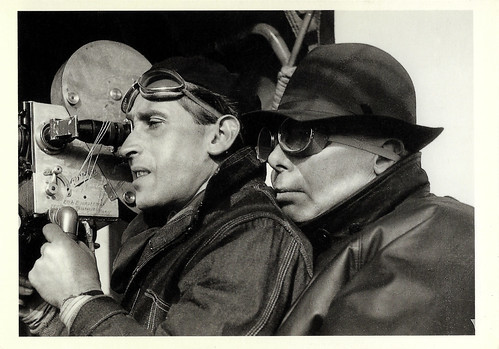
French postcard in the Collection Noire by Editions Hazan, Paris, no. 6011, 1988. Photo: Sam Levin. Jean Renoir at the set of La bête humaine/The Human Beast (1938).
Jean Renoir (1894-1979) was one of the major French film directors before WW II. His films La Grande Illusion/The Great Illusion (1937) and La Règle du Jeu/The Rules of the Game (1939) belong to the masterpieces of French cinema. During the German invasion of France in 1941, he moved to Hollywood where he directed This Land Is Mine (1943), and The Southerner (1945). He later became an American citizen.
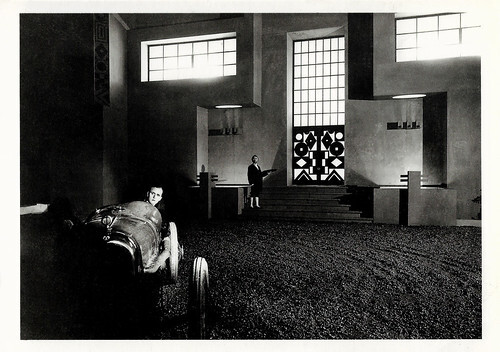
French postcard in the Collection Magie Noire by Editions Hazan, no. 6073, 1988. Photo: Madame L'Herbier / SPADEM, Paris. Jaque Catelain in L'inhumaine/The New Enchantment (Marcel L'Herbier, 1924). The exterior of the house of inventor Einar Norsen (Catelain) was designed by architect Robert Mallet-Stevens.
Jaque Catelain (1897-1965) was one of the most well-known faces of the French silent era. Catelain started in cinema with a film written by Marcel L'Herbier, Le Torrent (1917), after which he starred in L'Herbier's first completed film, Rose-France (1918). Catelain became Marcel L'Herbier's fixed actor in the silent era and starred in 12 of his silent films, including L'homme du large, Eldorado, L'Inhumaine and Feu Mattia Pascal.
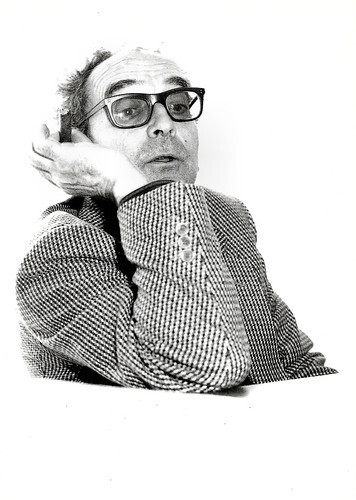
French postcard in the Collection Magie Noire by Éditions Hazan, Paris, 1988, no. 6077. Photo: Pierre-Olivier Deschamps / Agence Vu, Paris. Caption: Jean-Luc Godard , Mai 86.
Jean-Luc Godard (1930) is a French film director and screenwriter. He is one of the most important members of the Nouvelle Vague (New Wave). Godard first received global acclaim for his feature À bout de souffle/Breathless (1959), helping to establish the New Wave movement. Godard's films have inspired many directors including Martin Scorsese, Quentin Tarantino, Robert Altman, Rainer Werner Fassbinder, and Wong Kar-wai. He has been married twice, to actresses Anna Karina and Anne Wiazemsky, both of whom starred in several of his films.
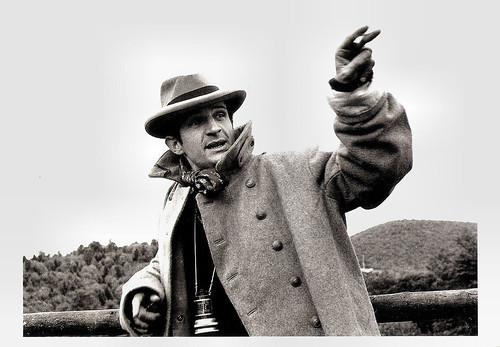
French postcard in the Collection Noire by Editions Hazan, Paris, no. 6109, 1989. Photo: Les films du Carosse, Paris. François Truffaut at the set of Jules et Jim (François Truffaut, 1961).
François Truffaut (1932-1984) was one of the most popular and successful French filmmakers ever. The French film director, screenwriter, producer, actor, and film critic was one of the founders of the Nouvelle Vague and his main themes were passion, women, childhood, and faithfulness. He created such classics as Les quatre cents coups/The 400 blows (1959), Jules et Jim (1961) and La Nuit Américaine/Day for Night (1973). His life and films were mixed up and one of his quotes is "Cinema is an improvement on life".
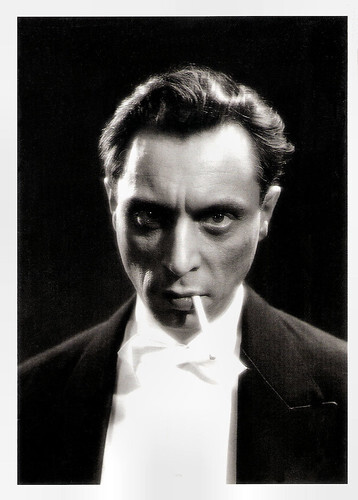
French postcard in the collection Magie Noire by Editions Hazan, Paris, 1990, no. 6218. Photo: Louis Jouvet in Les bas-fonds/Underground (Jean Renoir, 1936).
Louis Jouvet (1887-1951) was a living glory of the French theatre. He made a huge impact as both a stage director and an actor. His character, his eagle-like profile, and his unique way of speaking made him also an unforgettable film star who appeared in some of the masterpieces of the ‘poetical realism’, the Golden Age of the French cinema.
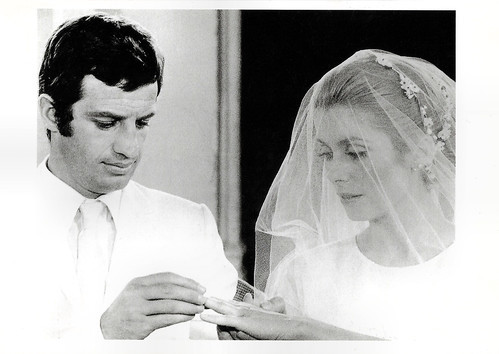
French postcard in the Collection Magie Noire by Éditions Hazan, Paris, no. 6247, 1991. Catherine Deneuve and Jean-Paul Belmondo in La Sirène du Mississipi/Mississippi Mermaid (François Truffaut, 1969).
Jean-Paul Belmondo (1933-2021) was a big comedy and action star in France from the mid-1960s till the mid-1980s, but he was initially associated with the Nouvelle Vague, the French New Wave of the 1960s. Despite his unconventional looks, including a broken nose, he was often polled as one of the sexiest men in the world. For nearly 50 years Belmondo remained one of the most popular and best-loved personalities in France.
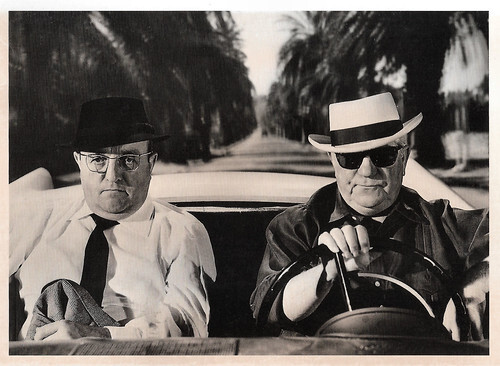
French postcard by Editions Hazan, Paris, 1991, no. 6251. Photo: Bernard Blier and Jean Gabin in Le cave se rebiffe/Money Money Money (Gilles Grangier, 1961).
Stocky, balding Bernard Blier (1916-1989) was one of France's most versatile and sought-after character actors. His complete filmography includes 138 titles, both comedies, and dramas, in France and in Italy.
French actor and war hero Jean Gabin (1904-1976) was one of the great stars of European cinema. In the 1930s, he became the personification of the tragic romantic hero of the poetic realist film. Whether he played the legionnaire (Gueule d'amour), the deserter (Le Quai des brumes), or the head gangster (Pépé le Moko), Gabin was impeccable, bringing tragic humanity to each of his appearances which the public adored. After the war, Gabin was reborn as a tough anti-hero, set in his beliefs, feared and respected by all, the Godfather of the French cinema.
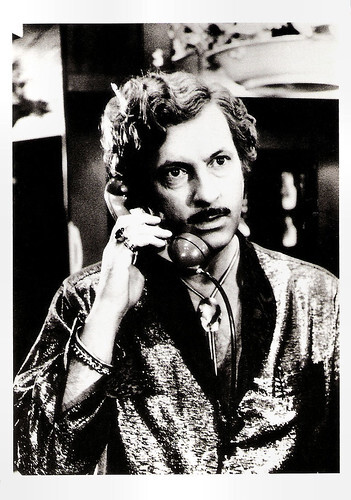
French postcard by Editions Hazan, Paris, no. 6274, 1991. Photo: Edimedia. Michel Serrault in Il lupo e l'agnello/The Wolf and the Lamb (Francesco Massaro, 1980).
French stage actor and film star Michel Serrault (1928-2007) appeared from 1954 to 2007 in more than 150 films. He is best known as Albin Mougeotte, alias the outrageous drag queen Zaza Napoli in the play and the film series La Cage aux Folles (The Bird Cage). In the following decades, the comedian also proved to be a noted dramatic film actor. He would win three Césars - the French version of the Oscar and became one of the grand old men of French cinema.
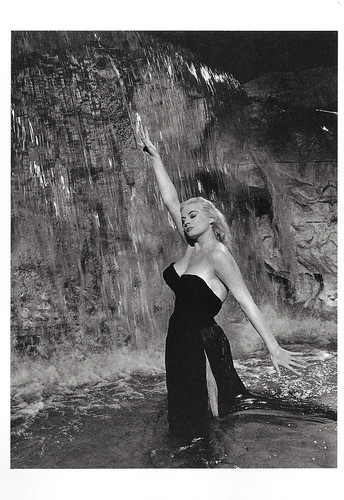
French postcard in the Collection Magie Noire by Editions Hazan, Paris, no. 6323. Anita Ekberg in La dolce vita (Federico Fellini, 1960).
Swedish (but naturalized Italian) film actress Anita Ekberg had a Hollywood career in the 1950s but got her real breakthrough in Italy. As Miss Sweden 1950, she was contracted by studio mogul Howard Hughes. In Rome, she made film history as the sensual, curvaceous film goddess who dances in the Trevi Fountain in Fellini’s La Dolce Vita (1960).
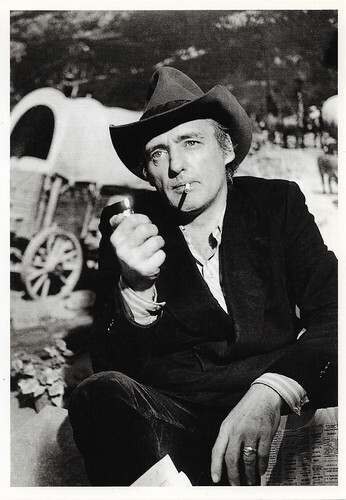
French postcard in the Collection Image Noire by Éditions Hazan, Paris, no. 6332, 1992. Photo: Catherine Faux.
Dennis Hopper (1936-2010) was a multi-talented American actor, director, and visual artist, but also one of the true 'enfants terribles' of Hollywood. In 1970, he won a Golden Palm for Easy Rider (1969) and Hopper was also Oscar-nominated for writing this groundbreaking anthem to freedom and rebellion. In 1987, he received a second nomination for his supporting role in Hoosiers (1986).
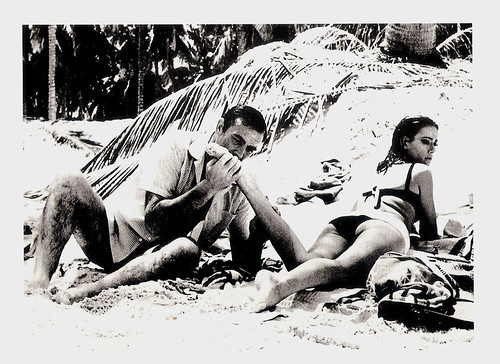
French postcard in the Collection Magie Noire by Editions Hazan, Paris, no. 6377, 1993. Photo: Claudine Auger and Sean Connery in Thunderball (Terence Young, 1966).
French actress Claudine Auger (1941-2019) was best known as Bond girl Domino in the James Bond film Thunderball (1965). At 17, she was Miss France 1958 and she became the first runner-up in the Miss World contest. Later she worked mostly in France and Italy.
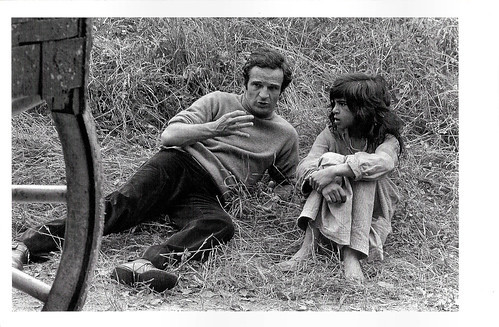
French postcard in the Collection Noire by Editions Hazan, Paris, no. 6429, 1994. Photo: Raymond Depardon / Magnum Photos. François Truffaut and Jean-Pierre Cargol on the set of L'Enfant sauvage (François Truffaut, 1969).
François Truffaut (1932-1984) was one of the most popular and successful French filmmakers ever. The French film director, screenwriter, producer, actor, and film critic was one of the founders of the Nouvelle Vague and his main themes were passion, women, childhood, and faithfulness. He created such classics as Les quatre cents coups/The 400 blows (1959), Jules et Jim (1961) and La Nuit Américaine/Day for Night (1973). His life and films were mixed up and one of his quotes is "Cinema is an improvement on life".
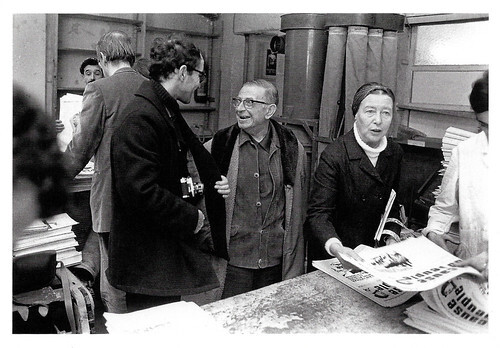
French postcard in the Collection Magie Noire by Éditions Hazan, Paris, 1994, no. 6430. Photo: Bruno Barbey / Magnum Photos. Jean-Luc Godard , Jean-Paul Sartre and Simone de Beauvoir, 1970.
Jean-Luc Godard (1930) is a French film director and screenwriter. He is one of the most important members of the Nouvelle Vague (New Wave). Godard first received global acclaim for his feature À bout de souffle/Breathless (1959), helping to establish the New Wave movement. Godard's films have inspired many directors including Martin Scorsese, Quentin Tarantino, Robert Altman, Rainer Werner Fassbinder, and Wong Kar-wai. He has been married twice, to actresses Anna Karina and Anne Wiazemsky, both of whom starred in several of his films.
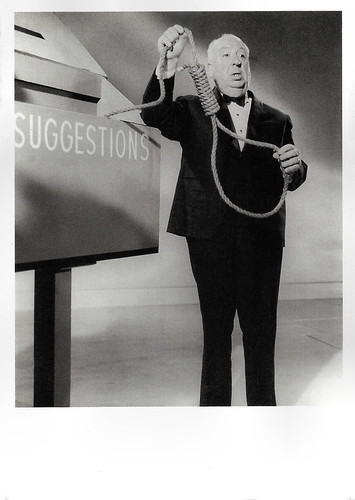
French postcard in the collection Magie Noire by Editions Hazan, no. 6489. Photo: Collection Dominique Lebrun D.R. Alfred Hitchcock promoting Rope (Alfred Hitchcock, 1948).
British director Alfred Hitchcock (1899-1980) was known as 'The Master of Suspense'. He is one of the most influential and extensively studied filmmakers in the history of cinema. He had his first major success with The Lodger (1926), a silent thriller loosely based on Jack the Ripper. Hitchcock came to international attention with The Man Who Knew Too Much (1934), The 39 Steps (1935), and, most notably, The Lady Vanishes (1938). His first Hollywood film was the multi-Oscar-winning psychological thriller Rebecca (1940). Many classics followed including Spellbound (1945), Notorious (1946), Rear Window (1954), North by Northwest (1959), and The Birds (1963). In a career spanning six decades, he directed over 50 feature films which garnered a total of 46 Oscar nominations and 6 wins.
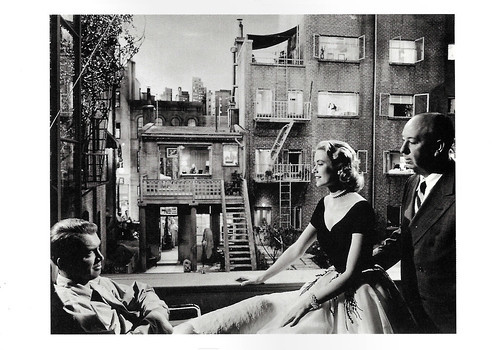
French postcard in the Collection Magie Noire nu Editions Hazan, Paris, no. 6490, 1996. James Stewart , Grace Kelly, and Alfred Hitchcock on the set of Rear Window (Alfred Hitchcock, 1954).
American actor James Stewart (1908-1997) is among the most honored and popular stars in film history. Known for his distinctive drawl and everyman screen persona, Stewart had a film career that spanned over 55 years and 80 films.
American actress Grace Kelly (1929-1982) had a brief but very successful Hollywood career. She was the sparkling, elegant heroine in three classic Alfred Hitchcock thrillers. Her talents rivaled her beauty, winning her the Best Actress Oscar for The Country Girl in 1954. After marrying Prince Rainier III in April 1956, she became Princess of Monaco and retired from the cinema.
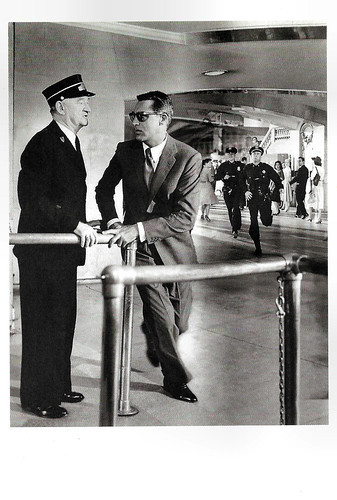
French postcard in the Collection Noire by Editions Hazan, Paris, no. 6492, 1996. Photo: Collection Dominque Lebrun D.R. Cary Grant in North by Northwest (Alfred Hitchcock, 1959).
Handsome, suave English-American actor Cary Grant (1904-1986) became one of Hollywood's definitive classic leading men, known for his debonair demeanour. Grant’s best-known films include Bringing Up Baby (1938), The Philadelphia Story (1940), His Girl Friday (1940), Notorious (1946), An Affair to Remember (1957), North by Northwest (1959), and Charade (1963).
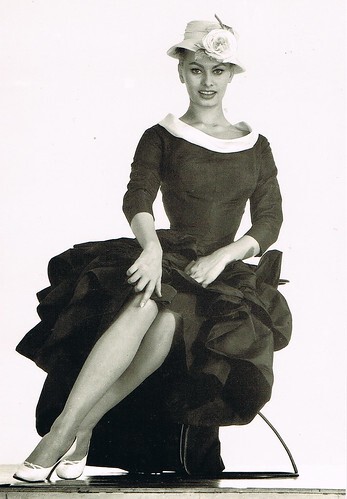
French postcard by Éditions Hazan, Paris. Collection: Carla Bosch (Meiter).
Sophia Loren is an Academy Award-winning - and gorgeous - European film star. La Loren (1934) rose to fame in post-war Italy as a voluptuous sex goddess. She became one of the most successful international stars of the 20th Century.
Sources: Wikipedia (French) and Editions Hazan.

French postcard by F. Hazan Editeur, Paris, no. 1. Photo: Albert Lamorisse, 1956. Pascal Lamorisse in Le ballon rouge/The red balloon (Albert Lamorisse, 1956). Caption: "Decouverte de ballon". (Discovery of the balloon).
French child actor Pascal Lamorisse (1950) is known by film lovers all over the world because of his parts in the short films Crin blanc: Le cheval sauvage (1953) and Le ballon rouge (1956), both directed by his father, Albert Lamorisse.

French postcard by Fernand Hazan ed., Paris, no. 1605 C. French poster for the film Remorques (Jean Gremillon, 1941), starring Jean Gabin and Michèle Morgan . Design poster: Henry Monnier.

French postcard by Ed. Hazan, Paris. French poster for La bête humaine (Jean Renoir, 1938), starring Jean Gabin and Simone Simon .

French postcard by Éditions Hazan, Paris, 1996. Photo: Raymond Depardon / Magnum. Caption: Jean Seberg and Jean-Luc Godard after the shooting of À bout de souffle.
American actress Jean Seberg (1938-1979) became an icon of the Nouvelle Vague with her role in Godard’s A Bout de Souffle/Breathless (1960). She appeared in over 30 films in Hollywood and Europe.

French postcard by Éditions Hazan, Paris, no. 6007, 1988. Photo: Sam Levin, 1969. Federico Fellini on the set of Satyricon (1969).
Italian film director and screenwriter Federico Fellini (1920-1993) was one of the most influential filmmakers of all time. He was known for his distinct style that blends fantasy and baroque images with earthiness. In a career spanning almost fifty years, Fellini won the Palme d'Or for La Dolce Vita (1960), was nominated for twelve Academy Awards. He won an Oscar for La Strada (1954), Le notti di Cabiria (1957), 8½ (1963) and Amarcord (1973).

French postcard in the Collection Noire by Editions Hazan, Paris, no. 6011, 1988. Photo: Sam Levin. Jean Renoir at the set of La bête humaine/The Human Beast (1938).
Jean Renoir (1894-1979) was one of the major French film directors before WW II. His films La Grande Illusion/The Great Illusion (1937) and La Règle du Jeu/The Rules of the Game (1939) belong to the masterpieces of French cinema. During the German invasion of France in 1941, he moved to Hollywood where he directed This Land Is Mine (1943), and The Southerner (1945). He later became an American citizen.

French postcard in the Collection Magie Noire by Editions Hazan, no. 6073, 1988. Photo: Madame L'Herbier / SPADEM, Paris. Jaque Catelain in L'inhumaine/The New Enchantment (Marcel L'Herbier, 1924). The exterior of the house of inventor Einar Norsen (Catelain) was designed by architect Robert Mallet-Stevens.
Jaque Catelain (1897-1965) was one of the most well-known faces of the French silent era. Catelain started in cinema with a film written by Marcel L'Herbier, Le Torrent (1917), after which he starred in L'Herbier's first completed film, Rose-France (1918). Catelain became Marcel L'Herbier's fixed actor in the silent era and starred in 12 of his silent films, including L'homme du large, Eldorado, L'Inhumaine and Feu Mattia Pascal.

French postcard in the Collection Magie Noire by Éditions Hazan, Paris, 1988, no. 6077. Photo: Pierre-Olivier Deschamps / Agence Vu, Paris. Caption: Jean-Luc Godard , Mai 86.
Jean-Luc Godard (1930) is a French film director and screenwriter. He is one of the most important members of the Nouvelle Vague (New Wave). Godard first received global acclaim for his feature À bout de souffle/Breathless (1959), helping to establish the New Wave movement. Godard's films have inspired many directors including Martin Scorsese, Quentin Tarantino, Robert Altman, Rainer Werner Fassbinder, and Wong Kar-wai. He has been married twice, to actresses Anna Karina and Anne Wiazemsky, both of whom starred in several of his films.

French postcard in the Collection Noire by Editions Hazan, Paris, no. 6109, 1989. Photo: Les films du Carosse, Paris. François Truffaut at the set of Jules et Jim (François Truffaut, 1961).
François Truffaut (1932-1984) was one of the most popular and successful French filmmakers ever. The French film director, screenwriter, producer, actor, and film critic was one of the founders of the Nouvelle Vague and his main themes were passion, women, childhood, and faithfulness. He created such classics as Les quatre cents coups/The 400 blows (1959), Jules et Jim (1961) and La Nuit Américaine/Day for Night (1973). His life and films were mixed up and one of his quotes is "Cinema is an improvement on life".

French postcard in the collection Magie Noire by Editions Hazan, Paris, 1990, no. 6218. Photo: Louis Jouvet in Les bas-fonds/Underground (Jean Renoir, 1936).
Louis Jouvet (1887-1951) was a living glory of the French theatre. He made a huge impact as both a stage director and an actor. His character, his eagle-like profile, and his unique way of speaking made him also an unforgettable film star who appeared in some of the masterpieces of the ‘poetical realism’, the Golden Age of the French cinema.

French postcard in the Collection Magie Noire by Éditions Hazan, Paris, no. 6247, 1991. Catherine Deneuve and Jean-Paul Belmondo in La Sirène du Mississipi/Mississippi Mermaid (François Truffaut, 1969).
Jean-Paul Belmondo (1933-2021) was a big comedy and action star in France from the mid-1960s till the mid-1980s, but he was initially associated with the Nouvelle Vague, the French New Wave of the 1960s. Despite his unconventional looks, including a broken nose, he was often polled as one of the sexiest men in the world. For nearly 50 years Belmondo remained one of the most popular and best-loved personalities in France.

French postcard by Editions Hazan, Paris, 1991, no. 6251. Photo: Bernard Blier and Jean Gabin in Le cave se rebiffe/Money Money Money (Gilles Grangier, 1961).
Stocky, balding Bernard Blier (1916-1989) was one of France's most versatile and sought-after character actors. His complete filmography includes 138 titles, both comedies, and dramas, in France and in Italy.
French actor and war hero Jean Gabin (1904-1976) was one of the great stars of European cinema. In the 1930s, he became the personification of the tragic romantic hero of the poetic realist film. Whether he played the legionnaire (Gueule d'amour), the deserter (Le Quai des brumes), or the head gangster (Pépé le Moko), Gabin was impeccable, bringing tragic humanity to each of his appearances which the public adored. After the war, Gabin was reborn as a tough anti-hero, set in his beliefs, feared and respected by all, the Godfather of the French cinema.

French postcard by Editions Hazan, Paris, no. 6274, 1991. Photo: Edimedia. Michel Serrault in Il lupo e l'agnello/The Wolf and the Lamb (Francesco Massaro, 1980).
French stage actor and film star Michel Serrault (1928-2007) appeared from 1954 to 2007 in more than 150 films. He is best known as Albin Mougeotte, alias the outrageous drag queen Zaza Napoli in the play and the film series La Cage aux Folles (The Bird Cage). In the following decades, the comedian also proved to be a noted dramatic film actor. He would win three Césars - the French version of the Oscar and became one of the grand old men of French cinema.

French postcard in the Collection Magie Noire by Editions Hazan, Paris, no. 6323. Anita Ekberg in La dolce vita (Federico Fellini, 1960).
Swedish (but naturalized Italian) film actress Anita Ekberg had a Hollywood career in the 1950s but got her real breakthrough in Italy. As Miss Sweden 1950, she was contracted by studio mogul Howard Hughes. In Rome, she made film history as the sensual, curvaceous film goddess who dances in the Trevi Fountain in Fellini’s La Dolce Vita (1960).

French postcard in the Collection Image Noire by Éditions Hazan, Paris, no. 6332, 1992. Photo: Catherine Faux.
Dennis Hopper (1936-2010) was a multi-talented American actor, director, and visual artist, but also one of the true 'enfants terribles' of Hollywood. In 1970, he won a Golden Palm for Easy Rider (1969) and Hopper was also Oscar-nominated for writing this groundbreaking anthem to freedom and rebellion. In 1987, he received a second nomination for his supporting role in Hoosiers (1986).

French postcard in the Collection Magie Noire by Editions Hazan, Paris, no. 6377, 1993. Photo: Claudine Auger and Sean Connery in Thunderball (Terence Young, 1966).
French actress Claudine Auger (1941-2019) was best known as Bond girl Domino in the James Bond film Thunderball (1965). At 17, she was Miss France 1958 and she became the first runner-up in the Miss World contest. Later she worked mostly in France and Italy.

French postcard in the Collection Noire by Editions Hazan, Paris, no. 6429, 1994. Photo: Raymond Depardon / Magnum Photos. François Truffaut and Jean-Pierre Cargol on the set of L'Enfant sauvage (François Truffaut, 1969).
François Truffaut (1932-1984) was one of the most popular and successful French filmmakers ever. The French film director, screenwriter, producer, actor, and film critic was one of the founders of the Nouvelle Vague and his main themes were passion, women, childhood, and faithfulness. He created such classics as Les quatre cents coups/The 400 blows (1959), Jules et Jim (1961) and La Nuit Américaine/Day for Night (1973). His life and films were mixed up and one of his quotes is "Cinema is an improvement on life".

French postcard in the Collection Magie Noire by Éditions Hazan, Paris, 1994, no. 6430. Photo: Bruno Barbey / Magnum Photos. Jean-Luc Godard , Jean-Paul Sartre and Simone de Beauvoir, 1970.
Jean-Luc Godard (1930) is a French film director and screenwriter. He is one of the most important members of the Nouvelle Vague (New Wave). Godard first received global acclaim for his feature À bout de souffle/Breathless (1959), helping to establish the New Wave movement. Godard's films have inspired many directors including Martin Scorsese, Quentin Tarantino, Robert Altman, Rainer Werner Fassbinder, and Wong Kar-wai. He has been married twice, to actresses Anna Karina and Anne Wiazemsky, both of whom starred in several of his films.

French postcard in the collection Magie Noire by Editions Hazan, no. 6489. Photo: Collection Dominique Lebrun D.R. Alfred Hitchcock promoting Rope (Alfred Hitchcock, 1948).
British director Alfred Hitchcock (1899-1980) was known as 'The Master of Suspense'. He is one of the most influential and extensively studied filmmakers in the history of cinema. He had his first major success with The Lodger (1926), a silent thriller loosely based on Jack the Ripper. Hitchcock came to international attention with The Man Who Knew Too Much (1934), The 39 Steps (1935), and, most notably, The Lady Vanishes (1938). His first Hollywood film was the multi-Oscar-winning psychological thriller Rebecca (1940). Many classics followed including Spellbound (1945), Notorious (1946), Rear Window (1954), North by Northwest (1959), and The Birds (1963). In a career spanning six decades, he directed over 50 feature films which garnered a total of 46 Oscar nominations and 6 wins.

French postcard in the Collection Magie Noire nu Editions Hazan, Paris, no. 6490, 1996. James Stewart , Grace Kelly, and Alfred Hitchcock on the set of Rear Window (Alfred Hitchcock, 1954).
American actor James Stewart (1908-1997) is among the most honored and popular stars in film history. Known for his distinctive drawl and everyman screen persona, Stewart had a film career that spanned over 55 years and 80 films.
American actress Grace Kelly (1929-1982) had a brief but very successful Hollywood career. She was the sparkling, elegant heroine in three classic Alfred Hitchcock thrillers. Her talents rivaled her beauty, winning her the Best Actress Oscar for The Country Girl in 1954. After marrying Prince Rainier III in April 1956, she became Princess of Monaco and retired from the cinema.

French postcard in the Collection Noire by Editions Hazan, Paris, no. 6492, 1996. Photo: Collection Dominque Lebrun D.R. Cary Grant in North by Northwest (Alfred Hitchcock, 1959).
Handsome, suave English-American actor Cary Grant (1904-1986) became one of Hollywood's definitive classic leading men, known for his debonair demeanour. Grant’s best-known films include Bringing Up Baby (1938), The Philadelphia Story (1940), His Girl Friday (1940), Notorious (1946), An Affair to Remember (1957), North by Northwest (1959), and Charade (1963).

French postcard by Éditions Hazan, Paris. Collection: Carla Bosch (Meiter).
Sophia Loren is an Academy Award-winning - and gorgeous - European film star. La Loren (1934) rose to fame in post-war Italy as a voluptuous sex goddess. She became one of the most successful international stars of the 20th Century.
Sources: Wikipedia (French) and Editions Hazan.
Published on February 05, 2022 22:00
February 4, 2022
How to wear a monocle
In the 19th century, the monocle became a fashionable article for the dandy. A monocle is a type of corrective lens used for only one eye. It has a wire ring that, attached to a string, can be connected to your clothing so you can't lose your monocle. If customised, you can wear a monocle securely with little effort. Erich von Stroheim however demonstrated in his films that a monocle can pop. Countless comedies followed in which an upper-class gentleman affects a shocked expression and plop, his monocle falls into his drink or smashes to pieces on the floor. This post is a little tribute to all the monocle wearers of the screen.
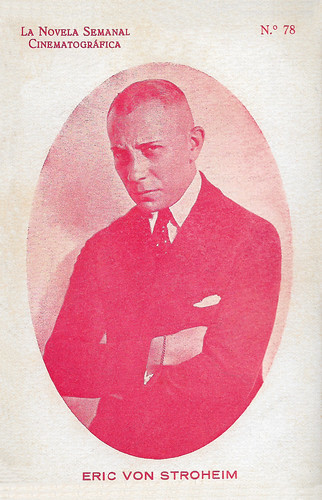
Spanish card by La Novela Semanal Cinematográfica, no. 78.
Was Austrian-born Erich von Stroheim (1885-1957) a Hollywood movie star or a European film star? (Who cares!) As the sadistic, monocled Prussian officer in both American and French films, he became ‘The Man You Love to Hate’. But maybe he is best known as one of the greatest and influential directors of the silent era, known for his extravaganza and the uncompromising accuracy of detail in his monumental films.
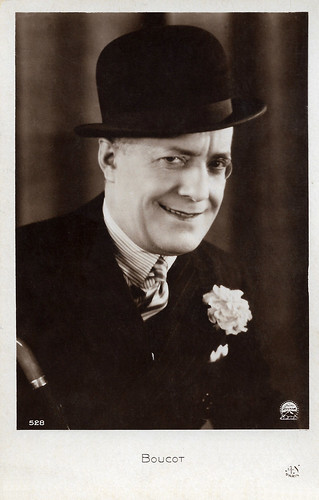
French postcard by A.N., Paris, no. 528. Photo: Paramount.
Louis-Jacques Boucot aka Boucot (1882-1949) was a French stage and screen actor, famous for his comic characters of Pénard and Babylas.
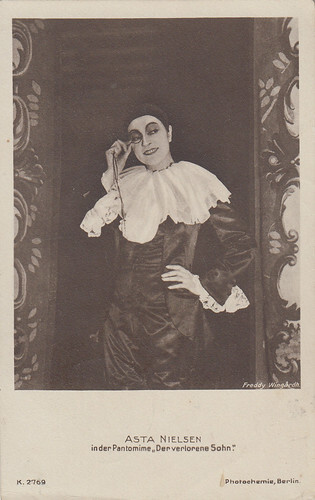
German postcard by Photochemie, Berlin, no. K. 2769. Photo: Freddy Wingardh. Asta Nielsen in the stage pantomime 'Der verlorene Sohn' (The Lost Son, 1918). Collection: Marlene Pilaete.
Danish silent film actress Asta Nielsen (1881-1972), was one of the most popular leading ladies of the 1910s and one of the first international film stars. Of her 74 films between 1910 and 1932, seventy were made in Germany where she was known simply as 'Die Asta'. Noted for her large dark eyes, mask-like face, and boyish figure, Nielsen most often portrayed strong-willed passionate women trapped by tragic consequences.
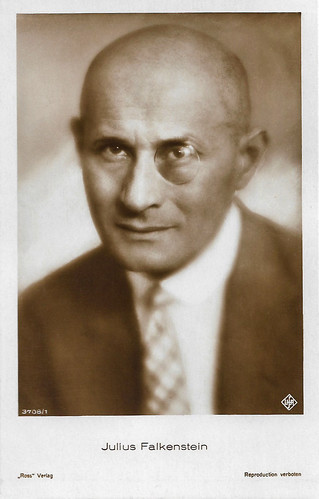
German postcard by Ross Verlag, Berlin, no. 3708/1, 1928-1929. Photo: Ufa.
Julius Falkenstein (1879-1933) was a bald, often monocle-wearing German character actor. He was known for such films as Zopf und Schwert - Eine tolle Prinzessin (1926), Der Meister von Nürnberg (1927) and Ich und die Kaiserin (1933).
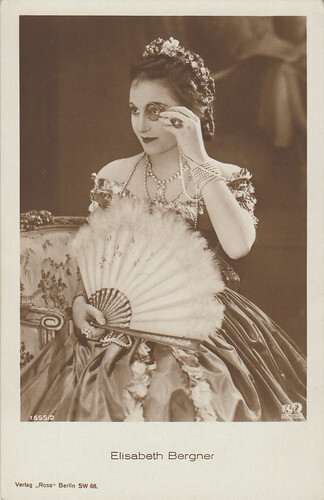
German postcard by Ross Verlag, no. 1655/2, 1927-1928. Photo: Phoebus-Film. Elisabeth Bergner in Liebe/Love (Paul Czinner, 1927). Collection: Marlene Pilaete.
The profoundly sensitive acting of Austrian-British actress Elisabeth Bergner (1897-1986) influenced the German cinema of the 1920s and 1930s. She specialized in a bisexual type that she portrayed in Der Geiger von Florenz and in other film and stage roles. Nazism forced her to go in exile, but she worked successfully in the West End and on Broadway.
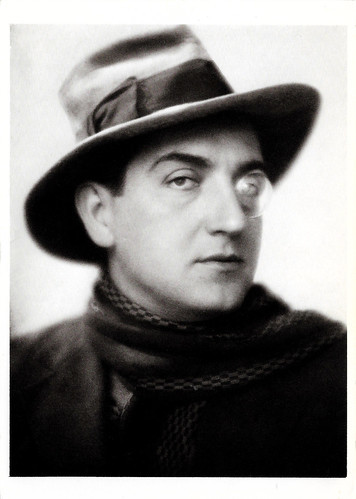
American postcard by Fotofolio, New York, N.Y., no. P124. Photo: Ufa / The Mansell Collection.
Fritz Lang (1890-1976) was an Austrian-German-American filmmaker, screenwriter, and occasional film producer and actor. One of the best-known émigrés from Germany's school of Expressionism, he was dubbed the 'Master of Darkness' by the British Film Institute. Lang's most famous films include the groundbreaking futuristic Metropolis (1927) and the influential M (1931), a film noir precursor that he made before he moved to the United States. His other notable films include Dr. Mabuse, der Spieler/Dr. Mabuse the Gambler (1922), Die Nibelungen (1924), Fury (1936), You Only Live Once (1937), Hangmen Also Die! (1943), The Woman in the Window (1944), and The Big Heat (1953).
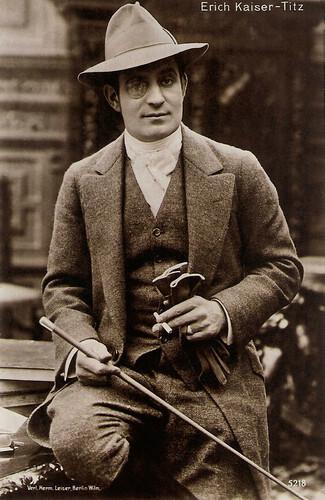
German postcard by Verlag Hermann Leiser, Berlin-Wilm., no. 5218.
Erich Kaiser-Titz (1875-1928) was an actor in the German silent cinema of the 1910s and 1920s, playing in almost 300 films.
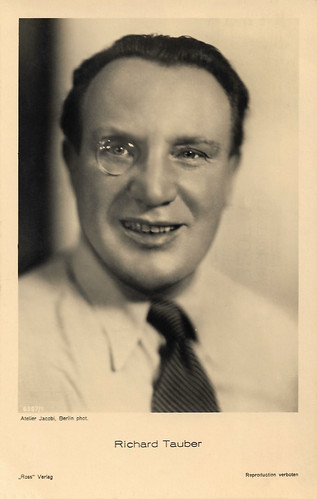
German postcard by Ross Verlag, no. 6307/1, 1931-1932. Photo: Atelier Jacobi, Berlin.
Austrian opera singer Richard Tauber (1891-1948) was one of the world's finest Mozartian tenors of the 20th century. Some critics commented that "his heart felt every word he sang". He also tested the then new talking pictures in such popular musical films as Ich küsse Ihre Hand, Madame (1929) with Marlene Dietrich, Das Land des Lächelns (1930) and Melodie der Liebe (1932).
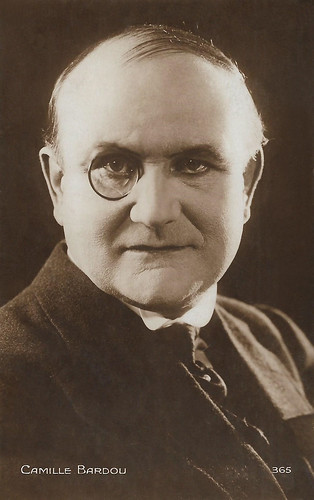
French postcard by Editions Cinémagazine, no. 365.
Camille Bardou (1872-1941) was a French stage and screen actor, who acted in cinema between 1904 and 1934.
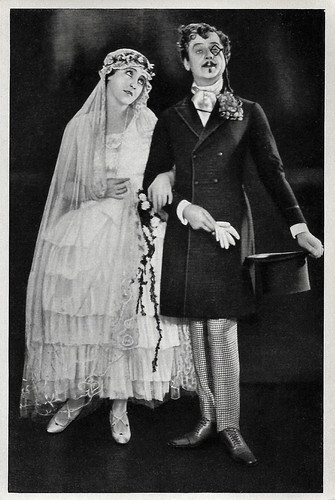
German collectors card by Ross Verlag in the series Vom Werden Deutscher Filmkunst - Der Stumme Film, picture no. 118, Group 39. Photo: Ufa. Publicity still with Henny Porten and Ralph Arthur Roberts in Meine Tante - deine Tante (Carl Froehlich, 1927).
With his monocle, German film actor Ralph Arthur Roberts (1884–1940) played high-ranking gentlemen such as directors and entrepreneurs in German comedies of the 1920s and 1930s. He also worked as a film director, creative director, and screenwriter for German cinema. He wrote stage plays and was the director of the Theater in der Behrenstrasse in Berlin. However, he is best known for a song he wrote, the evergreen 'Auf der Reeperbahn nachts um halb eins' (I May Never Go Home Anymore).
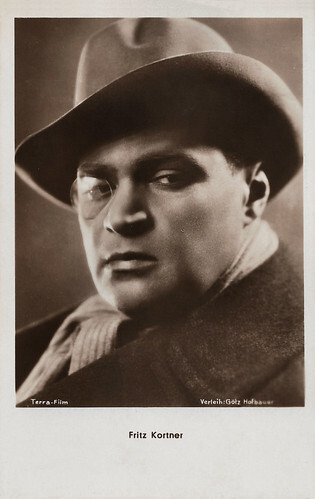
Austrian postcard by Iris Verlag, no. 6037. Photo: Terra Film / Götz Hofbauer.
Austrian-born stage and film actor and theatre director Fritz Kortner (1892-1970) was one of the best-known character actors of German silent cinema. His specialty was playing sinister and threatening roles.
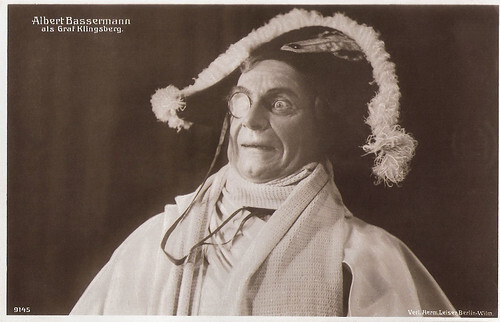
German postcard by Verlag Hermann Leiser, Berlin-Wilm., no. 9145. Albert Bassermann as Graf Klingsberg in the play 'Die beiden Klingsberg' by August von Kotzebue.
Albert Bassermann (1867–1952) was one of the first great German stage actors who worked for the cinema. In 1933 he fled the Nazi regime and became an Oscar-nominated stage and film actor in the US.
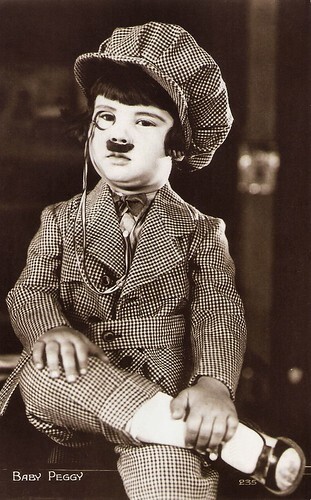
French postcard by Cinémagazine-Edition, Paris, no. 235.
Diana Serra Cary (1918), best known as Baby Peggy , was one of the three major American child stars of the Hollywood silent movie era along with Jackie Coogan and Baby Marie. The first film, Playmates in 1921, was a success, and Peggy was signed to a long-term contract with Century Studios. Between 1921 and 1923 she made over 150 short comedies for Century. In 1922 she received 1.2 million fan letters and by 1924 she had been dubbed 'The Million Dollar Baby' for her $1.5 million a year salary.
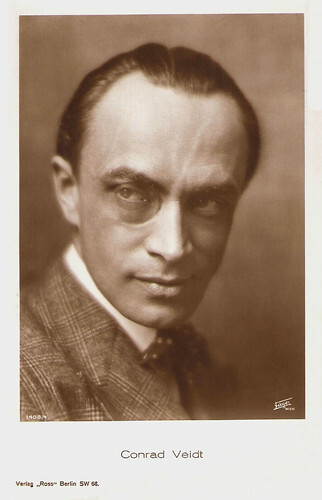
German postcard by Ross Verlag, no. 1408/4, 1927-1928. Photo: Fayer, Wien.
Conrad Veidt (1893–1943) was the most highly strung and romantically handsome of the German expressionist actors. From 1916 until his death, he appeared in well over 100 films, including such classics as Das Kabinett des Dr. Caligari/Das Cabinet des Dr. Caligari (Robert Wiene, 1920) and Casablanca (Michael Curtiz, 1942).
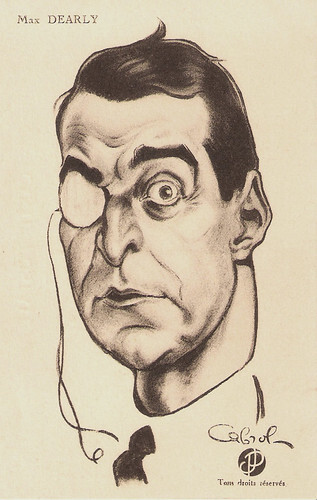
French postcard by Publications J.P., Paris, no. 7. Illustration: Cabrol.
Max Dearly (1874-1943) was a French actor, famous for his parts in 1930s French sound film but also for his previous career in Parisian vaudeville.
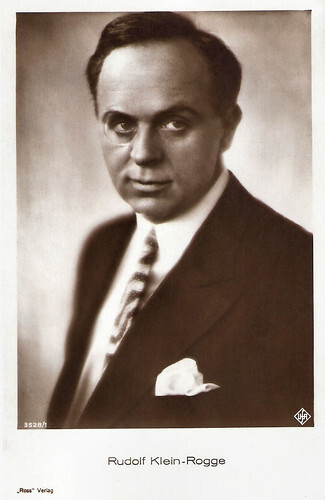
German postcard by Ross Verlag no. 3528/1, 1928-1929. Photo: Ufa.
Rudolf Klein-Rogge is best remembered as Fritz Lang's Dr. Mabuse and as Lang's mad scientist in Metropolis, but he played many more parts in the German cinema.
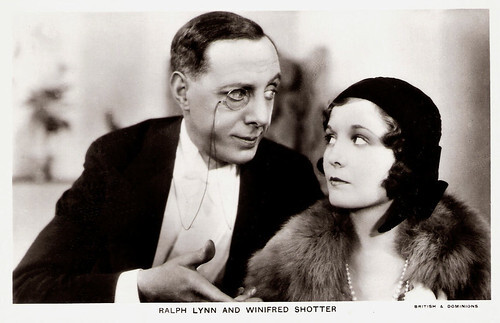
British postcard in the Film Partners Series by Real Photograph, London, no. 81. Photo: British & Dominions. Ralph Lynn and Winifred Shotter .
British actor Ralph Lynn (1882-1962) was a tweedy, dark-haired comedian who made a stage career out of playing monocled silly ass twits. He was a veteran performer of London's highly popular Aldwych Repertory Theatre farces, and he and fellow members Tom Walls and Robertson Hare successfully took many of their stylized productions to the big screen in the 1930s.
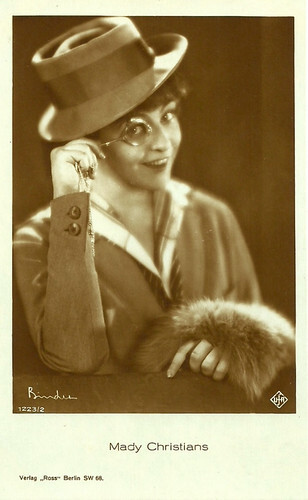
German postcard by Ross Verlag, no. 1223/2. Photo: Alex Binder.
Austrian-born stage actress Mady Christians (1892-1951) was a star of the German silent cinema and appeared in Austrian, French, British, and Hollywood films too.
Sources: Wikipedia and .

Spanish card by La Novela Semanal Cinematográfica, no. 78.
Was Austrian-born Erich von Stroheim (1885-1957) a Hollywood movie star or a European film star? (Who cares!) As the sadistic, monocled Prussian officer in both American and French films, he became ‘The Man You Love to Hate’. But maybe he is best known as one of the greatest and influential directors of the silent era, known for his extravaganza and the uncompromising accuracy of detail in his monumental films.

French postcard by A.N., Paris, no. 528. Photo: Paramount.
Louis-Jacques Boucot aka Boucot (1882-1949) was a French stage and screen actor, famous for his comic characters of Pénard and Babylas.

German postcard by Photochemie, Berlin, no. K. 2769. Photo: Freddy Wingardh. Asta Nielsen in the stage pantomime 'Der verlorene Sohn' (The Lost Son, 1918). Collection: Marlene Pilaete.
Danish silent film actress Asta Nielsen (1881-1972), was one of the most popular leading ladies of the 1910s and one of the first international film stars. Of her 74 films between 1910 and 1932, seventy were made in Germany where she was known simply as 'Die Asta'. Noted for her large dark eyes, mask-like face, and boyish figure, Nielsen most often portrayed strong-willed passionate women trapped by tragic consequences.

German postcard by Ross Verlag, Berlin, no. 3708/1, 1928-1929. Photo: Ufa.
Julius Falkenstein (1879-1933) was a bald, often monocle-wearing German character actor. He was known for such films as Zopf und Schwert - Eine tolle Prinzessin (1926), Der Meister von Nürnberg (1927) and Ich und die Kaiserin (1933).

German postcard by Ross Verlag, no. 1655/2, 1927-1928. Photo: Phoebus-Film. Elisabeth Bergner in Liebe/Love (Paul Czinner, 1927). Collection: Marlene Pilaete.
The profoundly sensitive acting of Austrian-British actress Elisabeth Bergner (1897-1986) influenced the German cinema of the 1920s and 1930s. She specialized in a bisexual type that she portrayed in Der Geiger von Florenz and in other film and stage roles. Nazism forced her to go in exile, but she worked successfully in the West End and on Broadway.

American postcard by Fotofolio, New York, N.Y., no. P124. Photo: Ufa / The Mansell Collection.
Fritz Lang (1890-1976) was an Austrian-German-American filmmaker, screenwriter, and occasional film producer and actor. One of the best-known émigrés from Germany's school of Expressionism, he was dubbed the 'Master of Darkness' by the British Film Institute. Lang's most famous films include the groundbreaking futuristic Metropolis (1927) and the influential M (1931), a film noir precursor that he made before he moved to the United States. His other notable films include Dr. Mabuse, der Spieler/Dr. Mabuse the Gambler (1922), Die Nibelungen (1924), Fury (1936), You Only Live Once (1937), Hangmen Also Die! (1943), The Woman in the Window (1944), and The Big Heat (1953).

German postcard by Verlag Hermann Leiser, Berlin-Wilm., no. 5218.
Erich Kaiser-Titz (1875-1928) was an actor in the German silent cinema of the 1910s and 1920s, playing in almost 300 films.

German postcard by Ross Verlag, no. 6307/1, 1931-1932. Photo: Atelier Jacobi, Berlin.
Austrian opera singer Richard Tauber (1891-1948) was one of the world's finest Mozartian tenors of the 20th century. Some critics commented that "his heart felt every word he sang". He also tested the then new talking pictures in such popular musical films as Ich küsse Ihre Hand, Madame (1929) with Marlene Dietrich, Das Land des Lächelns (1930) and Melodie der Liebe (1932).

French postcard by Editions Cinémagazine, no. 365.
Camille Bardou (1872-1941) was a French stage and screen actor, who acted in cinema between 1904 and 1934.

German collectors card by Ross Verlag in the series Vom Werden Deutscher Filmkunst - Der Stumme Film, picture no. 118, Group 39. Photo: Ufa. Publicity still with Henny Porten and Ralph Arthur Roberts in Meine Tante - deine Tante (Carl Froehlich, 1927).
With his monocle, German film actor Ralph Arthur Roberts (1884–1940) played high-ranking gentlemen such as directors and entrepreneurs in German comedies of the 1920s and 1930s. He also worked as a film director, creative director, and screenwriter for German cinema. He wrote stage plays and was the director of the Theater in der Behrenstrasse in Berlin. However, he is best known for a song he wrote, the evergreen 'Auf der Reeperbahn nachts um halb eins' (I May Never Go Home Anymore).

Austrian postcard by Iris Verlag, no. 6037. Photo: Terra Film / Götz Hofbauer.
Austrian-born stage and film actor and theatre director Fritz Kortner (1892-1970) was one of the best-known character actors of German silent cinema. His specialty was playing sinister and threatening roles.

German postcard by Verlag Hermann Leiser, Berlin-Wilm., no. 9145. Albert Bassermann as Graf Klingsberg in the play 'Die beiden Klingsberg' by August von Kotzebue.
Albert Bassermann (1867–1952) was one of the first great German stage actors who worked for the cinema. In 1933 he fled the Nazi regime and became an Oscar-nominated stage and film actor in the US.

French postcard by Cinémagazine-Edition, Paris, no. 235.
Diana Serra Cary (1918), best known as Baby Peggy , was one of the three major American child stars of the Hollywood silent movie era along with Jackie Coogan and Baby Marie. The first film, Playmates in 1921, was a success, and Peggy was signed to a long-term contract with Century Studios. Between 1921 and 1923 she made over 150 short comedies for Century. In 1922 she received 1.2 million fan letters and by 1924 she had been dubbed 'The Million Dollar Baby' for her $1.5 million a year salary.

German postcard by Ross Verlag, no. 1408/4, 1927-1928. Photo: Fayer, Wien.
Conrad Veidt (1893–1943) was the most highly strung and romantically handsome of the German expressionist actors. From 1916 until his death, he appeared in well over 100 films, including such classics as Das Kabinett des Dr. Caligari/Das Cabinet des Dr. Caligari (Robert Wiene, 1920) and Casablanca (Michael Curtiz, 1942).

French postcard by Publications J.P., Paris, no. 7. Illustration: Cabrol.
Max Dearly (1874-1943) was a French actor, famous for his parts in 1930s French sound film but also for his previous career in Parisian vaudeville.

German postcard by Ross Verlag no. 3528/1, 1928-1929. Photo: Ufa.
Rudolf Klein-Rogge is best remembered as Fritz Lang's Dr. Mabuse and as Lang's mad scientist in Metropolis, but he played many more parts in the German cinema.

British postcard in the Film Partners Series by Real Photograph, London, no. 81. Photo: British & Dominions. Ralph Lynn and Winifred Shotter .
British actor Ralph Lynn (1882-1962) was a tweedy, dark-haired comedian who made a stage career out of playing monocled silly ass twits. He was a veteran performer of London's highly popular Aldwych Repertory Theatre farces, and he and fellow members Tom Walls and Robertson Hare successfully took many of their stylized productions to the big screen in the 1930s.

German postcard by Ross Verlag, no. 1223/2. Photo: Alex Binder.
Austrian-born stage actress Mady Christians (1892-1951) was a star of the German silent cinema and appeared in Austrian, French, British, and Hollywood films too.
Sources: Wikipedia and .
Published on February 04, 2022 22:00
February 3, 2022
Gloria DeHaven
American actress and singer Gloria DeHaven (1925-2016) was a contract star for Metro-Goldwyn-Mayer and often played the second lead in cheerful light musicals.

French postcard by Editions Tour Eiffel, Lyon. Photo: Metro Goldwyn Mayer (M.G.M.).

Italian postcard by Garami, Milano. Photo: Metro-Goldwyn-Mayer. Gloria DeHaven in Two Girls and a Sailor (Richard Thorpe, 1944).

Belgian collectors card by Kwatta, Bois d'Haine, no. C. 172. Photo: MGM. Mickey Rooney and Gloria DeHaven in Summer Holiday (Rouben Mamoulian, 1948).
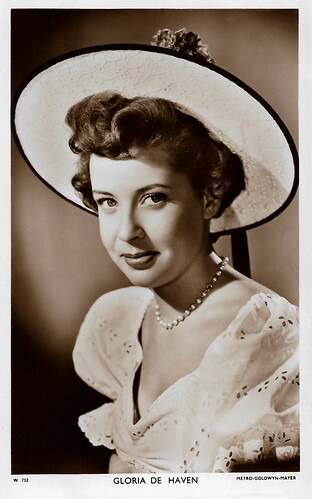
British postcard in the Picturegoer Series, London, no. W 752. Photo: Metro Goldwyn Mayer.
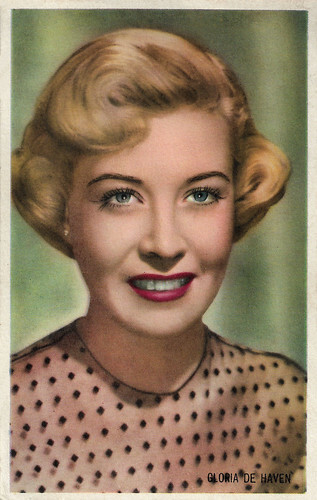
Belgian collectors card by Kwatta, no. C. 279. Photo: Metro-Goldwyn-Mayer. Gloria DeHaven in Scene of the Crime (Roy Rowland, 1949).
Portraying her own mother
Gloria Mildred DeHaven was born in Los Angeles, California, in 1925. She was the daughter of actor-director Carter DeHaven and actress Flora Parker DeHaven, both former vaudeville performers.
Her real family name was O'Callahan before her father legally changed his name to DeHaven. With her father's help, who was also an assistant director and a friend of Charles Chaplin, she received her first film appearance. She began her career with a bit part in Charlie Chaplin 's Modern Times (1936).
Her first visible role was in the George Cukor-directed Susan and God (1940) starring Joan Crawford . DeHaven was signed to a contract with MGM. On loan to RKO, she gave Frank Sinatra his first screen kiss in Step Lively (Tim Whelan, 1944).
She had featured roles in such films as the musical Best Foot Forward (Edward Buzzell, 1943) starring Lucille Ball, The Thin Man Goes Home (Richard Thorpe, 1944) starring William Powell and Myrna Loy, the Film Noir Scene of the Crime (Roy Rowland, 1949) with Van Johnson, and the musical Summer Stock (Charles Walters, 1950), as the sister of Judy Garland .
In 1944 DeHaven was voted by exhibitors as the third most likely to be a 'star of tomorrow' in 1944. She portrayed her own mother, Flora Parker DeHaven, in the Fred Astaire film Three Little Words (Richard Thorpe, 1950), a musical film biography of the Tin Pan Alley songwriting partnership of Bert Kalmar and Harry Ruby.
During the 1950s she appeared in such films as the musical comedy The Girl Rush (Robert Pirosh, 1955) starring Rosalind Russell. I.S. Mowis at IMDb : "Gloria never quite managed to get first-tier assignments and her career waned as musicals ceased to be a bankable commodity. In the early 1950s, she attempted stronger dramatic roles but with only moderate success. By 1955, she had wisely turned to the stage for occasional appearances on Broadway."
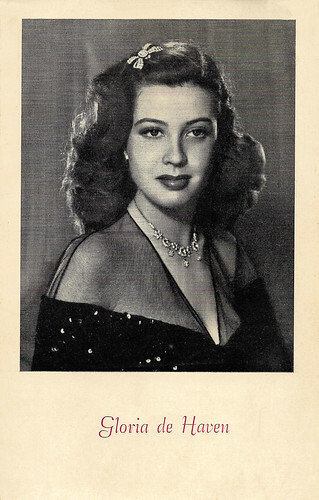
Vintage postcard.
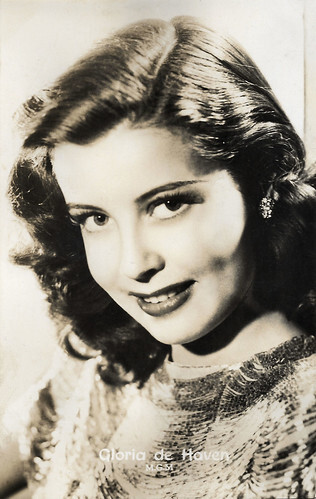
Vintage card. Photo: MGM.
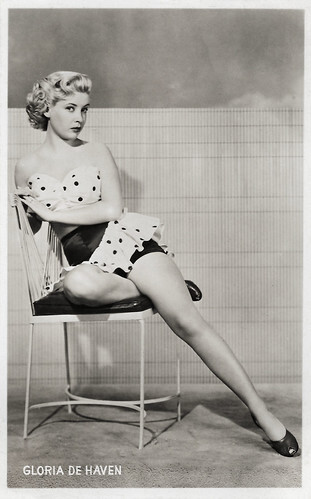
Belgian postcard, no. 8. Photo: Universal Film.
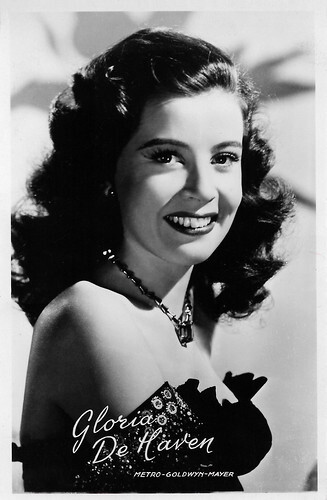
Vintage postcard, no. AX 1122. Photo: Metro Goldwyn Mayer.
An all-star box office flop
Gloria DeHaven's Broadway debut came in 1955. She played Diane in the musical version of 'Seventh Heaven'. She also toured in a summer stock production of 'No, No, Nanette'.
DeHaven's musical talents supplemented her acting abilities. Besides being cast as a singer in many of her films, including I'll Get By, So This Is Paris and The Girl Rush, and performing numbers in many of her films, DeHaven sang with the bands of Jan Savitt and Bob Crosby and at one time had her own nightclub act.
After a long absence from the screen, Gloria DeHaven was one of the numerous celebrities who appeared in the all-star box office flop, Won Ton Ton, the Dog Who Saved Hollywood (Michael Winner, 1976). Later she appeared as the love interest of Jack Lemmon in the romantic comedy Out to Sea (Martha Coolidge, 1997), also starring Walter Matthau.
On television, DeHaven appeared in the soap operas Ryan's Hope (as Bess Shelby), As the World Turns (as Sara Fuller), and Mary Hartman, Mary Hartman. She also guest-starred in such television series as Wagon Train, Flipper, Marcus Welby, M.D., Gunsmoke, Mannix, Fantasy Island, Hart to Hart, The Love Boat, Murder, She Wrote and Touched by an Angel. From January 1969 to February 1971, DeHaven hosted a morning call-in movie show on WABC-TV in New York City.
DeHaven was married four times to three men. Her first husband was actor John Payne , star of the Western TV series The Restless Gun, whom she married in 1944 and divorced in 1950. Her second husband was real estate developer Martin Kimmel. They were married in 1953 and divorced the following year. She was married to Richard Fincher, son of a Miami Oldsmobile dealer, from 1957 until 1963. They remarried in 1965 and divorced again in 1969. She had two children with Payne, daughter Kathleen Hope (born 1945) and son Thomas John (born 1947) as well as two children with Fincher, son Harry (born 1958) and daughter Faith (born 1962).
Gloria DeHaven died in 2016, in Las Vegas of undisclosed causes a week after her 91st birthday while in hospice care after having had a stroke a few months earlier. She was survived by her four children. Her remains were cremated.
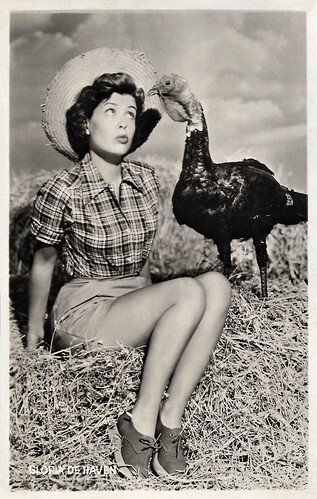
Belgian postcard. Photo: Metro Goldwyn Mayer. Sent by mail in 1952.
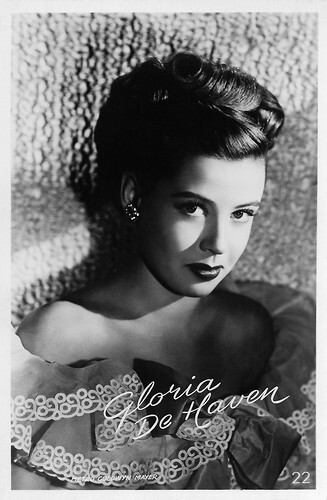
Dutch postcard by Foto archief Film en Toneel, no. AX 304 / 22. Photo: Metro Goldwyn Mayer.
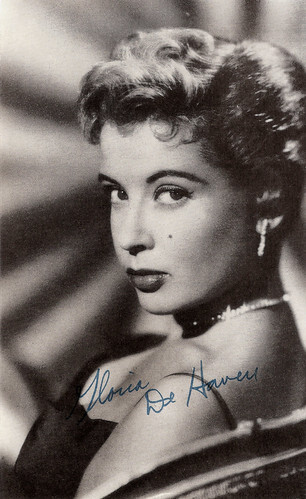
British postcard in the Celebrity Autographs Series, no. 192. Photo: Universal-International. Gloria DeHaven in So This Is Paris (Richard Quine, 1954).
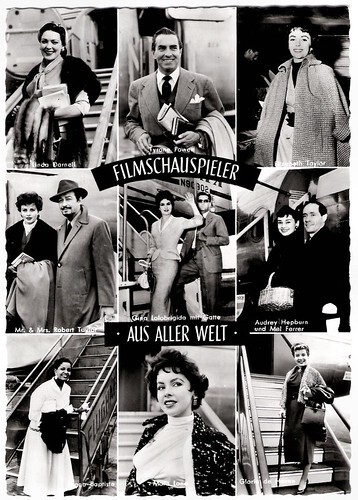
German postcard by Kunst und Film Verlag H. Lukow, Hannover, no. L2/1042. Caption: Filmschauspieler aus aller Welt (Film actors from around the world).
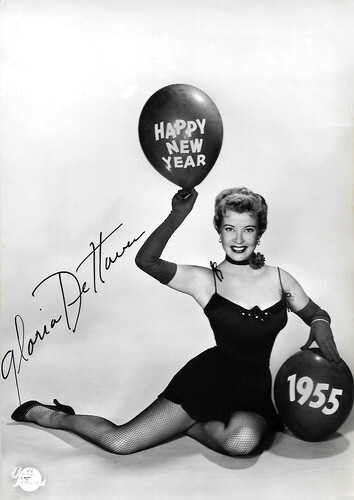
Italian postcard by Bromofoto, Milano, no. 856. Photo: Universal International. Caption: Happy New Year 1955.
Sources: (IMDb), Wikipedia, and .

French postcard by Editions Tour Eiffel, Lyon. Photo: Metro Goldwyn Mayer (M.G.M.).

Italian postcard by Garami, Milano. Photo: Metro-Goldwyn-Mayer. Gloria DeHaven in Two Girls and a Sailor (Richard Thorpe, 1944).

Belgian collectors card by Kwatta, Bois d'Haine, no. C. 172. Photo: MGM. Mickey Rooney and Gloria DeHaven in Summer Holiday (Rouben Mamoulian, 1948).

British postcard in the Picturegoer Series, London, no. W 752. Photo: Metro Goldwyn Mayer.

Belgian collectors card by Kwatta, no. C. 279. Photo: Metro-Goldwyn-Mayer. Gloria DeHaven in Scene of the Crime (Roy Rowland, 1949).
Portraying her own mother
Gloria Mildred DeHaven was born in Los Angeles, California, in 1925. She was the daughter of actor-director Carter DeHaven and actress Flora Parker DeHaven, both former vaudeville performers.
Her real family name was O'Callahan before her father legally changed his name to DeHaven. With her father's help, who was also an assistant director and a friend of Charles Chaplin, she received her first film appearance. She began her career with a bit part in Charlie Chaplin 's Modern Times (1936).
Her first visible role was in the George Cukor-directed Susan and God (1940) starring Joan Crawford . DeHaven was signed to a contract with MGM. On loan to RKO, she gave Frank Sinatra his first screen kiss in Step Lively (Tim Whelan, 1944).
She had featured roles in such films as the musical Best Foot Forward (Edward Buzzell, 1943) starring Lucille Ball, The Thin Man Goes Home (Richard Thorpe, 1944) starring William Powell and Myrna Loy, the Film Noir Scene of the Crime (Roy Rowland, 1949) with Van Johnson, and the musical Summer Stock (Charles Walters, 1950), as the sister of Judy Garland .
In 1944 DeHaven was voted by exhibitors as the third most likely to be a 'star of tomorrow' in 1944. She portrayed her own mother, Flora Parker DeHaven, in the Fred Astaire film Three Little Words (Richard Thorpe, 1950), a musical film biography of the Tin Pan Alley songwriting partnership of Bert Kalmar and Harry Ruby.
During the 1950s she appeared in such films as the musical comedy The Girl Rush (Robert Pirosh, 1955) starring Rosalind Russell. I.S. Mowis at IMDb : "Gloria never quite managed to get first-tier assignments and her career waned as musicals ceased to be a bankable commodity. In the early 1950s, she attempted stronger dramatic roles but with only moderate success. By 1955, she had wisely turned to the stage for occasional appearances on Broadway."

Vintage postcard.

Vintage card. Photo: MGM.

Belgian postcard, no. 8. Photo: Universal Film.

Vintage postcard, no. AX 1122. Photo: Metro Goldwyn Mayer.
An all-star box office flop
Gloria DeHaven's Broadway debut came in 1955. She played Diane in the musical version of 'Seventh Heaven'. She also toured in a summer stock production of 'No, No, Nanette'.
DeHaven's musical talents supplemented her acting abilities. Besides being cast as a singer in many of her films, including I'll Get By, So This Is Paris and The Girl Rush, and performing numbers in many of her films, DeHaven sang with the bands of Jan Savitt and Bob Crosby and at one time had her own nightclub act.
After a long absence from the screen, Gloria DeHaven was one of the numerous celebrities who appeared in the all-star box office flop, Won Ton Ton, the Dog Who Saved Hollywood (Michael Winner, 1976). Later she appeared as the love interest of Jack Lemmon in the romantic comedy Out to Sea (Martha Coolidge, 1997), also starring Walter Matthau.
On television, DeHaven appeared in the soap operas Ryan's Hope (as Bess Shelby), As the World Turns (as Sara Fuller), and Mary Hartman, Mary Hartman. She also guest-starred in such television series as Wagon Train, Flipper, Marcus Welby, M.D., Gunsmoke, Mannix, Fantasy Island, Hart to Hart, The Love Boat, Murder, She Wrote and Touched by an Angel. From January 1969 to February 1971, DeHaven hosted a morning call-in movie show on WABC-TV in New York City.
DeHaven was married four times to three men. Her first husband was actor John Payne , star of the Western TV series The Restless Gun, whom she married in 1944 and divorced in 1950. Her second husband was real estate developer Martin Kimmel. They were married in 1953 and divorced the following year. She was married to Richard Fincher, son of a Miami Oldsmobile dealer, from 1957 until 1963. They remarried in 1965 and divorced again in 1969. She had two children with Payne, daughter Kathleen Hope (born 1945) and son Thomas John (born 1947) as well as two children with Fincher, son Harry (born 1958) and daughter Faith (born 1962).
Gloria DeHaven died in 2016, in Las Vegas of undisclosed causes a week after her 91st birthday while in hospice care after having had a stroke a few months earlier. She was survived by her four children. Her remains were cremated.

Belgian postcard. Photo: Metro Goldwyn Mayer. Sent by mail in 1952.

Dutch postcard by Foto archief Film en Toneel, no. AX 304 / 22. Photo: Metro Goldwyn Mayer.

British postcard in the Celebrity Autographs Series, no. 192. Photo: Universal-International. Gloria DeHaven in So This Is Paris (Richard Quine, 1954).

German postcard by Kunst und Film Verlag H. Lukow, Hannover, no. L2/1042. Caption: Filmschauspieler aus aller Welt (Film actors from around the world).

Italian postcard by Bromofoto, Milano, no. 856. Photo: Universal International. Caption: Happy New Year 1955.
Sources: (IMDb), Wikipedia, and .
Published on February 03, 2022 22:00
February 2, 2022
Monica Vitti (1931-2022)
Yesterday, 2 February 2022, legendary Italian actress Monica Vitti passed away in Rome, Italy. She was most widely noted in the early 1960s for her starring roles in four classic avant-garde films directed by Michelangelo Antonioni. Later the glamorous blonde became the queen of the 'Commedia all’Italiana', a film genre previously restricted to men. Monica Vitti was 90.

French postcard by PSG for Corvisart, Epinal, no. 437. Photo: Sam Lévin.
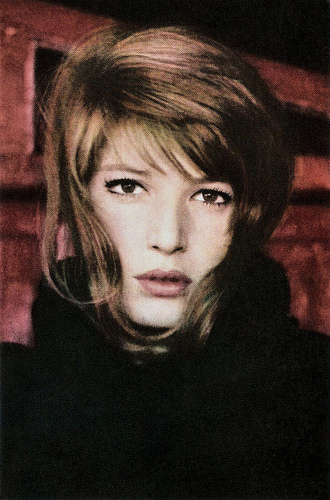
Romanian postcard by Casa Filmului Acin, no. 97.
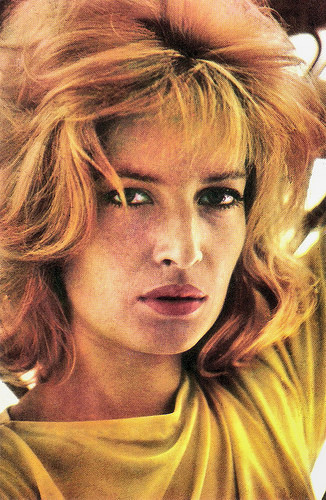
Romanian postcard by Casa Filmului Acin, no. 125.
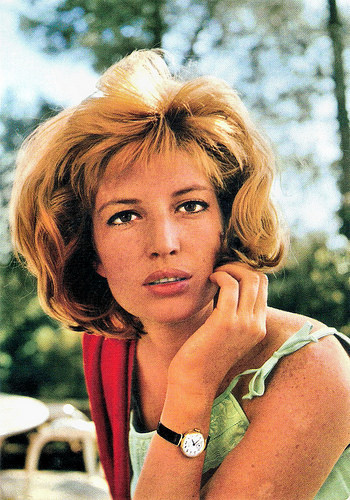
Italian postcard by Rotalcolor, no. 146.
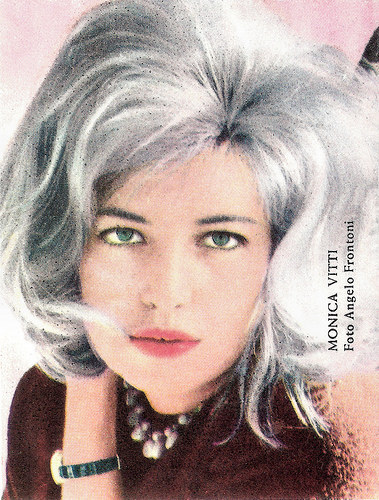
Vintage collectors card. Photo: Angelo Frontoni.
Turning Point
Monica Vitti was born Maria Luisa Ceciarelli in Rome, in 1931. She studied at Pittman's College, where she played as a teen in a charity performance of Dario Niccodemi's La nemica (The Enemy). She then trained as an actor at the Accademia Nazionale d'Arte Drammatica (Rome's National Academy of Dramatic Arts) where she graduated in 1953.
She toured Germany with an Italian acting troupe and her first stage appearance in Rome was for a production of Niccolò Machiavelli's La Mandragola (The Mandragola). Vitti's film debut was an uncredited bit part in the comedy Ridere! Ridere! Ridere!/Laugh! Laugh! Laugh! (Edoardo Anton, 1954) with Tino Scotti and Ugo Tognazzi . Her first widely noted performance was at the age of 26 in the comedy Le dritte/Smart Girls (Mario Amendola, 1958) starring Franco Fabrizi .
A turning point in her career came in 1957 when she joined Michelangelo Antonioni's Teatro Nuovo di Milano. Three years later she played a leading role in his internationally praised and award-winning film L'avventura/The Adventure (Michelangelo Antonioni, 1960).
In L’avventura a group of rich Italians heads out on a yachting trip to a deserted volcanic island in the Mediterranean. When they are about to leave the island, they find Anna ( Lea Massari ), the main character up to this point, has gone missing. Sandro, Anna's boyfriend ( Gabriele Ferzetti ), and Claudia (Monica Vitti), Anna's friend, try without success to find her. While looking for Anna, Claudia and Sandro develop an attraction for each other. They proceed to become lovers, and all but forget about the missing Anna.
Vitti as the detached and cool Claudia gave a stunning screen presence. She also helped Antonioni raise money for the production and stuck with him through daunting location shooting. L'avventura made Vitti an international star and one of Italy's most famous actresses of the 20th century. Her image later even appeared on an Italian postage stamp commemorating the film.
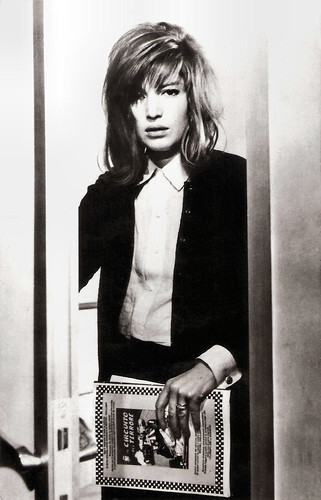
Romanian postcard by Casa Filmuluii Acin, no. 467. Monica Vitti in Ridere! Ridere! Ridere!/Laugh! Laugh! Laugh! (Edoardo Anton, 1954).
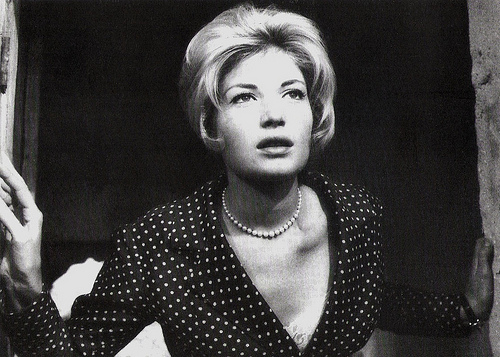
British postcard by BFI and The Screen on the Hill, for the British re-release in 1995. Photo: publicity still for L'avventura (Michelangelo Antonioni, 1960).
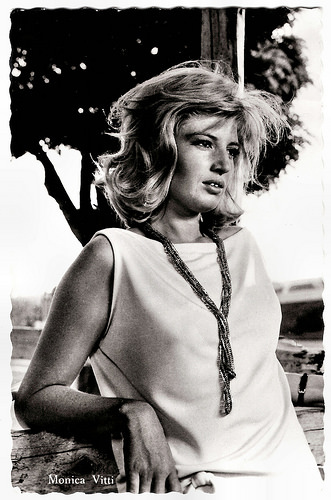
Dutch postcard by De Muinck en Co, Amsterdam, no. 809. Photo: publicity still for L'eclisse/The Eclipse (Michelangelo Antonioni, 1962).
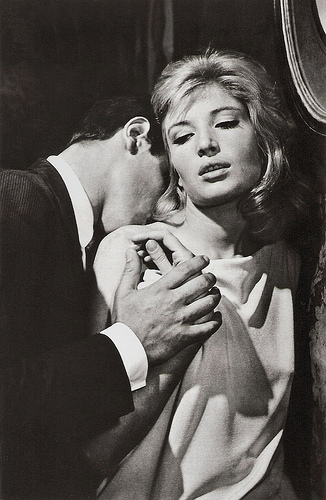
Romanian postcard by Casa Filmului Acin. Photo: publicity still for L'eclisse/The Eclipse (Michelangelo Antonioni, 1962) with Alain Delon .
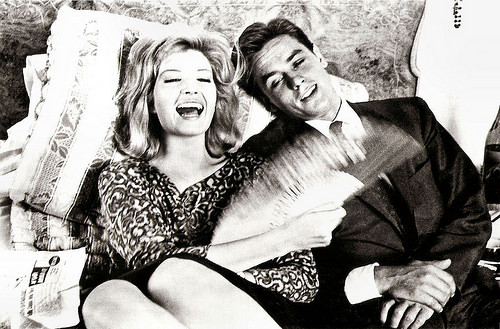
Romanian postcard by Casa Filmului Acin. Photo: publicity still for L'eclisse/The Eclipse (Michelangelo Antonioni, 1962) with Alain Delon .
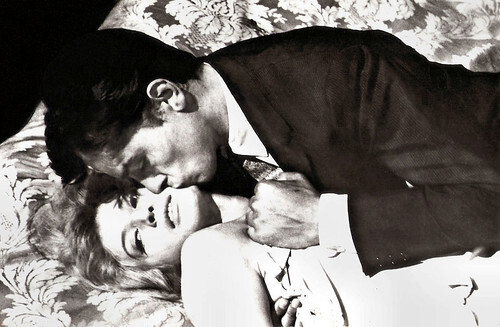
Romanian postcard by Casa Filmului Acin, no. 305. Monica Vitti and Alain Delon in L'Eclisse/The Eclipse (Michelangelo Antonioni, 1962).
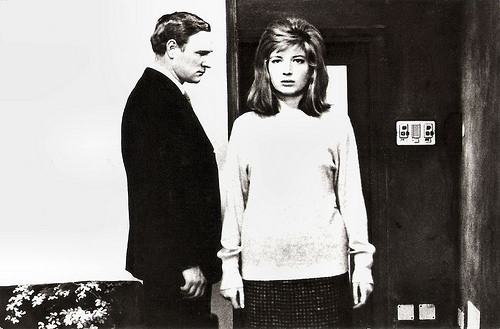
Romanian postcard by Casa Filmului Acin, no. 322. Photo: publicity still for Il deserto rosso/Red Desert (Michelangelo Antonioni, 1964) with Richard Harris.
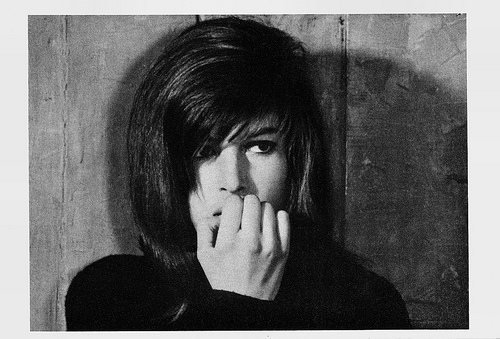
French postcard by Editions La Malibran, Paris, no CI 3. Photo: Carlo di Palma. Publicity still for Il deserto rosso/Red Desert (Michelangelo Antonioni, 1964).
Modernist Consciousness in the 1960s
Monica Vitti received more critical praise for her starring roles in the next three Antonioni films La notte/The Night (Michelangelo Antonioni, 1961), L'eclisse/The Eclipse (Michelangelo Antonioni, 1962) and Il deserto rosso/The Red Desert (Michelangelo Antonioni, 1964), which are often cited with L'avventura as a series.
In the four films, Antonioni explores modernist consciousness in the 1960s. In her portrayal of deeply troubled middle-class women, unable to establish satisfying relationships and incapable of connecting with their environment, the beautiful Vitti came to embody the modernist dilemma in all its complexity and angst.
Hal Erickson at AllMovie even calls her ‘The high priestess of frosty sensuality’. In La notte she plays the daughter of a wealthy industrialist who tries to inaugurate an empty affair with a married author, played by Marcello Mastroianni . In L’eclisse she plays Vittoria, a young translator who meets the vital broker Piero ( Alain Delon ) during a crash in the Stock Market but the love affair is doomed because of Piero’s materialistic nature. In Il deserto rosso she was Giuliana, a housewife married to a factory manager. She is mentally ill, but hides it from her husband as best she can. She meets the engineer Zeller (Richard Harris) who takes advantage of her distress, and then she is again alone and ill.
She also starred in films by other directors, such as Château en Suède/Nutty Naughty Chateau (Roger Vadim, 1963) with Jean-Claude Brialy , and the comedy Il disco volante/The Flying Saucer (Tinto Brass, 1964) with Alberto Sordi and Silvana Mangano .
Vitti appeared in only two English language films. She starred in the title role of Joseph Losey's Modesty Blaise (1966), a mod James Bond spy spoof with Terence Stamp and Dirk Bogarde which had only mixed success and received harsh critical reviews. Her second English language film was An Almost Perfect Affair (Michael Ritchie, 1979) with Keith Carradine, which takes place during the Cannes Film Festival.
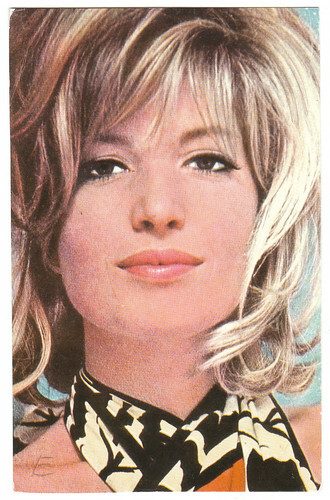
Vintage postcard. Collection: Véronique.
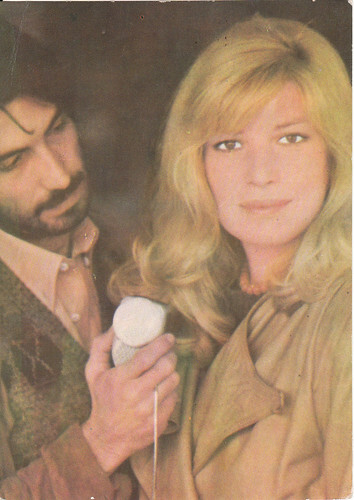
Romanian postcard by Casa Filmului Acin. Collection: Véronique.
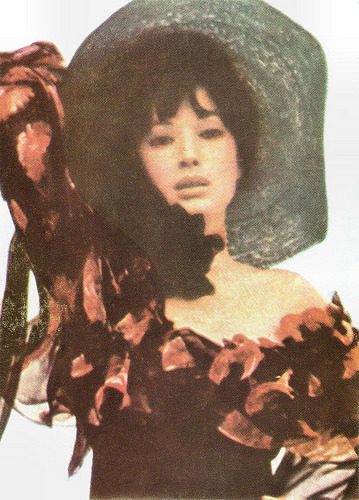
Romanian postcard by Casa Filmului Acin.
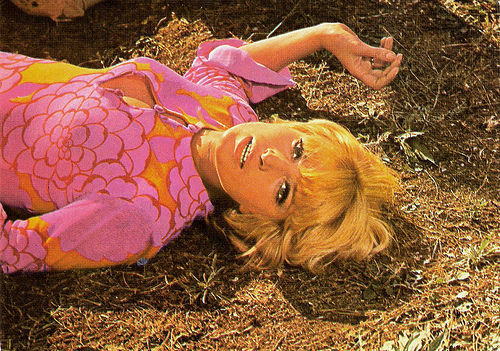
Romanian postcard by Casa Filmului Acin.
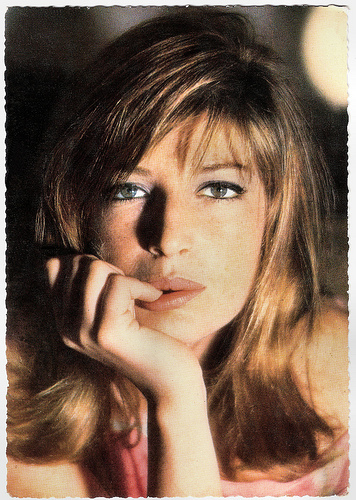
French postcard by E.D.U.G., no. 437. Photo: Sam Lévin.
Secret Scandal
In the mid-1960s Monica Vitti decided to switch genre, and returned to the light comedy that was clearly her forte. After a few uncertain performances, she gained enormous public recognition with La ragazza con la pistola/The Girl with a Pistol (Mario Monicelli, 1968), in which she plays the unlikely role of a Sicilian woman seeking revenge in London.
She achieved ever greater success in Amore mio, aiutami/Help Me My Love (Alberto Sordi, 1969), on the theme of marital infidelity, and Scola's romantic comedy Dramma della gelosia/The Pizza Triangle (Ettore Scola, 1970) about a working-class love triangle with Marcello Mastroianni and Giancarlo Giannini.
Throughout the 1970s Monica Vitti appeared mostly in Italian films which did not have international distribution. There were a few exceptions. She starred in Buñuel's innovative Le Fantôme de la liberté/The Phantom of Liberty (Luis Buñuel, 1974) and the political thriller La raison d'état/State Reasons (André Cayatte, 1978) with Jean Yanne. In 1974 she won the David di Donatello award for Best Actress in Polvere di stelle/Stardust (Alberto Sordi, 1973), an emotional recreation of the world of variety. She won this Italian award five times.
In 1980 after 15 years she reunited with Antonioni for his Il mistero di Oberwald/The Mystery of Oberwald (Michelangelo Antonioni, 1980) which was one of the first major international feature films to be shot on video. Based on a screenplay by Jean Cocteau it tells the story of fugitive Sebastian (Franco Branciaroli), who breaks into the castle at Oberwald to kill the Queen (Monica Vitti) but faints before doing so. He is the spitting image of the King who was assassinated on his wedding day. The Queen discovers that Sebastian once wrote a subversive poem that she liked, even though it was attacking her. The Queen dares Sebastian to kill her, otherwise, she vows to kill him.
During the 1980s Monica Vitti did much less screen work. By 1986 she had returned to the theatre as an actress and teacher. In 1989, Vitti wrote, directed, and starred in Scandalo Segreto/Secret Scandal (1989) with Elliot Gould. The film was well-received critically but met with limited box-office success. She then retired from the cinema. During the 1990s she did television work, both acting and directing. In 1993 she was awarded the Festival Tribute at the Créteil International Women's Film Festival in France.
In 1995 Monica Vitti married photographer Roberto Russo, with whom she had lived since 1975. Alzheimer's disease removed her from the public gaze for the last 15 years.
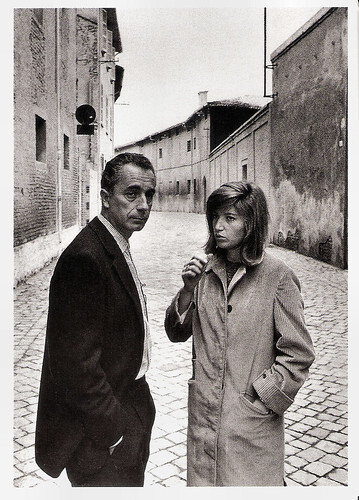
Swiss postcard by News Productions, Baulmes, no. 55806. Photo: John Phillips. Caption: Michelangelo Antonioni and Monica Vitti in a desolate street of Ravenna where they are shooting a scene from The Red Desert. The picture won the Golden Lion at the Venice Film Festival in 164.
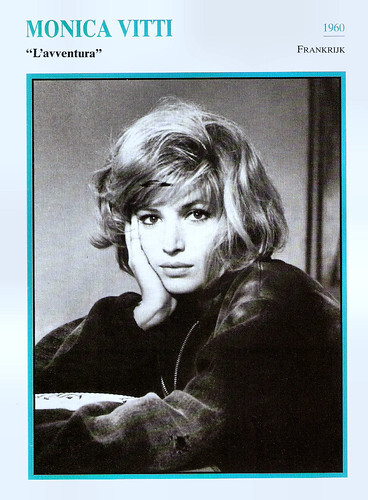
Dutch collectors card in the series 'Filmsterren: een Portret' by Edito Service, 1992. Photo: Monica Vitti in L'avventura/The Adventure (Michelangelo Antonioni, 1960).
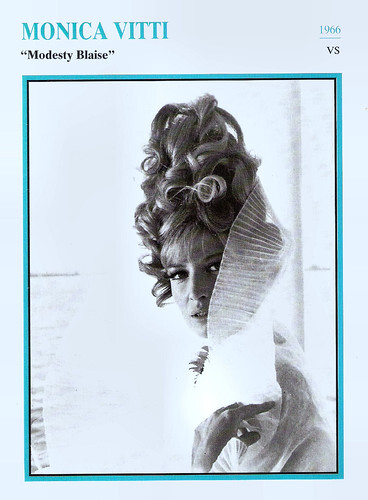
Dutch collectors card in the series 'Filmsterren: een Portret' by Edito-Service, 1992. Photo: Collection Christophe L. Monica Vitti in Modesty Blaise (Jospeh Losey, 1966).
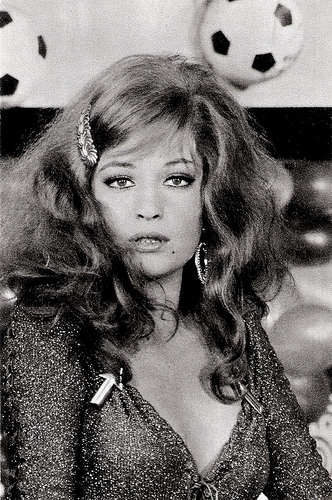
Yugoslavian collectors card by Atheneum, 1971. Photo: Kepes Film.
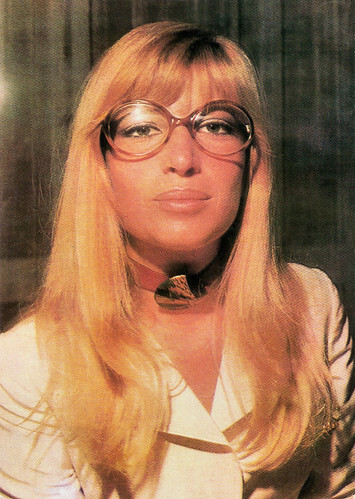
Romanian postcard by Casa Filmului Acin.
Trailer for L'avventura/The Adventure (1960). Source: withlotsabutta (YouTube).
Re-release trailer for L'eclisse/The Eclipse (1962). Source: STUDIOCANAL UK (YouTube).
DVD Trailer for Il deserto rosso/The Red Desert (1964). Source: Criterion Trailers (YouTube).
Trailer for Modesty Blaise (1966). Source: History comes to life (YouTube).
Sources: Hal Erickson (AllMovie), MonicaVitti.com, Rodney Farnsworth (Film Reference), Lenin Imports, Wikipedia, and .

French postcard by PSG for Corvisart, Epinal, no. 437. Photo: Sam Lévin.

Romanian postcard by Casa Filmului Acin, no. 97.

Romanian postcard by Casa Filmului Acin, no. 125.

Italian postcard by Rotalcolor, no. 146.

Vintage collectors card. Photo: Angelo Frontoni.
Turning Point
Monica Vitti was born Maria Luisa Ceciarelli in Rome, in 1931. She studied at Pittman's College, where she played as a teen in a charity performance of Dario Niccodemi's La nemica (The Enemy). She then trained as an actor at the Accademia Nazionale d'Arte Drammatica (Rome's National Academy of Dramatic Arts) where she graduated in 1953.
She toured Germany with an Italian acting troupe and her first stage appearance in Rome was for a production of Niccolò Machiavelli's La Mandragola (The Mandragola). Vitti's film debut was an uncredited bit part in the comedy Ridere! Ridere! Ridere!/Laugh! Laugh! Laugh! (Edoardo Anton, 1954) with Tino Scotti and Ugo Tognazzi . Her first widely noted performance was at the age of 26 in the comedy Le dritte/Smart Girls (Mario Amendola, 1958) starring Franco Fabrizi .
A turning point in her career came in 1957 when she joined Michelangelo Antonioni's Teatro Nuovo di Milano. Three years later she played a leading role in his internationally praised and award-winning film L'avventura/The Adventure (Michelangelo Antonioni, 1960).
In L’avventura a group of rich Italians heads out on a yachting trip to a deserted volcanic island in the Mediterranean. When they are about to leave the island, they find Anna ( Lea Massari ), the main character up to this point, has gone missing. Sandro, Anna's boyfriend ( Gabriele Ferzetti ), and Claudia (Monica Vitti), Anna's friend, try without success to find her. While looking for Anna, Claudia and Sandro develop an attraction for each other. They proceed to become lovers, and all but forget about the missing Anna.
Vitti as the detached and cool Claudia gave a stunning screen presence. She also helped Antonioni raise money for the production and stuck with him through daunting location shooting. L'avventura made Vitti an international star and one of Italy's most famous actresses of the 20th century. Her image later even appeared on an Italian postage stamp commemorating the film.

Romanian postcard by Casa Filmuluii Acin, no. 467. Monica Vitti in Ridere! Ridere! Ridere!/Laugh! Laugh! Laugh! (Edoardo Anton, 1954).

British postcard by BFI and The Screen on the Hill, for the British re-release in 1995. Photo: publicity still for L'avventura (Michelangelo Antonioni, 1960).

Dutch postcard by De Muinck en Co, Amsterdam, no. 809. Photo: publicity still for L'eclisse/The Eclipse (Michelangelo Antonioni, 1962).

Romanian postcard by Casa Filmului Acin. Photo: publicity still for L'eclisse/The Eclipse (Michelangelo Antonioni, 1962) with Alain Delon .

Romanian postcard by Casa Filmului Acin. Photo: publicity still for L'eclisse/The Eclipse (Michelangelo Antonioni, 1962) with Alain Delon .

Romanian postcard by Casa Filmului Acin, no. 305. Monica Vitti and Alain Delon in L'Eclisse/The Eclipse (Michelangelo Antonioni, 1962).

Romanian postcard by Casa Filmului Acin, no. 322. Photo: publicity still for Il deserto rosso/Red Desert (Michelangelo Antonioni, 1964) with Richard Harris.

French postcard by Editions La Malibran, Paris, no CI 3. Photo: Carlo di Palma. Publicity still for Il deserto rosso/Red Desert (Michelangelo Antonioni, 1964).
Modernist Consciousness in the 1960s
Monica Vitti received more critical praise for her starring roles in the next three Antonioni films La notte/The Night (Michelangelo Antonioni, 1961), L'eclisse/The Eclipse (Michelangelo Antonioni, 1962) and Il deserto rosso/The Red Desert (Michelangelo Antonioni, 1964), which are often cited with L'avventura as a series.
In the four films, Antonioni explores modernist consciousness in the 1960s. In her portrayal of deeply troubled middle-class women, unable to establish satisfying relationships and incapable of connecting with their environment, the beautiful Vitti came to embody the modernist dilemma in all its complexity and angst.
Hal Erickson at AllMovie even calls her ‘The high priestess of frosty sensuality’. In La notte she plays the daughter of a wealthy industrialist who tries to inaugurate an empty affair with a married author, played by Marcello Mastroianni . In L’eclisse she plays Vittoria, a young translator who meets the vital broker Piero ( Alain Delon ) during a crash in the Stock Market but the love affair is doomed because of Piero’s materialistic nature. In Il deserto rosso she was Giuliana, a housewife married to a factory manager. She is mentally ill, but hides it from her husband as best she can. She meets the engineer Zeller (Richard Harris) who takes advantage of her distress, and then she is again alone and ill.
She also starred in films by other directors, such as Château en Suède/Nutty Naughty Chateau (Roger Vadim, 1963) with Jean-Claude Brialy , and the comedy Il disco volante/The Flying Saucer (Tinto Brass, 1964) with Alberto Sordi and Silvana Mangano .
Vitti appeared in only two English language films. She starred in the title role of Joseph Losey's Modesty Blaise (1966), a mod James Bond spy spoof with Terence Stamp and Dirk Bogarde which had only mixed success and received harsh critical reviews. Her second English language film was An Almost Perfect Affair (Michael Ritchie, 1979) with Keith Carradine, which takes place during the Cannes Film Festival.

Vintage postcard. Collection: Véronique.

Romanian postcard by Casa Filmului Acin. Collection: Véronique.

Romanian postcard by Casa Filmului Acin.

Romanian postcard by Casa Filmului Acin.

French postcard by E.D.U.G., no. 437. Photo: Sam Lévin.
Secret Scandal
In the mid-1960s Monica Vitti decided to switch genre, and returned to the light comedy that was clearly her forte. After a few uncertain performances, she gained enormous public recognition with La ragazza con la pistola/The Girl with a Pistol (Mario Monicelli, 1968), in which she plays the unlikely role of a Sicilian woman seeking revenge in London.
She achieved ever greater success in Amore mio, aiutami/Help Me My Love (Alberto Sordi, 1969), on the theme of marital infidelity, and Scola's romantic comedy Dramma della gelosia/The Pizza Triangle (Ettore Scola, 1970) about a working-class love triangle with Marcello Mastroianni and Giancarlo Giannini.
Throughout the 1970s Monica Vitti appeared mostly in Italian films which did not have international distribution. There were a few exceptions. She starred in Buñuel's innovative Le Fantôme de la liberté/The Phantom of Liberty (Luis Buñuel, 1974) and the political thriller La raison d'état/State Reasons (André Cayatte, 1978) with Jean Yanne. In 1974 she won the David di Donatello award for Best Actress in Polvere di stelle/Stardust (Alberto Sordi, 1973), an emotional recreation of the world of variety. She won this Italian award five times.
In 1980 after 15 years she reunited with Antonioni for his Il mistero di Oberwald/The Mystery of Oberwald (Michelangelo Antonioni, 1980) which was one of the first major international feature films to be shot on video. Based on a screenplay by Jean Cocteau it tells the story of fugitive Sebastian (Franco Branciaroli), who breaks into the castle at Oberwald to kill the Queen (Monica Vitti) but faints before doing so. He is the spitting image of the King who was assassinated on his wedding day. The Queen discovers that Sebastian once wrote a subversive poem that she liked, even though it was attacking her. The Queen dares Sebastian to kill her, otherwise, she vows to kill him.
During the 1980s Monica Vitti did much less screen work. By 1986 she had returned to the theatre as an actress and teacher. In 1989, Vitti wrote, directed, and starred in Scandalo Segreto/Secret Scandal (1989) with Elliot Gould. The film was well-received critically but met with limited box-office success. She then retired from the cinema. During the 1990s she did television work, both acting and directing. In 1993 she was awarded the Festival Tribute at the Créteil International Women's Film Festival in France.
In 1995 Monica Vitti married photographer Roberto Russo, with whom she had lived since 1975. Alzheimer's disease removed her from the public gaze for the last 15 years.

Swiss postcard by News Productions, Baulmes, no. 55806. Photo: John Phillips. Caption: Michelangelo Antonioni and Monica Vitti in a desolate street of Ravenna where they are shooting a scene from The Red Desert. The picture won the Golden Lion at the Venice Film Festival in 164.

Dutch collectors card in the series 'Filmsterren: een Portret' by Edito Service, 1992. Photo: Monica Vitti in L'avventura/The Adventure (Michelangelo Antonioni, 1960).

Dutch collectors card in the series 'Filmsterren: een Portret' by Edito-Service, 1992. Photo: Collection Christophe L. Monica Vitti in Modesty Blaise (Jospeh Losey, 1966).

Yugoslavian collectors card by Atheneum, 1971. Photo: Kepes Film.

Romanian postcard by Casa Filmului Acin.
Trailer for L'avventura/The Adventure (1960). Source: withlotsabutta (YouTube).
Re-release trailer for L'eclisse/The Eclipse (1962). Source: STUDIOCANAL UK (YouTube).
DVD Trailer for Il deserto rosso/The Red Desert (1964). Source: Criterion Trailers (YouTube).
Trailer for Modesty Blaise (1966). Source: History comes to life (YouTube).
Sources: Hal Erickson (AllMovie), MonicaVitti.com, Rodney Farnsworth (Film Reference), Lenin Imports, Wikipedia, and .
Published on February 02, 2022 22:00
February 1, 2022
Morocco (1930)
Morocco (Josef von Sternberg, 1930) is an American pre-Code classic starring Gary Cooper, Marlene Dietrich, and Adolphe Menjou. Based on the novel 'Amy Jolly' by Benno Vigny and adapted by Jules Furthman, the romantic drama is about a cabaret singer and a Legionnaire who fall in love during the Rif War. Their relationship is complicated by his womanising and the appearance of a rich man who is also in love with her. The film is famous for a scandalous scene in which Dietrich performs a song dressed in a man's tailcoat and kisses another woman. Dietrich was nominated for the Oscar for Best Actress in a Leading Role, von Sternberg for Best Director, Hans Dreier for Best Art Direction, and Lee Garmes for Best Cinematography.
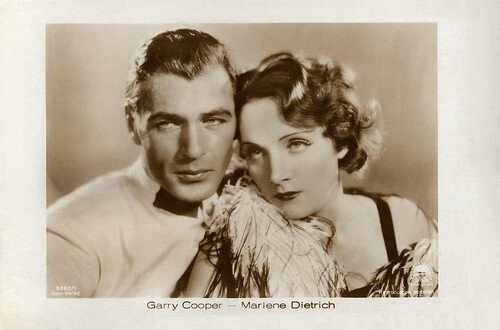
German postcard by Ross Verlag, no. 5380/1, 1930-1931 Photo: Paramount. Gary Cooper and Marlene Dietrich in Morocco (Josef von Sternberg, 1930).
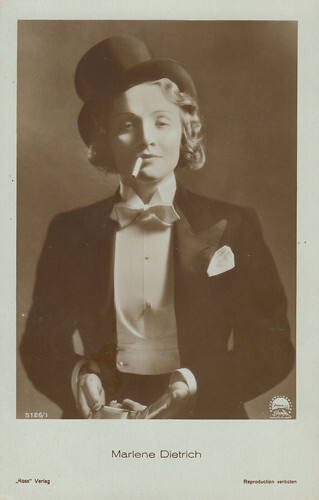
German postcard by Ross Verlag, no. 5126/1, 1930-1931. Photo: Eugene Robert Richee / Paramount. Marlene Dietrich in Morocco (Josef von Sternberg, 1930). Collection: Marlene Pilaete.
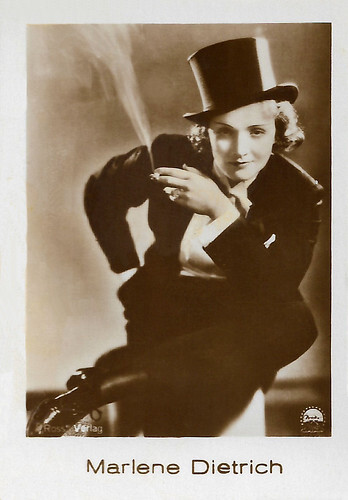
Small German card by Ross Verlag for Hänsom Cigaretten by Jasmatzi Cigaretten-Fabrik G.m.b.H., Dresden, Tonfilmseries, no. 358. Photo: Paramount. Marlene Dietrich in Morocco (Josef von Sternberg, 1930).
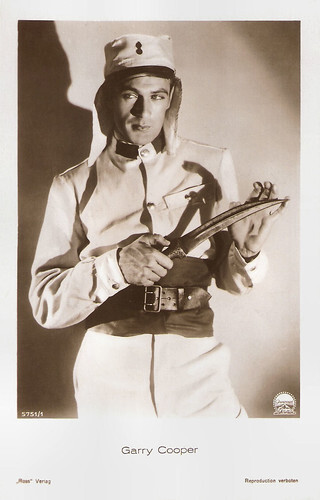
German postcard by Ross Verlag, no. 5751/1, 1930-1931. Photo: Paramount. Gary Cooper in Morocco (Josef von Sternberg, 1930). Caption: Garry Cooper (sic).
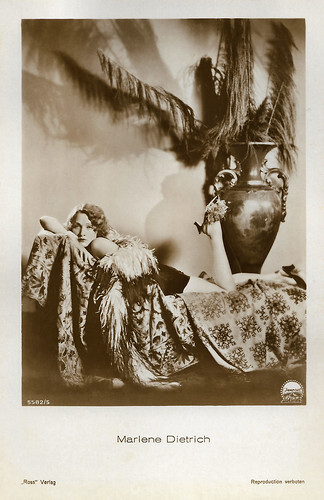
German postcard by Ross Verlag, no. 5582/5, 1930-1931 Photo: Paramount. Marlene Dietrich in Morocco (Josef von Sternberg, 1930).

German postcard by Ross Verlag in the Luxus series, no. 501. Photo: Paramount. Marlene Dietrich in Morocco (Josef von Sternberg, 1930).
The beautiful nightclub singer, the rich gentleman, and the womanising legionnaire
Beautiful young nightclub singer Amy Jolly ( Marlene Dietrich ) arrives in Morocco during the last period of the so-called Pacification of Morocco by the French Army. The rich gentleman La Bessière (Adolphe Menjou) already has his eye on her on the crossing and offers his help, which she refuses.
She manages to get herself an engagement in Lo Tinto's, a Mogador cabaret, and is stormily celebrated by the audience. During her inimitably seductive, tuxedo-clad act, Amy meets the simple but handsome foreign legionnaire Tom Brown (Gary Cooper), who is considered a womaniser, and he notices her. Amy falls in love with Tom. Both bruised by their past lives, the two edge cautiously into a no-strings relationship.
When the adjutant Caesar identifies him as his wife's lover, Tom is interrogated under flimsy circumstances, but Amy is able to defuse the situation for the time being with the help of La Bessière. Tom promises to desert the Foreign Legion for her and go away with her, but leaves her and goes to the front - although he fears that his superior Caesar will take revenge on him. Caesar actually tries to dispose of Tom at the front in an inconspicuous way but falls victim to the rebels' hail of bullets himself.
Amy, disappointed in Tom, accepts La Bessière's marriage proposal after a few weeks. On the evening of the engagement party, the troupe returns without Tom and Amy has to assume that he is injured. During the engagement dinner, Amy leaves the table in a hurry and runs to Brown, with La Bessière accompanying her out of love. He complies and takes her away in his car to frantically search for Tom at the distant troop location.
Amy eventually finds him not in the hospital but in the bistro with another woman: the valiant legionnaire has not been wounded, he has only pretended to be so as not to return to Mogador. He thinks that only a man like La Bessiere can give her the luxurious life she wants. Tom tries to convince Amy that he does not love her, but she finds out that this is not true. The next day he has to go back somewhere in the Sahara. Amy Jolly, who has seen that native women follow the unit where their man is serving on these marches, leaves La Bessière, follows Tom into the Sahara. First, on high heels shoes, then taking her shoes off, and going on naked feet, along with a handful of native women, donkeys, and she-goats.
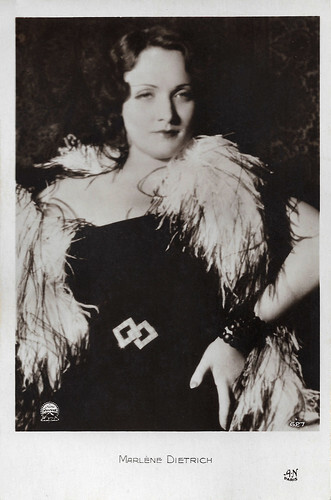
French postcard by A.N., Paris, no. 627. Photo: Paramount. Marlene Dietrich in Morocco (Josef von Sternberg, 1930).
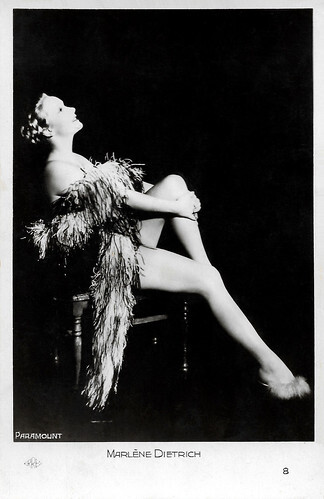
French postcard by Erres, no. 8. Photo: Paramount. Marlene Dietrich in Morocco (Josef von Sternberg, 1930).
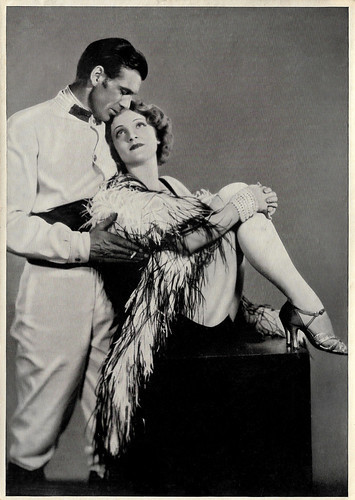
German collectors card by Ross Verlag in the series 'Vom Werden deutscher Filmkunst - Der Tonfilm', album no. 11, picture no. 149. Photo: Paramount / Ross Verlag. Gary Cooper and Marlene Dietrich in Morocco (Herzen in Flammen) (Josef von Sternberg, 1930).
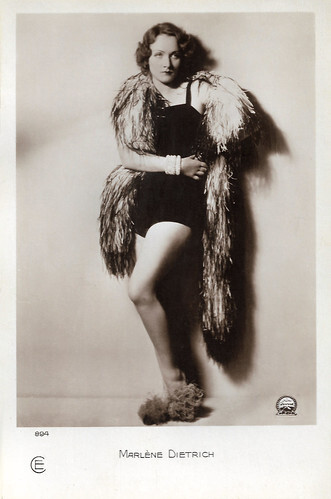
French postcard by Cinémagazine-Selection, no. 894. Photo: Paramount. Marlene Dietrich in Morocco (Josef von Sternberg, 1930).
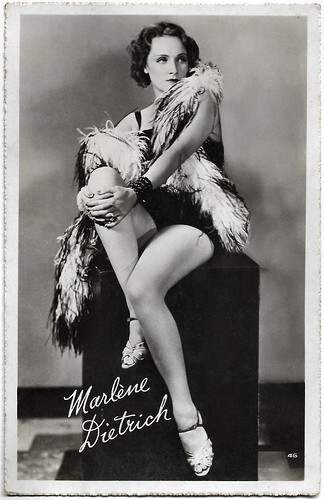
French postcard, no. 46. Photo: Paramount. Marlene Dietrich in Morocco (Josef von Sternberg, 1930).
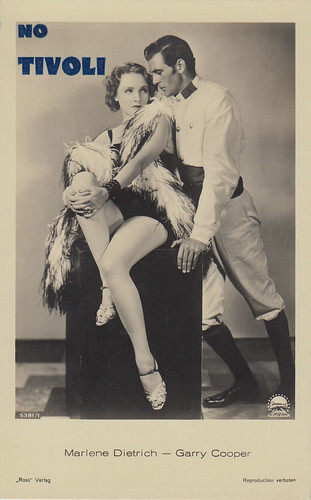
German postcard by Ross Verlag, no. 5381/1, 1930-1931 Photo: Paramount. Gary Cooper and Marlene Dietrich in Morocco (Josef von Sternberg, 1930). Collection: Marlene Pilaete. Please have a close look at this Ross postcard and then compare it with the French postcard above.
One of the first public lesbian kisses shown in cinema
After Der blaue Engel/The Blue Angel (1930), director Josef von Sternberg once again worked with Marlene Dietrich . It was her debut for American audiences. Although Der blaue Engel (1930) had been filmed first and released in Europe, its release in the United States was delayed until Morocco (1930) had played in theatres.
During filming, Gary Cooper was 29 years old and Marlene Dietrich was 28. Marlene Dietrich immediately received an Oscar nomination for Best Actress in a Leading Role for her first English-language film. It was Dietrich's and Josef von Sternberg's second out of seven feature-film collaborations.
Dietrich spoke little English at the time and learned her lines phonetically. According to the actress herself, her first scene, with the line "I won't need any help", was shot 48 or 49 times. Marlene sings three songs in this film, including one in French, 'Quand l'amour meurt' by Georges Millandy.
The kiss on the mouth that Marlene gives to a female spectator at Lo Tinto's, while dressed as a man, is one of the first public lesbian kisses shown in cinema. It was added to the script at Dietrich's suggestion. She herself saved the scene from being cut by the censors when she came up with the idea of taking a flower from the woman before kissing her and then giving the flower to Gary Cooper , explaining that if the censors cut the kiss the appearance of the flower would make no sense. The censors were satisfied with this reasoning.
The screenplay by Jules Furthman was based on the novel 'Amy Jolly, die Frau aus Marrakesch' (Amy Jolly, the Woman from Marrakesh) by Benno Vigny, first published in 1927. The Paramount film premiered on 14 November 1930 at the Rivoli Theatre, New York.
Lucia Bozzola at AllMovie : "Dietrich's Amy Jolly is a sensuous figure of desire and mystery amid von Sternberg's signature mise-en-scene of lushly exotic surroundings, layered shadows, and gauzy fabrics. Her first nightclub performance exudes an androgynous eroticism that would define her star persona: although she eventually sacrifices everything to follow Cooper's Tom Brown across the visually arresting desert sands, the tuxedo-clad Amy accepts a flower from a female admirer and nonchalantly kisses her on the lips before tossing the flower to an equally smitten (and beautified) Cooper. Along with the stunning imagery, von Sternberg inventively used sound to enhance the atmosphere, particularly when Amy makes her final decision between a rich man and the Legionnaire she loves."

British postcard in the Picturegoer Series, no. 520a. Photo: Eugene Robert Richee / Paramount. Marlene Dietrich in Morocco (Josef von Sternberg, 1930). Collection: Marlene Pilaete.
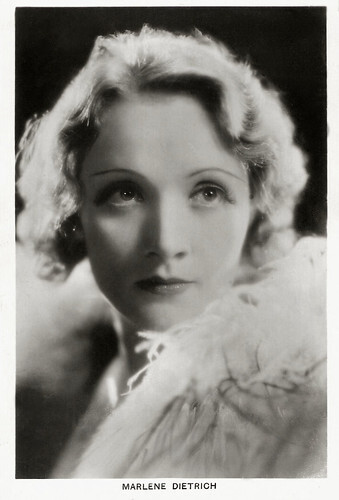
Vintage postcard. Photo: Paramount. Marlene Dietrich in Morocco (Josef von Sternberg, 1930).
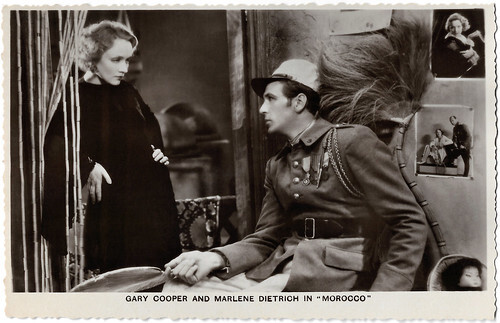
British postcard in the Picturegoer Series, London, no. 517. Photo: Paramount. Gary Cooper and Marlene Dietrich in Morocco (Josef von Sternberg, 1930).
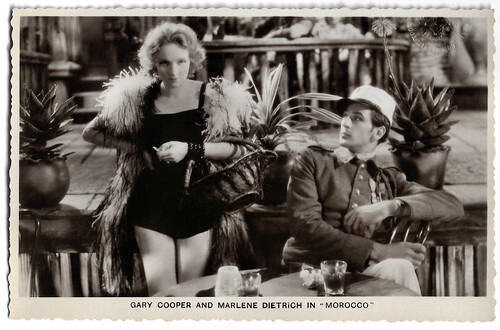
British postcard in the Picturegoer Series, London, no. 518. Photo: Paramount. Gary Cooper and Marlene Dietrich in Morocco (Josef von Sternberg, 1930).
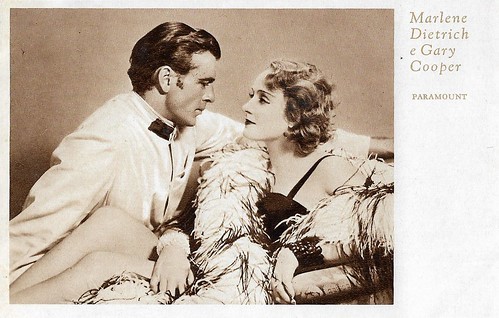
Italian postcard by Cinema-Illustrazione, series 2, no. 31. Photo: Paramount. Marlene Dietrich and Gary Cooper in Morocco (Josef von Sternberg, 1930).
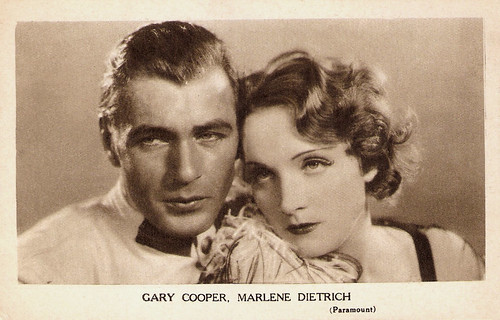
Belgian postcard. Photo: Paramount. Marlene Dietrich and Gary Cooper in Morocco (Josef von Sternberg, 1930).
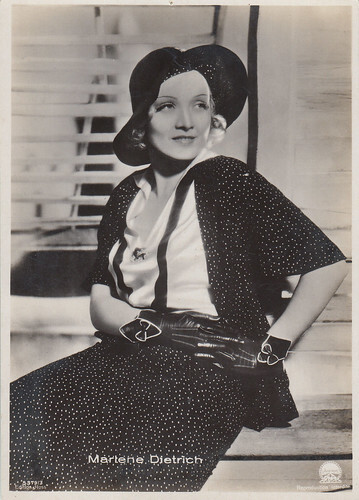
German postcard by Ross Verlag, no. 5379/3, 1930-1931. Photo: Paramount. Marlene Dietrich in Morocco (Josef von Sternberg, 1930). Collection: Marlene Pilaete.
Sources: Lucia Bozzola (AllMovie), Wikipedia (French and German), and IMDb.

German postcard by Ross Verlag, no. 5380/1, 1930-1931 Photo: Paramount. Gary Cooper and Marlene Dietrich in Morocco (Josef von Sternberg, 1930).

German postcard by Ross Verlag, no. 5126/1, 1930-1931. Photo: Eugene Robert Richee / Paramount. Marlene Dietrich in Morocco (Josef von Sternberg, 1930). Collection: Marlene Pilaete.

Small German card by Ross Verlag for Hänsom Cigaretten by Jasmatzi Cigaretten-Fabrik G.m.b.H., Dresden, Tonfilmseries, no. 358. Photo: Paramount. Marlene Dietrich in Morocco (Josef von Sternberg, 1930).

German postcard by Ross Verlag, no. 5751/1, 1930-1931. Photo: Paramount. Gary Cooper in Morocco (Josef von Sternberg, 1930). Caption: Garry Cooper (sic).

German postcard by Ross Verlag, no. 5582/5, 1930-1931 Photo: Paramount. Marlene Dietrich in Morocco (Josef von Sternberg, 1930).

German postcard by Ross Verlag in the Luxus series, no. 501. Photo: Paramount. Marlene Dietrich in Morocco (Josef von Sternberg, 1930).
The beautiful nightclub singer, the rich gentleman, and the womanising legionnaire
Beautiful young nightclub singer Amy Jolly ( Marlene Dietrich ) arrives in Morocco during the last period of the so-called Pacification of Morocco by the French Army. The rich gentleman La Bessière (Adolphe Menjou) already has his eye on her on the crossing and offers his help, which she refuses.
She manages to get herself an engagement in Lo Tinto's, a Mogador cabaret, and is stormily celebrated by the audience. During her inimitably seductive, tuxedo-clad act, Amy meets the simple but handsome foreign legionnaire Tom Brown (Gary Cooper), who is considered a womaniser, and he notices her. Amy falls in love with Tom. Both bruised by their past lives, the two edge cautiously into a no-strings relationship.
When the adjutant Caesar identifies him as his wife's lover, Tom is interrogated under flimsy circumstances, but Amy is able to defuse the situation for the time being with the help of La Bessière. Tom promises to desert the Foreign Legion for her and go away with her, but leaves her and goes to the front - although he fears that his superior Caesar will take revenge on him. Caesar actually tries to dispose of Tom at the front in an inconspicuous way but falls victim to the rebels' hail of bullets himself.
Amy, disappointed in Tom, accepts La Bessière's marriage proposal after a few weeks. On the evening of the engagement party, the troupe returns without Tom and Amy has to assume that he is injured. During the engagement dinner, Amy leaves the table in a hurry and runs to Brown, with La Bessière accompanying her out of love. He complies and takes her away in his car to frantically search for Tom at the distant troop location.
Amy eventually finds him not in the hospital but in the bistro with another woman: the valiant legionnaire has not been wounded, he has only pretended to be so as not to return to Mogador. He thinks that only a man like La Bessiere can give her the luxurious life she wants. Tom tries to convince Amy that he does not love her, but she finds out that this is not true. The next day he has to go back somewhere in the Sahara. Amy Jolly, who has seen that native women follow the unit where their man is serving on these marches, leaves La Bessière, follows Tom into the Sahara. First, on high heels shoes, then taking her shoes off, and going on naked feet, along with a handful of native women, donkeys, and she-goats.

French postcard by A.N., Paris, no. 627. Photo: Paramount. Marlene Dietrich in Morocco (Josef von Sternberg, 1930).

French postcard by Erres, no. 8. Photo: Paramount. Marlene Dietrich in Morocco (Josef von Sternberg, 1930).

German collectors card by Ross Verlag in the series 'Vom Werden deutscher Filmkunst - Der Tonfilm', album no. 11, picture no. 149. Photo: Paramount / Ross Verlag. Gary Cooper and Marlene Dietrich in Morocco (Herzen in Flammen) (Josef von Sternberg, 1930).

French postcard by Cinémagazine-Selection, no. 894. Photo: Paramount. Marlene Dietrich in Morocco (Josef von Sternberg, 1930).

French postcard, no. 46. Photo: Paramount. Marlene Dietrich in Morocco (Josef von Sternberg, 1930).

German postcard by Ross Verlag, no. 5381/1, 1930-1931 Photo: Paramount. Gary Cooper and Marlene Dietrich in Morocco (Josef von Sternberg, 1930). Collection: Marlene Pilaete. Please have a close look at this Ross postcard and then compare it with the French postcard above.
One of the first public lesbian kisses shown in cinema
After Der blaue Engel/The Blue Angel (1930), director Josef von Sternberg once again worked with Marlene Dietrich . It was her debut for American audiences. Although Der blaue Engel (1930) had been filmed first and released in Europe, its release in the United States was delayed until Morocco (1930) had played in theatres.
During filming, Gary Cooper was 29 years old and Marlene Dietrich was 28. Marlene Dietrich immediately received an Oscar nomination for Best Actress in a Leading Role for her first English-language film. It was Dietrich's and Josef von Sternberg's second out of seven feature-film collaborations.
Dietrich spoke little English at the time and learned her lines phonetically. According to the actress herself, her first scene, with the line "I won't need any help", was shot 48 or 49 times. Marlene sings three songs in this film, including one in French, 'Quand l'amour meurt' by Georges Millandy.
The kiss on the mouth that Marlene gives to a female spectator at Lo Tinto's, while dressed as a man, is one of the first public lesbian kisses shown in cinema. It was added to the script at Dietrich's suggestion. She herself saved the scene from being cut by the censors when she came up with the idea of taking a flower from the woman before kissing her and then giving the flower to Gary Cooper , explaining that if the censors cut the kiss the appearance of the flower would make no sense. The censors were satisfied with this reasoning.
The screenplay by Jules Furthman was based on the novel 'Amy Jolly, die Frau aus Marrakesch' (Amy Jolly, the Woman from Marrakesh) by Benno Vigny, first published in 1927. The Paramount film premiered on 14 November 1930 at the Rivoli Theatre, New York.
Lucia Bozzola at AllMovie : "Dietrich's Amy Jolly is a sensuous figure of desire and mystery amid von Sternberg's signature mise-en-scene of lushly exotic surroundings, layered shadows, and gauzy fabrics. Her first nightclub performance exudes an androgynous eroticism that would define her star persona: although she eventually sacrifices everything to follow Cooper's Tom Brown across the visually arresting desert sands, the tuxedo-clad Amy accepts a flower from a female admirer and nonchalantly kisses her on the lips before tossing the flower to an equally smitten (and beautified) Cooper. Along with the stunning imagery, von Sternberg inventively used sound to enhance the atmosphere, particularly when Amy makes her final decision between a rich man and the Legionnaire she loves."

British postcard in the Picturegoer Series, no. 520a. Photo: Eugene Robert Richee / Paramount. Marlene Dietrich in Morocco (Josef von Sternberg, 1930). Collection: Marlene Pilaete.

Vintage postcard. Photo: Paramount. Marlene Dietrich in Morocco (Josef von Sternberg, 1930).

British postcard in the Picturegoer Series, London, no. 517. Photo: Paramount. Gary Cooper and Marlene Dietrich in Morocco (Josef von Sternberg, 1930).

British postcard in the Picturegoer Series, London, no. 518. Photo: Paramount. Gary Cooper and Marlene Dietrich in Morocco (Josef von Sternberg, 1930).

Italian postcard by Cinema-Illustrazione, series 2, no. 31. Photo: Paramount. Marlene Dietrich and Gary Cooper in Morocco (Josef von Sternberg, 1930).

Belgian postcard. Photo: Paramount. Marlene Dietrich and Gary Cooper in Morocco (Josef von Sternberg, 1930).

German postcard by Ross Verlag, no. 5379/3, 1930-1931. Photo: Paramount. Marlene Dietrich in Morocco (Josef von Sternberg, 1930). Collection: Marlene Pilaete.
Sources: Lucia Bozzola (AllMovie), Wikipedia (French and German), and IMDb.
Published on February 01, 2022 22:00
January 31, 2022
Rudi Godden
German singer and film actor Rudi Godden (1907-1941) was notable for his role in Nazi-era musical films such as Hello Janine! (1939) and Robert and Bertram (1939).
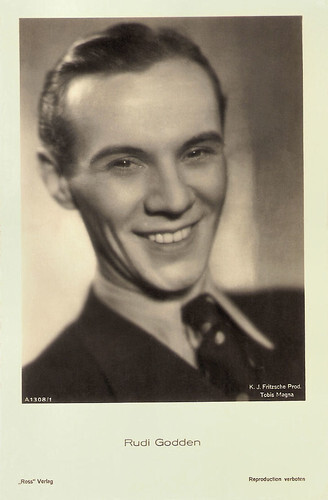
German postcard by Ross Verlag, no. A 1308/1, 1937-1938. Photo: K.J. Fritzsche Productions / Tobis Magna.
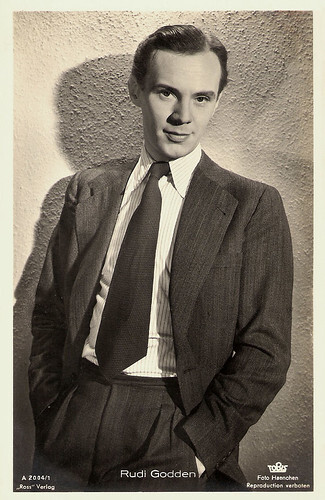
German postcard by Ross Verlag, no. A 2004/1, 1939-1940. Photo: Haenchen / Tobis.
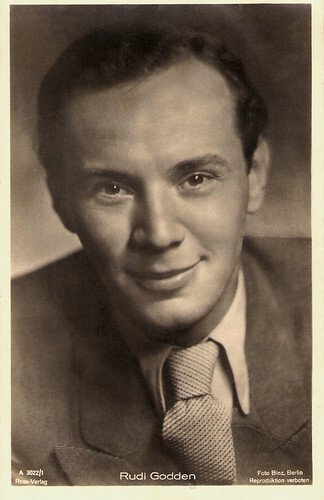
German postcard by Ross Verlag, no. A 3022/1, 1941-1944. Photo: Binz, Berlin.
Blue boys
Rudi Godden was born Rudi Lißbauer in Berlin-Moabit in 1907. He was the son of an Austrian café owner and after the early death of his father, his mother married a Berlin cinema owner, Goddeng, in 1910.
In addition to attending school in Berlin, Rostock, and Hamburg, Godden, who initially wanted to become an opera singer, took singing lessons at the Hamburg Opera School but did not continue.
He started a commercial apprenticeship, which he also broke off. He then became an extra at the Kammerspiele and the Deutsches Schauspielhaus.
From the end of the 1920s, he went on tour in Holland and Germany with the singing quartet 'Blue Boys', which he co-founded. From 1930 he collaborated with Ernst Brenn, with whom he initially performed as a duo in Germany and abroad.
Since 1935 he was a member of the cabaret 'Die acht Entfesselten' (The Eight Unleashed), which is endorsed by the Nazis as non-political entertainment. Godden performs together with Gerti von Reichenhall, whom he marries in 1937. In 1939 the 'Entfesselten' are disbanded.
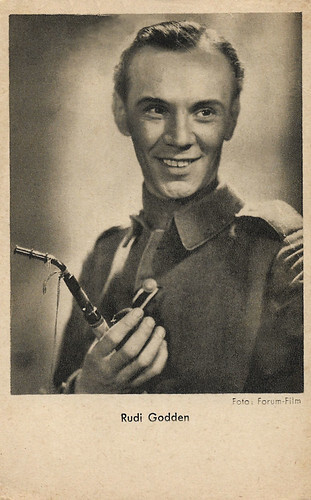
German card by Das Programm von Heute, Berlin. Photo: Forum-Film. Rudi Godden in Musketier Meier III/Musketeer Meier III (Joe Stöckel, 1938).
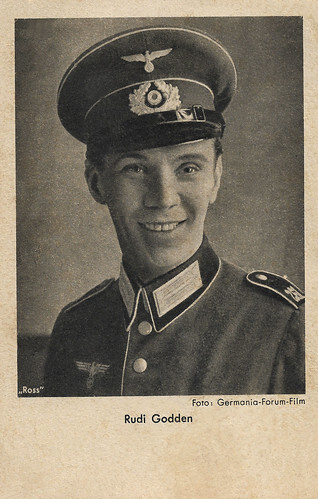
German card by Ross Verlag. Photo: Germania / Forum-Film. Rudi Godden in Das Gewehr über/Shoulder Arms (Jürgen von Alten, 1939).
The charming, always good-humoured boy next door
In 1936 Rudi Godden accepted a contract with Tobis. His film debut was as the cheerful stage manager Peters in the variety film Truxa (Hans H. Zerlett, 1937) with La Jana .
Major roles followed from 1937 to 1940, including one of the title roles (Robert) in the anti-Semitic musical comedy Robert und Bertram (Hans H. Zerlett, 1939) with Kurt Seifert as Bertram.
In the revue film Hallo Janine/Hello Janine! (Carl Boese, 1939), he sang the hit song 'Musik, Musik, Musik' ("I don't need millions, I don't lack a penny for happiness...") with Marika Rökk and Johannes Heesters .
In his films, Godden played the charming, always good-humoured boy next door. An exception was the film Das Leben kann so schön sein/Life Can Be So Beautiful (Rolf Hansen, 1938), in which he took on a serious role for the first time. The film was banned and was only released after the war.
He also appeared in the propaganda film Das Gewehr Űber/Shoulder Arms (Jürgen von Alten, 1939). Besides his film work, he appeared in operetta productions at the Admiralspalast and the Metropol, among others, he played the male lead in Schmidseder's 'Frauen im Metropol'.
Rudi Godden died unexpectedly in 1941 at the age of only 33, as a result of the aftereffects of blood poisoning. His grave in the Old Twelve Apostles Churchyard in Berlin-Schöneberg has been preserved. He was married to the cabaret artist Gerti Godden from 1937.
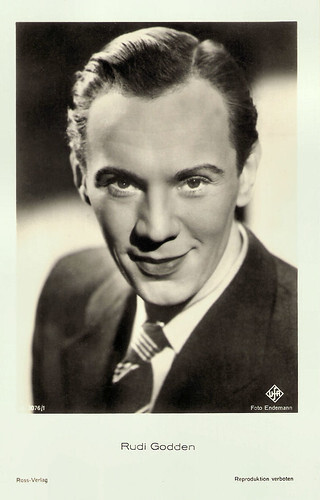
German postcard by Ross Verlag, no. A 1076/1, 1938-1939. Photo: Endemann / Ufa.
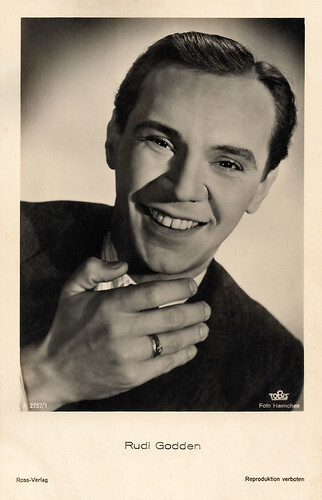
German postcard by Ross Verlag, no. A 2757/1, 1939-1940. Photo: Haenchen / Tobis.
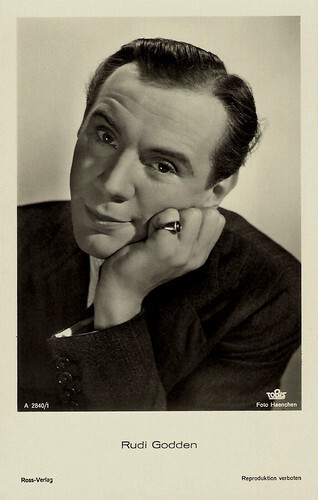
German postcard by Ross Verlag, no. A 2840/1, 1939-1940. Photo: Haenchen / Tobis.
Sources: Filmportal.de (German), Wikipedia (German and English), and .

German postcard by Ross Verlag, no. A 1308/1, 1937-1938. Photo: K.J. Fritzsche Productions / Tobis Magna.

German postcard by Ross Verlag, no. A 2004/1, 1939-1940. Photo: Haenchen / Tobis.

German postcard by Ross Verlag, no. A 3022/1, 1941-1944. Photo: Binz, Berlin.
Blue boys
Rudi Godden was born Rudi Lißbauer in Berlin-Moabit in 1907. He was the son of an Austrian café owner and after the early death of his father, his mother married a Berlin cinema owner, Goddeng, in 1910.
In addition to attending school in Berlin, Rostock, and Hamburg, Godden, who initially wanted to become an opera singer, took singing lessons at the Hamburg Opera School but did not continue.
He started a commercial apprenticeship, which he also broke off. He then became an extra at the Kammerspiele and the Deutsches Schauspielhaus.
From the end of the 1920s, he went on tour in Holland and Germany with the singing quartet 'Blue Boys', which he co-founded. From 1930 he collaborated with Ernst Brenn, with whom he initially performed as a duo in Germany and abroad.
Since 1935 he was a member of the cabaret 'Die acht Entfesselten' (The Eight Unleashed), which is endorsed by the Nazis as non-political entertainment. Godden performs together with Gerti von Reichenhall, whom he marries in 1937. In 1939 the 'Entfesselten' are disbanded.

German card by Das Programm von Heute, Berlin. Photo: Forum-Film. Rudi Godden in Musketier Meier III/Musketeer Meier III (Joe Stöckel, 1938).

German card by Ross Verlag. Photo: Germania / Forum-Film. Rudi Godden in Das Gewehr über/Shoulder Arms (Jürgen von Alten, 1939).
The charming, always good-humoured boy next door
In 1936 Rudi Godden accepted a contract with Tobis. His film debut was as the cheerful stage manager Peters in the variety film Truxa (Hans H. Zerlett, 1937) with La Jana .
Major roles followed from 1937 to 1940, including one of the title roles (Robert) in the anti-Semitic musical comedy Robert und Bertram (Hans H. Zerlett, 1939) with Kurt Seifert as Bertram.
In the revue film Hallo Janine/Hello Janine! (Carl Boese, 1939), he sang the hit song 'Musik, Musik, Musik' ("I don't need millions, I don't lack a penny for happiness...") with Marika Rökk and Johannes Heesters .
In his films, Godden played the charming, always good-humoured boy next door. An exception was the film Das Leben kann so schön sein/Life Can Be So Beautiful (Rolf Hansen, 1938), in which he took on a serious role for the first time. The film was banned and was only released after the war.
He also appeared in the propaganda film Das Gewehr Űber/Shoulder Arms (Jürgen von Alten, 1939). Besides his film work, he appeared in operetta productions at the Admiralspalast and the Metropol, among others, he played the male lead in Schmidseder's 'Frauen im Metropol'.
Rudi Godden died unexpectedly in 1941 at the age of only 33, as a result of the aftereffects of blood poisoning. His grave in the Old Twelve Apostles Churchyard in Berlin-Schöneberg has been preserved. He was married to the cabaret artist Gerti Godden from 1937.

German postcard by Ross Verlag, no. A 1076/1, 1938-1939. Photo: Endemann / Ufa.

German postcard by Ross Verlag, no. A 2757/1, 1939-1940. Photo: Haenchen / Tobis.

German postcard by Ross Verlag, no. A 2840/1, 1939-1940. Photo: Haenchen / Tobis.
Sources: Filmportal.de (German), Wikipedia (German and English), and .
Published on January 31, 2022 22:00
January 30, 2022
La Collectionneuse: Salome
In 2021, small fragments of Theda Bara’s Salome (1918) were made available to the public in a digitalised form. Those brief clips had been found in Madrid’s Filmoteca Espanola. It was tremendous news to silent film lovers, as most of Bara’s films are considered lost.
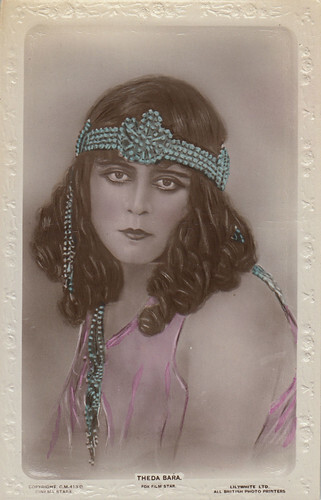
British postcard by Lilywhite in the Cinema Stars series, no. C.M. 413D. Photo: William Fox. Theda Bara in Salome (J. Gordon Edwards, 1918). Collection: Marlene Pilaete.
The Salome character
Salome is a biblical character who is mentioned, although unnamed, in the Gospel of Mark and the Gospel of Mathew. She was the daughter of Herod II and Herodias. Her mother, after her divorce, remarried Herod Antipas. This second marriage was heavily criticised by John the Baptist.
The young girl danced before King Herod Antipas at his birthday celebration and he was so enthralled by his stepdaughter’s performance that he told her that she could ask anything in return for it. Prompted by her mother, she asked for John the Baptist’s head.
Despite his reluctance, the King had to keep his promise. The prophet was executed and his head was given to her on a platter. The dancer is called "Salome" for the first time in Flavius Josephus’ 'Antiquities of the Jews', published in AD 93 or 94.
Salome is certainly one of the most famous female biblical characters. She has been painted by renowned artists such as Van der Weyden, Memling, Cranach, Rubens, Botticelli, Titian, Caravaggio, and Gustave Moreau
In 1891, Oscar Wilde wrote his play 'Salome'. It was first published in France in 1893 and then in England, illustrated by Aubrey Beardsley, in 1894. Wilde never saw his play produced on stage. It was banned in the U.K. until 1931 and the only performances given in his lifetime took place in France in 1896, when he was in jail for homosexuality.
In 1905, Richard Strauss’ opera 'Salome', which was inspired by Wilde’s play, opened in Dresden. It is said that, at the time, the dance of the seven veils performed by Salome shocked the audiences. The Salome character also appeared several times in movies. Arguably the three more famous screen Salomes were Theda Bara, Alla Nazimova , and Rita Hayworth
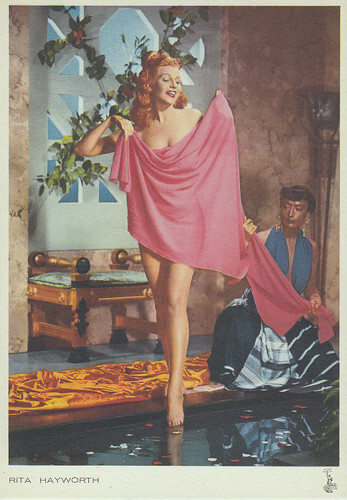
Argentinian postcard by Cromocart G.W., no. 143. Photo: Columbia. Rita Hayworth in Salome (William Dieterle, 1953). Collection: Marlene Pilaete.
Here is a non-exhaustive selection of several Salome-related stars.Maud Allan

British postcard by Rotary Photo E.C., no. 4946 D. Photo: Foulsham & Banfield. Miss Maud Allan as Salomé. Collection: Marlene Pilaete.
Canadian-born Maud Allan (1873-1956) became a star when she created a dance number called 'Vision of Salomé' in Vienna (Austria) in 1906 and soon became famous internationally. In 1915 she starred in her only movie, The Rug Maker’s Daughter, filmed in California. She played a Turkish girl who falls in love with an American. The film is now considered lost but it was said at the time that the three Oriental dances she performed in it had similarities to her famous Salomé dance. In 1918, after having been accused in an article of being involved in a pro-German conspiracy and of being linked to a circle of sexual deviants, she sued for libel. During the sensational trial that took place in London, it was revealed that her brother had been hanged for murder in 1898. She lost the case and her career never recovered from the scandal. Although she still performed until 1936, her days of glory were gone. She died penniless in the U.S.A. in 1956.
Lyda Borelli
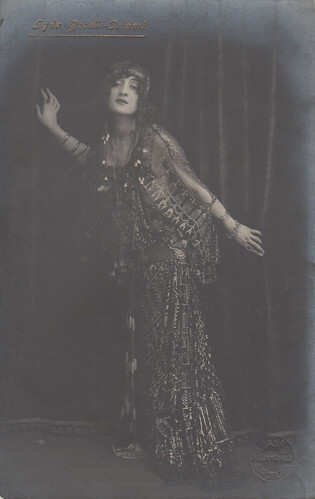
Spanish postcard by Amadeo, Pelayo 62, Barcelona. Lyda Borelli in an outfit for Oscar Wilde's stage play 'Salome'. Collection: Marlene Pilaete.
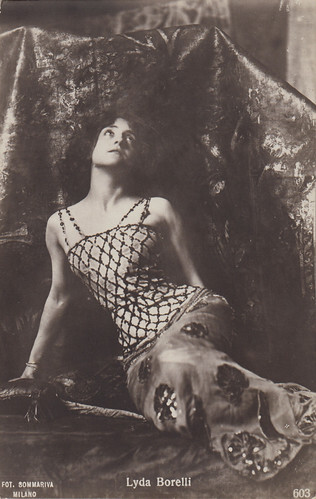
Italian postcard, no. 603. Photo: Emilio Sommariva, Milano. Lyda Borelli in an outfit for Oscar Wilde's stage play 'Salome'. Collection: Marlene Pilaete.
Before she became one of the most famous Italian film divas, Lyda Borelli (1884-1959) was a well-known theater actress. One of her major roles on the stage was Oscar Wilde’s 'Salome'.
Theda Bara
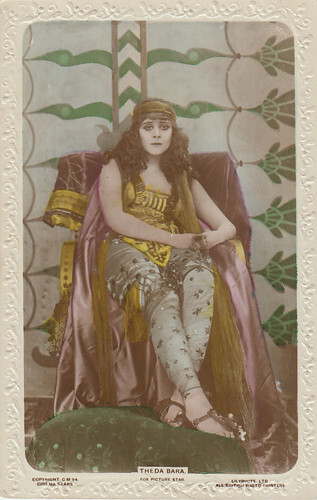
British postcard by Lilywhite in the Cinema Stars series, no. C.M. 94. Photo: William Fox. Theda Bara in Salome (J. Gordon Edwards, 1918). Collection: Marlene Pilaete.
Salome (1918) was a big-budgeted epic that starred Fox’s reigning vamp, Theda Bara (1885-1955), who had become a star thanks to A Fool There Was (1915). It was released in August 1918 and, that same month, the actress came tenth in a popularity poll held by Motion Picture Magazine. The movie was a success. Unfortunately, Theda’s Bara career went into decline in 1919, and, at the end of the year, Fox didn’t renew her contract.
Pearl White
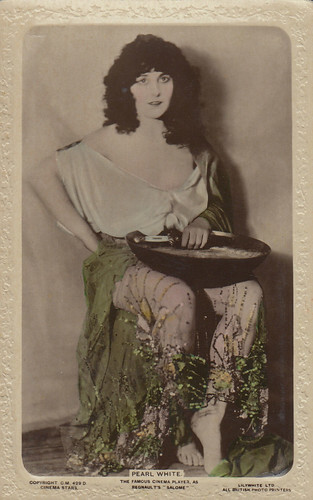
British postcard by Lilywhite Ltd, no. C.M. 429 D. Pearl White as Salome. Collection: Marlene Pilaete.
Serial queen Pearl White (1889-1938) never played Salome on screen but a photographer had the idea to make her pose as the biblical character. This shot was inspired by a 1870 painting by Henri Regnault, which is currently in the collection of the Metropolitan Museum of Art in New York.
Alla Nazimova
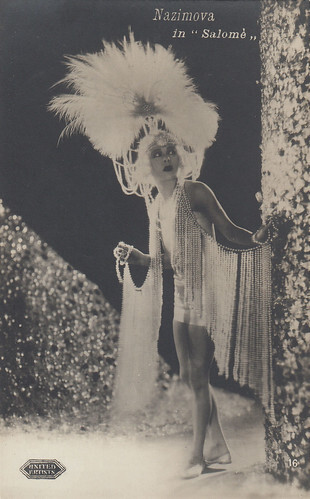
Italian postcard by Casa Editrice Ballerini & Fratini, no. 16. Photo: United Artists. Alla Nazimova in Salome (Charles Bryant, 1923). Collection: Marlene Pilaete.
Salome (1922) was produced by Alla Nazimova (1879-1945) and was adapted from Oscar Wilde’s play. Inspired by Aubrey Beardsley’s illustrations, Natacha Rambova, who became Rudolph Valentino’s second wife in 1923, designed the costumes and the sets. Although she was over forty, Nazimova decided to play herself the teenage heroine. The movie divided the critics and was a commercial flop. It was certainly too theatrical and sophisticated for standard audiences. Nazimova suffered important financial losses and it was the beginning of a difficult period for her. She had to wait until her performance on Broadway in 'The Cherry Orchard' in 1928 to fully regain her prestige. Over the years, Nazimova’s Salome has acquired cult status.
Gloria Swanson
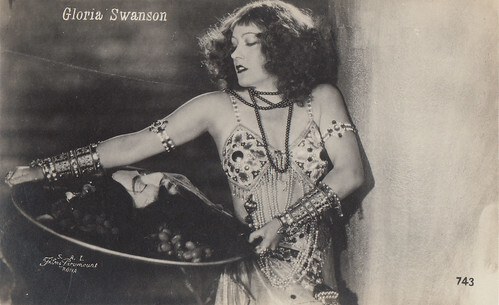
Italian postcard by Casa Editrice Ballerini & Fratini, no. 743. Photo: S.A.I. Films Paramount, Roma. Gloria Swanson in Stage Struck (Allan Dwan, 1925). Collection: Marlene Pilaete.
In Allan Dwan’s Stage Struck (1925), Gloria Swanson (1897? 1899?-1983) plays a diner waitress who dreams of becoming an actress. She is seen as Salome in a 2-color Technicolor fantasy sequence, in which she imagines herself playing the biblical dancer. The movie, which displayed Swanson’s gift for comedy, is usually considered as one of her best silent films.
Yvonne De Carlo
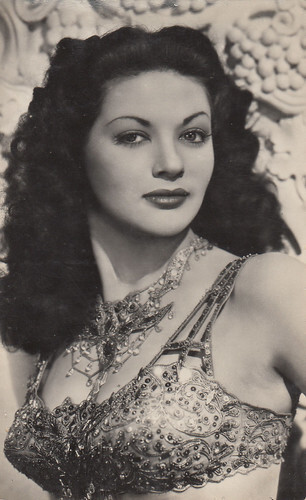
Spanish postcard by Archivo Bermejo, Barcelona, no. 3299. Photo: Universal. Yvonne De Carlo in Salome Where She Danced (Charles Lamont, 1945). Collection: Marlene Pilaete.
Salome Where She Danced (1944) made Yvonne De Carlo (1922-2007) a star. She plays a Viennese dancer who has to flee to the U.S.A. during the Austro-Prussian War. In a small Arizona town, she is a big hit on stage by portraying Salome in a "daring" dance number.
Rita Hayworth

Italian postcard by B.F.F. Edit., no. 2863. Photo: Columbia. Rita Hayworth in Salome (William Dieterle, 1953). Collection: Marlene Pilaete.
Rita Hayworth (1918-1987) starred in Salome (1953) in which the heroine is portrayed as an innocent, outwitted by her mother’s machinations. In the plot, Salome is convinced that she dances to save John the Baptist and is understandably shocked when she realises that she had been cheated. It was directed by veteran William Dieterle and Rita was supported by top-notch British performers: Stewart Granger as her love interest, Charles Laughton as Herod, Cedric Hardwicke as Tiberius Caesar, and Basil Sydney as Pontius Pilatus. Australian-born Judith Anderson rounded the cast by playing Herodias. The film was a hit with the audiences and came second in the list of Columbia’s 1953 top box-office attractions.
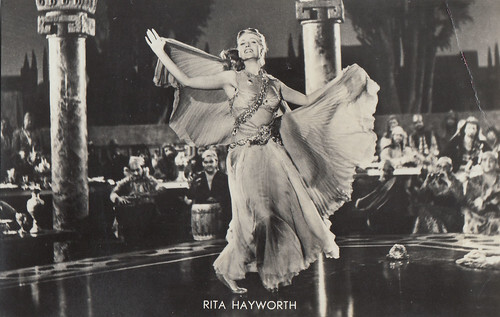
Vintage postcard. Photo: Columbia. Rita Hayworth in Salome (William Dieterle, 1953). Collection: Marlene Pilaete.
Bonus: Ivo Blom’s Salomes
Ivo Blom wished to include an Oscar Wilde’s German-born Salome and a 1941 Italian comedy in which a young lady is asked to pass herself for the famous dancer who has grown older. A funny story far from the tragic biblical story.
Hedwig Reicher
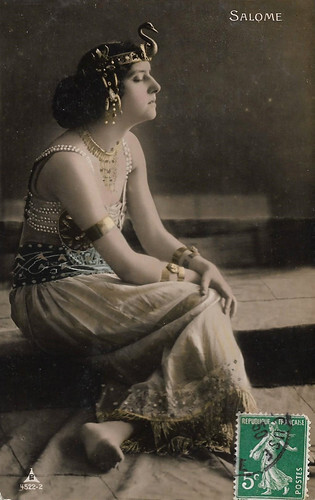
German postcard, no. PH 4522/2. Mailed in France.
German-born stage and screen actress Hedwig(a) Reicher (1884-1971) made her theatrical debut in 1902 in Adolf von Wilbrandt's 'Der Meister von Palmyra' in Hamburg. She remained in Germany for five more years before accepting an engagement to the Deutsches Theater (the Irving Place Theatre) in New York City in 1907. Reicher remained in the United States and appeared on Broadway. In 1916 she performed Oscar Wilde's Salome at the Punch & Judy's Theatre, a role she had already performed in Germany. In the 1920s, Richer played a number of supporting roles in Hollywood, as an immigrant or in maternal roles. She played the prison matron in Cecil B. DeMille's The Godless Girl (1928) and Janet Gaynor's mother in Lucky Star (1929) by Frank Borzage. In 1939, she appeared in the first decidedly anti-Nazi film, Confessions of a Nazi Spy.
La nascita di Salomè (1940)
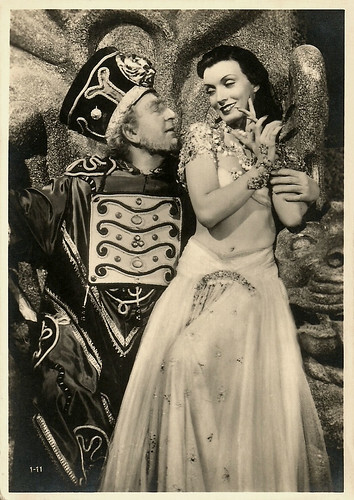
Italian postcard. Armando Falconi and Conchita Montenegro in the Italo-Spanish coproduction La nascita di Salomè (1940), directed by Jean Choux, and shot in the Cinecittà studios in Rome.
In the comedy, La nascita di Salomè (Jean Choux, 1940), based on a stage play by Cesare Meano, the mighty King of the Parthians (Nerio Bernardi) offers Aristobulus (Armando Falconi), monarch of a small kingdom, four provinces in exchange for his wife Salome, (once) a beautiful dancer (Maria Gomez). Aristobulus instead sends him a pretty, skilled young dancer named Dalila ( Conchita Montenegro ), and thus a new Salome is born, able to captivate all men. The envoys of the Parthian King discover the fraud, but, fascinated, they pretend that there has been no deception and lead the girl at their sovereign, who remains very impressed and gives Aristobulus the promised provinces. The exotic costumes for the film were designed by Gino Carlo Sensani and Maria de Matteis.
Text and postcards: Marlene Pilaete and Ivo Blom.

British postcard by Lilywhite in the Cinema Stars series, no. C.M. 413D. Photo: William Fox. Theda Bara in Salome (J. Gordon Edwards, 1918). Collection: Marlene Pilaete.
The Salome character
Salome is a biblical character who is mentioned, although unnamed, in the Gospel of Mark and the Gospel of Mathew. She was the daughter of Herod II and Herodias. Her mother, after her divorce, remarried Herod Antipas. This second marriage was heavily criticised by John the Baptist.
The young girl danced before King Herod Antipas at his birthday celebration and he was so enthralled by his stepdaughter’s performance that he told her that she could ask anything in return for it. Prompted by her mother, she asked for John the Baptist’s head.
Despite his reluctance, the King had to keep his promise. The prophet was executed and his head was given to her on a platter. The dancer is called "Salome" for the first time in Flavius Josephus’ 'Antiquities of the Jews', published in AD 93 or 94.
Salome is certainly one of the most famous female biblical characters. She has been painted by renowned artists such as Van der Weyden, Memling, Cranach, Rubens, Botticelli, Titian, Caravaggio, and Gustave Moreau
In 1891, Oscar Wilde wrote his play 'Salome'. It was first published in France in 1893 and then in England, illustrated by Aubrey Beardsley, in 1894. Wilde never saw his play produced on stage. It was banned in the U.K. until 1931 and the only performances given in his lifetime took place in France in 1896, when he was in jail for homosexuality.
In 1905, Richard Strauss’ opera 'Salome', which was inspired by Wilde’s play, opened in Dresden. It is said that, at the time, the dance of the seven veils performed by Salome shocked the audiences. The Salome character also appeared several times in movies. Arguably the three more famous screen Salomes were Theda Bara, Alla Nazimova , and Rita Hayworth

Argentinian postcard by Cromocart G.W., no. 143. Photo: Columbia. Rita Hayworth in Salome (William Dieterle, 1953). Collection: Marlene Pilaete.
Here is a non-exhaustive selection of several Salome-related stars.Maud Allan

British postcard by Rotary Photo E.C., no. 4946 D. Photo: Foulsham & Banfield. Miss Maud Allan as Salomé. Collection: Marlene Pilaete.
Canadian-born Maud Allan (1873-1956) became a star when she created a dance number called 'Vision of Salomé' in Vienna (Austria) in 1906 and soon became famous internationally. In 1915 she starred in her only movie, The Rug Maker’s Daughter, filmed in California. She played a Turkish girl who falls in love with an American. The film is now considered lost but it was said at the time that the three Oriental dances she performed in it had similarities to her famous Salomé dance. In 1918, after having been accused in an article of being involved in a pro-German conspiracy and of being linked to a circle of sexual deviants, she sued for libel. During the sensational trial that took place in London, it was revealed that her brother had been hanged for murder in 1898. She lost the case and her career never recovered from the scandal. Although she still performed until 1936, her days of glory were gone. She died penniless in the U.S.A. in 1956.
Lyda Borelli

Spanish postcard by Amadeo, Pelayo 62, Barcelona. Lyda Borelli in an outfit for Oscar Wilde's stage play 'Salome'. Collection: Marlene Pilaete.

Italian postcard, no. 603. Photo: Emilio Sommariva, Milano. Lyda Borelli in an outfit for Oscar Wilde's stage play 'Salome'. Collection: Marlene Pilaete.
Before she became one of the most famous Italian film divas, Lyda Borelli (1884-1959) was a well-known theater actress. One of her major roles on the stage was Oscar Wilde’s 'Salome'.
Theda Bara

British postcard by Lilywhite in the Cinema Stars series, no. C.M. 94. Photo: William Fox. Theda Bara in Salome (J. Gordon Edwards, 1918). Collection: Marlene Pilaete.
Salome (1918) was a big-budgeted epic that starred Fox’s reigning vamp, Theda Bara (1885-1955), who had become a star thanks to A Fool There Was (1915). It was released in August 1918 and, that same month, the actress came tenth in a popularity poll held by Motion Picture Magazine. The movie was a success. Unfortunately, Theda’s Bara career went into decline in 1919, and, at the end of the year, Fox didn’t renew her contract.
Pearl White

British postcard by Lilywhite Ltd, no. C.M. 429 D. Pearl White as Salome. Collection: Marlene Pilaete.
Serial queen Pearl White (1889-1938) never played Salome on screen but a photographer had the idea to make her pose as the biblical character. This shot was inspired by a 1870 painting by Henri Regnault, which is currently in the collection of the Metropolitan Museum of Art in New York.
Alla Nazimova

Italian postcard by Casa Editrice Ballerini & Fratini, no. 16. Photo: United Artists. Alla Nazimova in Salome (Charles Bryant, 1923). Collection: Marlene Pilaete.
Salome (1922) was produced by Alla Nazimova (1879-1945) and was adapted from Oscar Wilde’s play. Inspired by Aubrey Beardsley’s illustrations, Natacha Rambova, who became Rudolph Valentino’s second wife in 1923, designed the costumes and the sets. Although she was over forty, Nazimova decided to play herself the teenage heroine. The movie divided the critics and was a commercial flop. It was certainly too theatrical and sophisticated for standard audiences. Nazimova suffered important financial losses and it was the beginning of a difficult period for her. She had to wait until her performance on Broadway in 'The Cherry Orchard' in 1928 to fully regain her prestige. Over the years, Nazimova’s Salome has acquired cult status.
Gloria Swanson

Italian postcard by Casa Editrice Ballerini & Fratini, no. 743. Photo: S.A.I. Films Paramount, Roma. Gloria Swanson in Stage Struck (Allan Dwan, 1925). Collection: Marlene Pilaete.
In Allan Dwan’s Stage Struck (1925), Gloria Swanson (1897? 1899?-1983) plays a diner waitress who dreams of becoming an actress. She is seen as Salome in a 2-color Technicolor fantasy sequence, in which she imagines herself playing the biblical dancer. The movie, which displayed Swanson’s gift for comedy, is usually considered as one of her best silent films.
Yvonne De Carlo

Spanish postcard by Archivo Bermejo, Barcelona, no. 3299. Photo: Universal. Yvonne De Carlo in Salome Where She Danced (Charles Lamont, 1945). Collection: Marlene Pilaete.
Salome Where She Danced (1944) made Yvonne De Carlo (1922-2007) a star. She plays a Viennese dancer who has to flee to the U.S.A. during the Austro-Prussian War. In a small Arizona town, she is a big hit on stage by portraying Salome in a "daring" dance number.
Rita Hayworth

Italian postcard by B.F.F. Edit., no. 2863. Photo: Columbia. Rita Hayworth in Salome (William Dieterle, 1953). Collection: Marlene Pilaete.
Rita Hayworth (1918-1987) starred in Salome (1953) in which the heroine is portrayed as an innocent, outwitted by her mother’s machinations. In the plot, Salome is convinced that she dances to save John the Baptist and is understandably shocked when she realises that she had been cheated. It was directed by veteran William Dieterle and Rita was supported by top-notch British performers: Stewart Granger as her love interest, Charles Laughton as Herod, Cedric Hardwicke as Tiberius Caesar, and Basil Sydney as Pontius Pilatus. Australian-born Judith Anderson rounded the cast by playing Herodias. The film was a hit with the audiences and came second in the list of Columbia’s 1953 top box-office attractions.

Vintage postcard. Photo: Columbia. Rita Hayworth in Salome (William Dieterle, 1953). Collection: Marlene Pilaete.
Bonus: Ivo Blom’s Salomes
Ivo Blom wished to include an Oscar Wilde’s German-born Salome and a 1941 Italian comedy in which a young lady is asked to pass herself for the famous dancer who has grown older. A funny story far from the tragic biblical story.
Hedwig Reicher

German postcard, no. PH 4522/2. Mailed in France.
German-born stage and screen actress Hedwig(a) Reicher (1884-1971) made her theatrical debut in 1902 in Adolf von Wilbrandt's 'Der Meister von Palmyra' in Hamburg. She remained in Germany for five more years before accepting an engagement to the Deutsches Theater (the Irving Place Theatre) in New York City in 1907. Reicher remained in the United States and appeared on Broadway. In 1916 she performed Oscar Wilde's Salome at the Punch & Judy's Theatre, a role she had already performed in Germany. In the 1920s, Richer played a number of supporting roles in Hollywood, as an immigrant or in maternal roles. She played the prison matron in Cecil B. DeMille's The Godless Girl (1928) and Janet Gaynor's mother in Lucky Star (1929) by Frank Borzage. In 1939, she appeared in the first decidedly anti-Nazi film, Confessions of a Nazi Spy.
La nascita di Salomè (1940)

Italian postcard. Armando Falconi and Conchita Montenegro in the Italo-Spanish coproduction La nascita di Salomè (1940), directed by Jean Choux, and shot in the Cinecittà studios in Rome.
In the comedy, La nascita di Salomè (Jean Choux, 1940), based on a stage play by Cesare Meano, the mighty King of the Parthians (Nerio Bernardi) offers Aristobulus (Armando Falconi), monarch of a small kingdom, four provinces in exchange for his wife Salome, (once) a beautiful dancer (Maria Gomez). Aristobulus instead sends him a pretty, skilled young dancer named Dalila ( Conchita Montenegro ), and thus a new Salome is born, able to captivate all men. The envoys of the Parthian King discover the fraud, but, fascinated, they pretend that there has been no deception and lead the girl at their sovereign, who remains very impressed and gives Aristobulus the promised provinces. The exotic costumes for the film were designed by Gino Carlo Sensani and Maria de Matteis.
Text and postcards: Marlene Pilaete and Ivo Blom.
Published on January 30, 2022 22:00
Paul van Yperen's Blog
- Paul van Yperen's profile
- 13 followers
Paul van Yperen isn't a Goodreads Author
(yet),
but they
do have a blog,
so here are some recent posts imported from
their feed.



